

The Ultimate Self Guided Tour of Barcelona’s Gothic Quarter
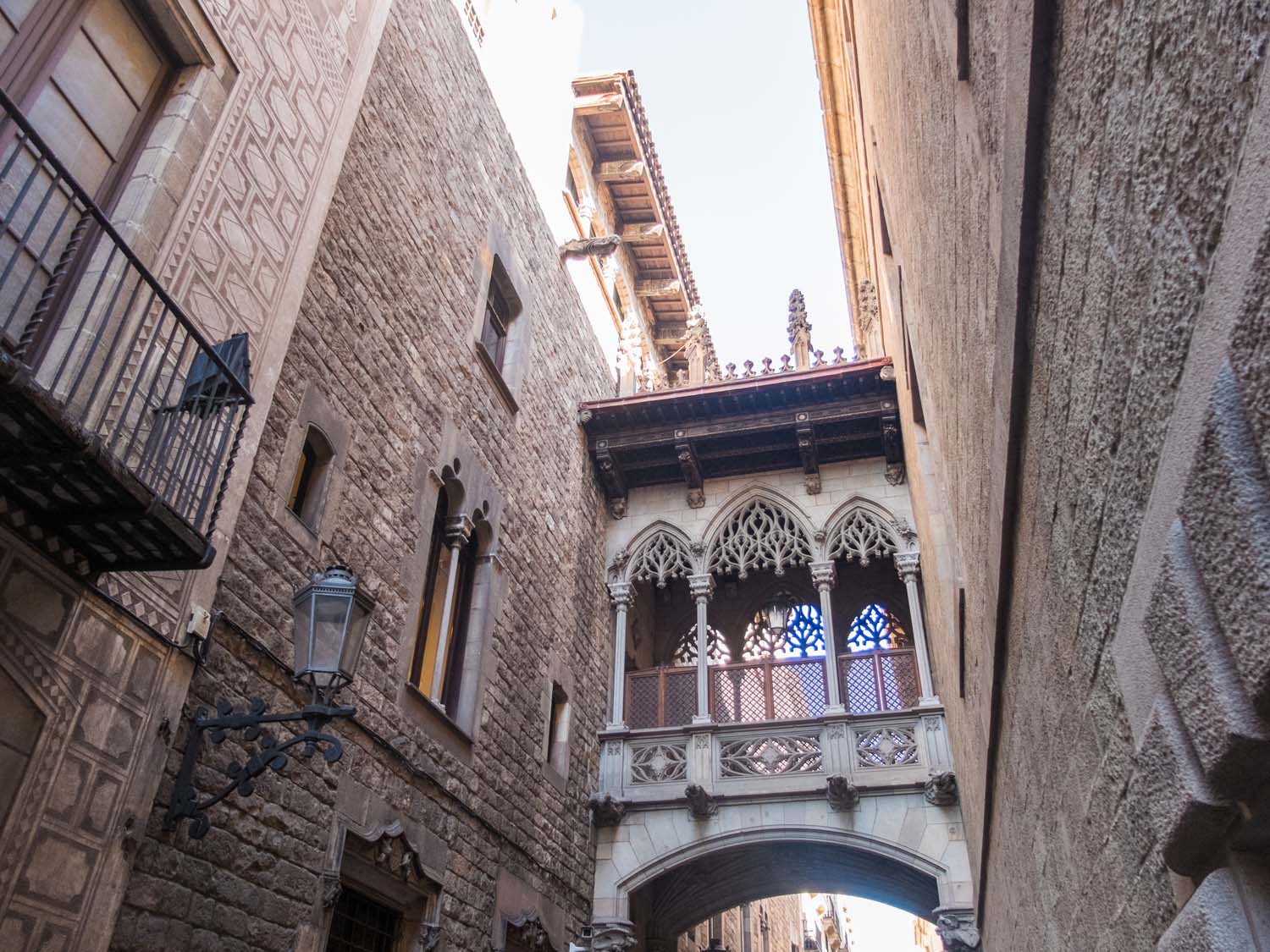
Every neighbourhood in Barcelona has a unique personality and appearance. It’s one of the things I love most about this city. Walking from district to district feels like entering a different world altogether with their own unique architectural styles to explore. From the modernista neighbourhood of L’Eixample to the bohemian streets of Gracia , you can really find it all. But perhaps one of the most interesting areas to explore in is the famed Barcelona Gothic Quarter or ‘Barrio Gòtic’. This part of town is where you’ll find cobblestone covered medieval alleys, towering neo-gothic spires and even ancient Roman ruins.
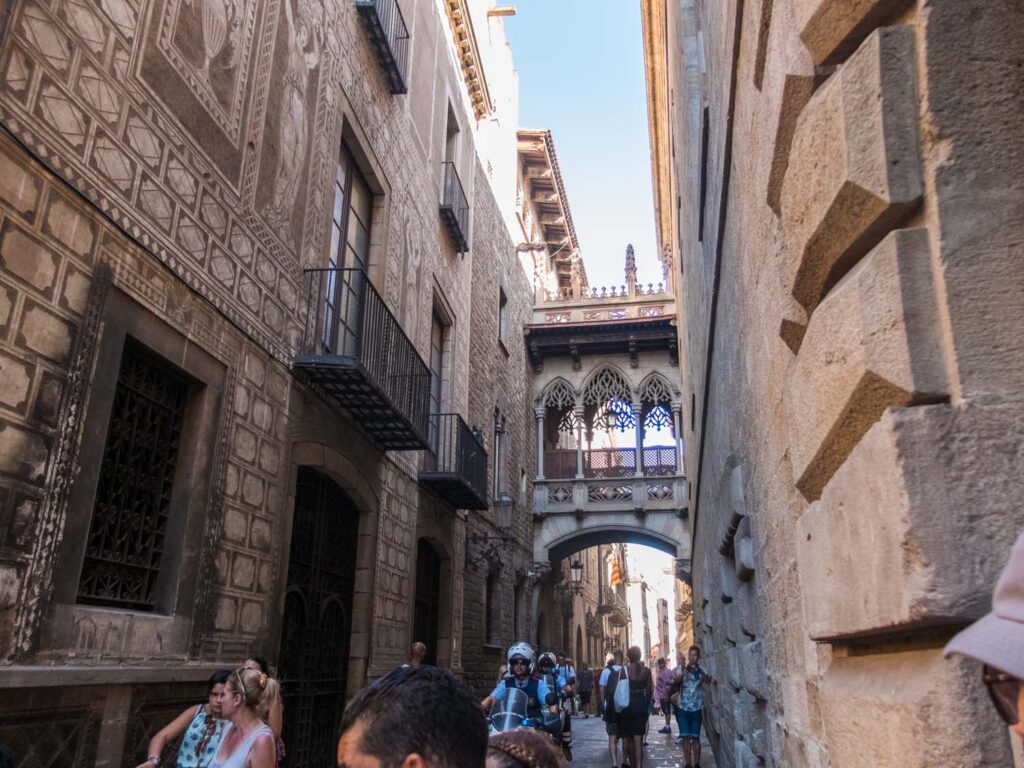
Despite the name “Gothic Quarter”, it’s important to know that most of these buildings were actually all built in the late 1800s through the 1900s in neo-gothic style. In 1929 there was a massive International Exhibition planned to take place in Barcelona. Wanting to jump on the tourist train, Barcelona decided to pour all their money into a massive restoration project. This project aimed to recreate the feeling of Barcelona in the medieval ages. They were inspired by European neo-gothic architecture and wanted to bring back some of their destroyed medieval histories.
While many of the sights might not date back to the early 13th century, I still think this neighbourhood is wonderfully charming and it contains some of Barcelona’s most important architectural structures. Plus, with these renovations, you do get the sense of what it would have felt like to explore Barcelona of the 13th century.
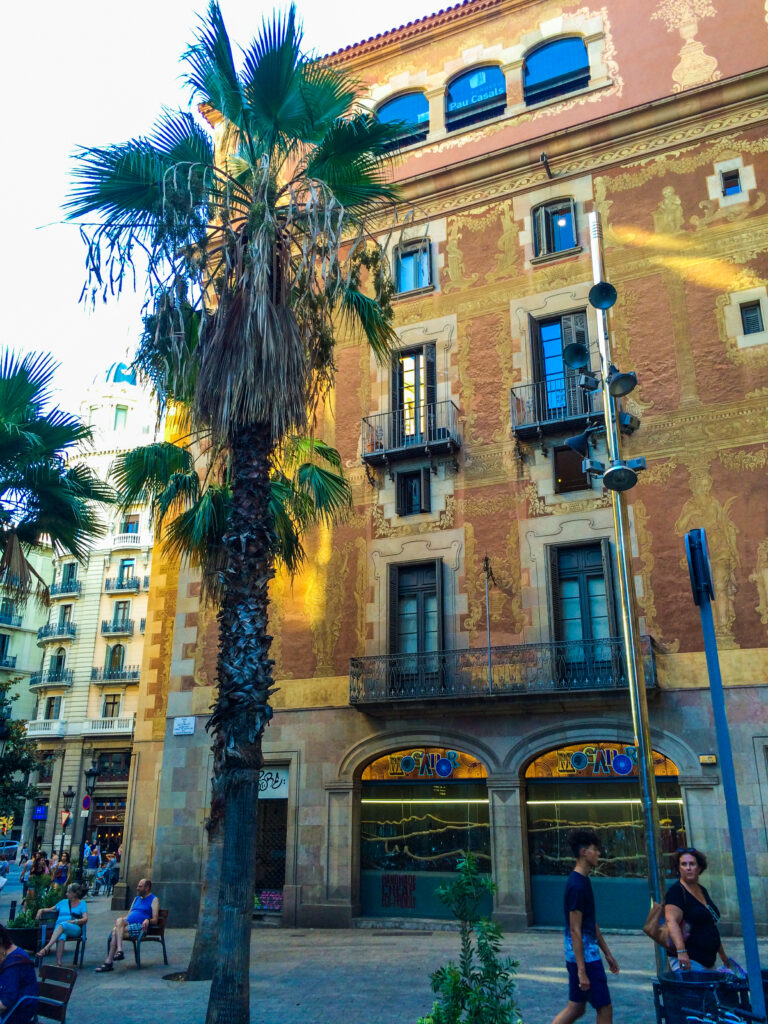
Layout of Barcelona
The neighbourhood retains its medieval labyrinth-like street layout. Most of these streets are still closed off from traffic, as they would have been before the invention of cars. When not overwhelmed with tourists, this vehicle-less area really adds to the ancient feeling of the neighbourhood. A walking tour is the best way to experience all the sights and sounds this place has to offer. Download the google map at the bottom of this post which plots all the different stops we’re going to make on our tour! Save as an offline map to follow along from point to point so you won’t miss a beat!
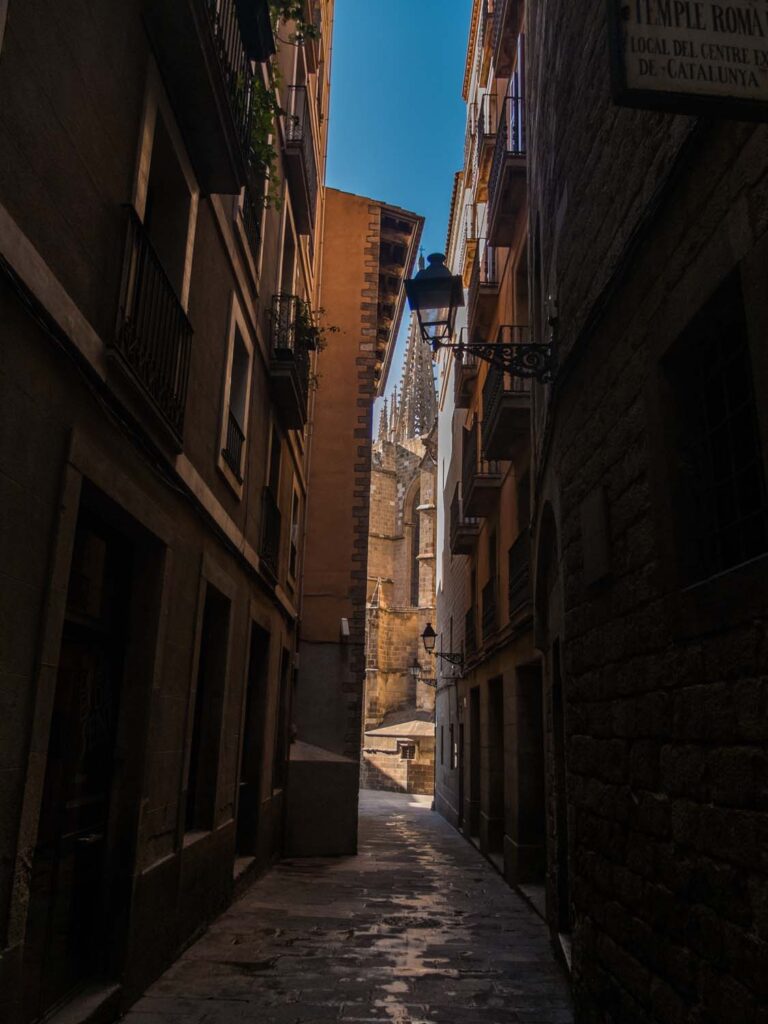
When to do this Tour?
The best time to take this walking tour is early in the morning. Since the area is so popular, it becomes overrun with tourists in the afternoon. There is just something about exploring in the early morning, when you have the entire place to yourself (trust me, I did it!), which feels absolutely magical. I would also try to avoid the weekends since they can be also a busier time to visit.
How to Get There
Our tour is going to start at the Plaça de Catalunya . To get there you can easily reach the square on foot if you are staying nearby. If you need to take transit, Catalunya is easily accessible from multiple lines of the metro, making it a great place to start the tour. Cataluyna Station is serviced by Line 1, 3, 6 and 7. Just take the metro to Cataluyna Station, hop off and follow the signs for Plaça de Catalunya .
Accessibility
Barcelona is heralded as one of the most wheelchair accessible cities in the world! In the gothic quarter, there are more bumps and hills than in the rest of the city, but with a powered chair, this shouldn’t be an issue. For more information on accessibility in Barcelona check out Cory’s blog ! The Gothic Quarter is fairly small, so although we may weave around these streets, we won’t be going a huge amount of distance.
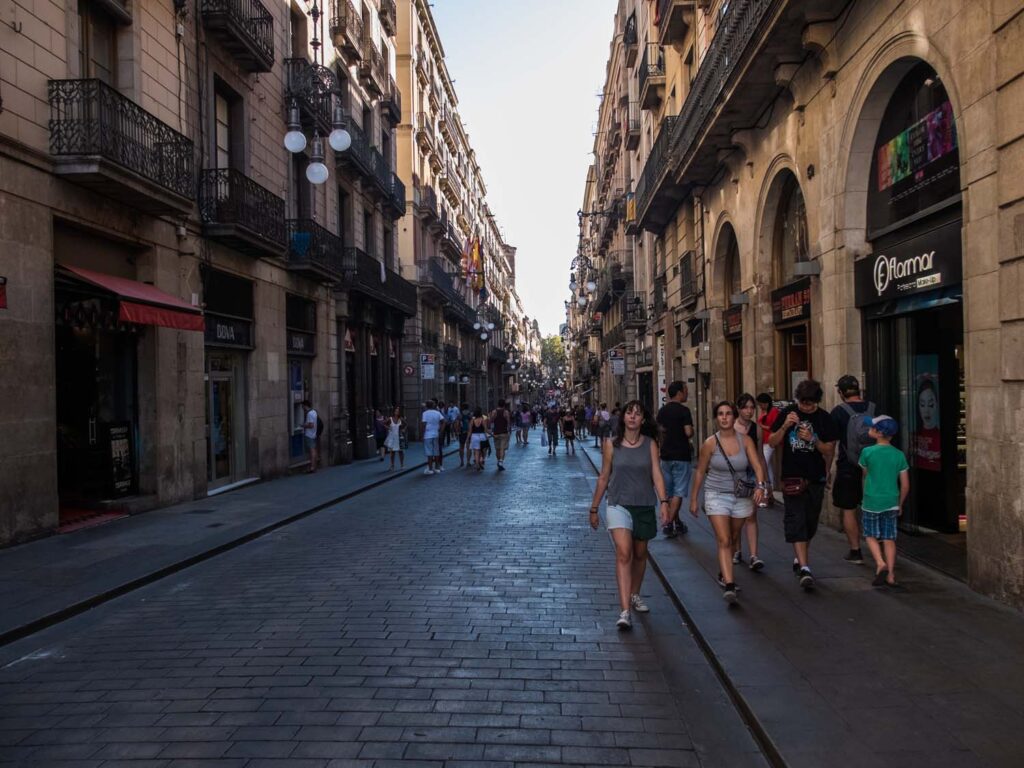
Plaça de Catalunya
The best place to start your tour is at the Plaça de Catalunya . The Plaça de Catalunya was built in 1927, just before the 1929 International Exhibition. It would be the central meeting point where people would gather from the moment it was inaugurated. Surrounding this plaza were the city’s most expensive and exclusive hotels, bar and theatres. Every builder was clamouring to get a piece of real estate around this square. It was to be the Times Square of Barcelona.
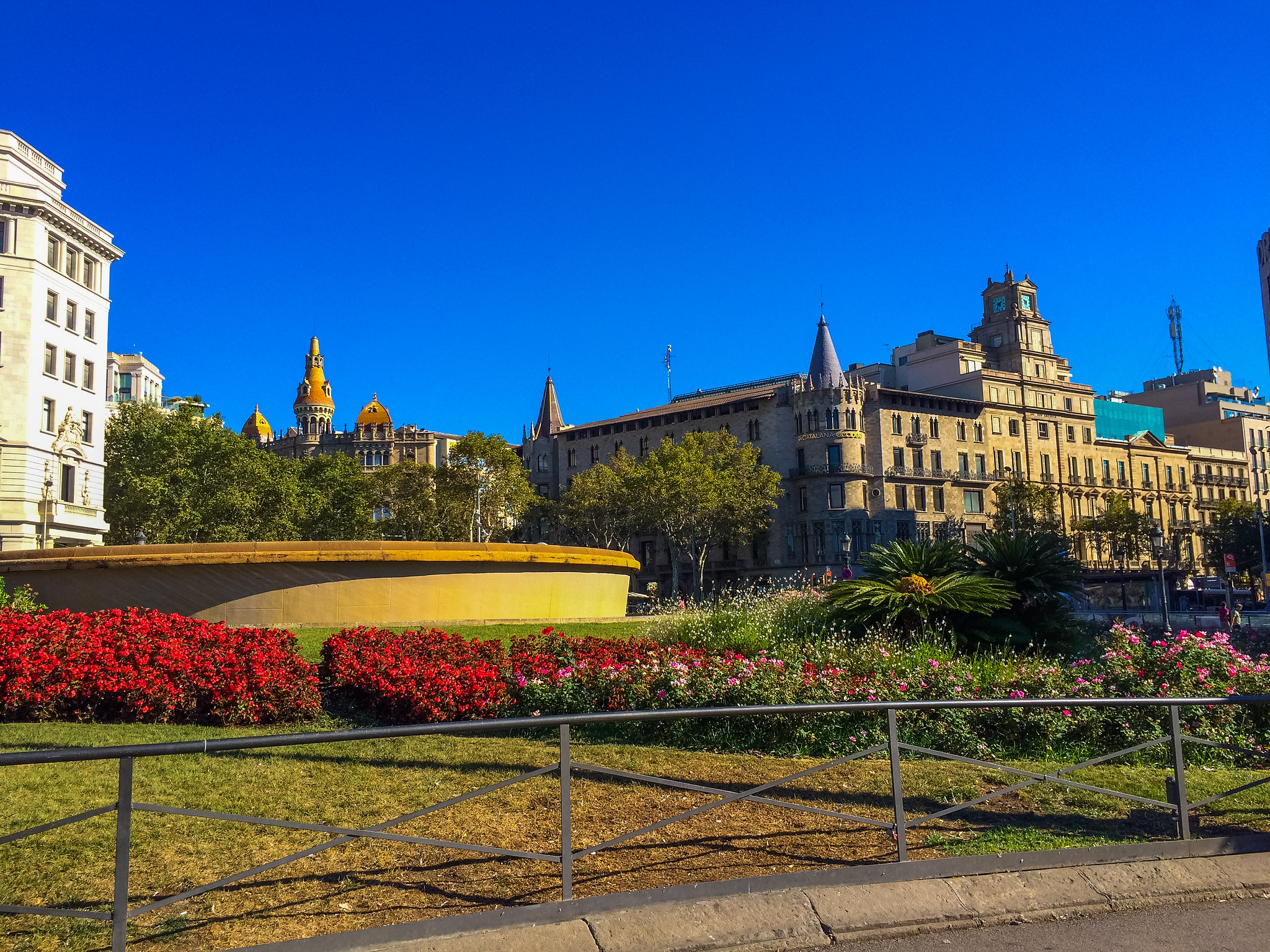
The enormous plaza covers 5 hectares of land and although it seems altogether too big, it almost NEEDS to be. Nine different major streets all converge together at this plaza. You can hear them zooming around you, like buzzing bees at all times of the day. This place is always packed with locals eating lunch, tourists taking pictures and street artists performing their act.
View this post on Instagram A post shared by Josep (@josepce2)
One of the nicest features of the plaza is the number of sculptures to be found surrounding it. It feels almost like an outdoor art gallery. One of the most impressive is Jose Maria Subirachs’ ‘ 1991 Monument to Francesc Macià ‘. It looks like two sets of stairs, one turned upside down atop the other. If you’ve already been to the Sagrada Familia , the name Subirachs will sound familiar. Subirachs was the designer who took over the Passion Facade of the great cathedral for Gaudi. The normal staircase represents Catalonia’s history while the upside-down stairs represent the dynamic future of the Catalonian people. Catalonians will always subvert and aim to be different than the rest of Spain and this sculpture exemplifies that nature.
View this post on Instagram A post shared by Toni Ayala (@toni_ayala_bcn)
Avinguda del Portal de l’Àngel
Move towards the southeastern corner of the square towards Avinguda del Portal de l’Àngel. The Portal de l’Àngel is a beautiful pedestrian street that leads you into the Gothic Quarter. It runs parallel to Las Ramblas and while Las Ramblas might be a little more touristy, Angel is as upscale as it gets in Barcelona. When the street was first established, it was the main hub for the fashion industry. Hundreds of textile stores could be found here. Women of the Spanish elite would come here to have the finest dresses of the day custom made for them. Nowadays, you can find some of the most expensive brands and department stores along this stretch which are still serving the elite of Barcelona.
View this post on Instagram A post shared by Sofía Oyarvide Frizzi (@frizzisof)
Santa Anna de Barcelona
Making your way away from the busy street down the Carrer de Santa Anna. Here, you’ll find yourself walking down a narrow shopping street. On your right, keep your eye open for an unassuming archway. This leads you towards one of the most underrated churches in Barcelona. Tucked in between a few residential buildings and almost lost in an overgrown forest of trees, this church doesn’t immediately look like much. But a step inside will reveal its hidden beauty.
View this post on Instagram A post shared by Ana Lucia e Jefferson viagens (@quersabereuamoviajar)
The church was founded in 1177 by the monks of the Holy Sepulcher. The monks travelled to Barcelona all the way from Jerusalem. It took over three centuries to build this monumental structure! Because of the length of time of the construction, you can find elements from a multitude of architecture periods. From Romanesque to Gothic and even bits from the Renaissance.
View this post on Instagram A post shared by Monica Martinez (@monica_marsal)
The most impressive part of this church is the 15th-century cloisters, designed in traditional gothic style. In the centre of the cloisters is a beautiful tropical garden with large palm trees and other seasonal plants. Monks would use these cloisters not just for quiet contemplation, but they would also grow many herbs and vegetables here to help cure and feed the sick and poor of the city.
View this post on Instagram A post shared by Pedro (@plbosque)
Els 4Gats , or ‘ The Four Cats ” is a gorgeous modernista cafe located just a few blocks away from the church. It opens as early as 9am and is the perfect place to grab a coffee in the most beautiful setting. The cafe was opened in 1897 and was once both hostel, bar and cabaret. This was where Barcelona’s creative community would gather to dance the night away! It’s been mythologized that Pablo Picasso and Ramon Casas i Carbó were both local patrons. These artists would call this place their home away from home. While the cafe can get very busy around lunch and dinner, if you’ve taken my advice and come to do this tour early then you’ll find this place almost all to yourself (Barcelona doesn’t tend to wake up till about 11 am).
View this post on Instagram A post shared by Juliana Font (@julesfont)
Font de Santa Anna de Barcelona
Continuing along, at the corner of Avinguda Portal de l’Àngel and Carrer Cucurulla you’ll find the Font de Santa Anna de Barcelona . A lot of people pass right by, but make sure you sneak by the cars and tourists to look at this piece of true medieval history. The fountain dates all the way back to 1356 and was originally used as a horse trough. In the 18th and 19th centuries, ceramic tiles were added on each side of the fountain depicting women carrying water jugs from the fountain.
On the front of the fountain is a stone carving of Barcelona’s coat of arms. The coat of arms is the version from the 19th century, with a large bat that flies over the crown. when the bat was removed from the coat of arms in the 1920s this was seen as a loss of an emblematic symbol shared by other capitals of the former Crown of Aragon.
View this post on Instagram A post shared by AssumptA (@suntacf)
Continuing along the Carrer dels Arcs you’ll suddenly come upon the large public square called ‘ Plaça Nova ‘. Plaça Nova sits in the shadow of the great Barcelona Cathedral and is almost always bustling with people. There is always something happening here! Whether its a festival, wedding, protest or just tour groups, there is a lively atmosphere here that just can’t be avoided. The Placa Nova was once one of the four main entrances to the Roman city. We can still see remnants of the original Roman city walls and two large romanesque towers surrounding the square.

Although there is some argument in the historical community about the date in which the square was established it is thought to be around 1358. In the centre of the square are the letters: “B a r c i n o”, which was the original Iberian village which was first founded here which would become Barcelona.
Pablo Picasso
Turn around to face the Architects’ Association of Catalonia building where you’ll find one of the largest pieces by Pablo Picasso . This enormous frieze was designed by the iconic artist but painted by his studio. If you’re lucky enough to be here on a Thursday, be sure to check out the Mercat Gòtic Barcelona which pops up in front of the church. Here you can discover some gorgeous antiques and relics from Catalonia! Even if you’re not interested in buying anything it’s a wonderful thing to just explore!
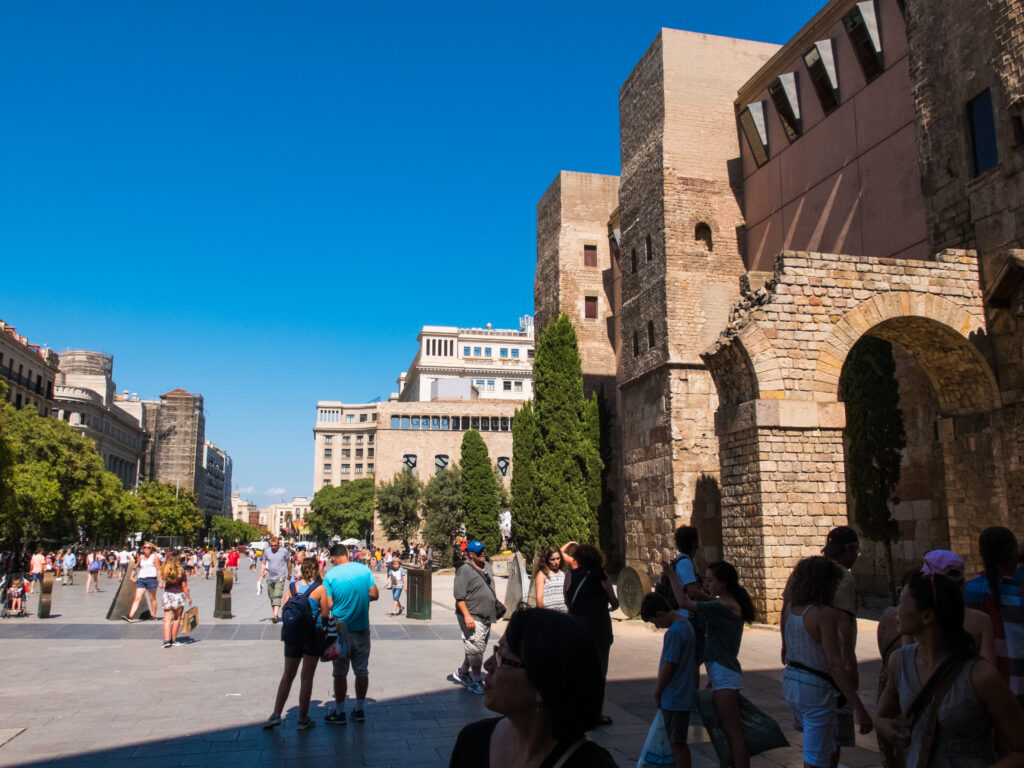
La Casa de l’Ardiaca
Inside the Plaça Nova, hidden behind the original Roman ruins, you’ll find the Casa de l’Ardiaca . The building has been the home of the Municipal Archive since 1921 but its history dates back to almost the 12th century! Before that, it was the headquarters of Barcelona’s Lawyers’ Association . Outside, you’ll see a modernista style mailbox designed by famed architect Lluís Domènech i Montaner . On it are three swallows and a tortoise, the symbols of the Spanish legal system. The birds symbolize the idea of freedom, whereas the slow bureaucratic procedures which can be such a big part of legal proceedings are represented by the tortoise.
View this post on Instagram A post shared by Como Mola Barcelona by Nacho (@comomolabarcelona)
Head inside the main courtyard to see the treasures that this, outwardly unassuming building has to offer. Inside you’ll find the “Salon des les pinyes” or ‘pineapple salon’. Here you can admire the gorgeous central fountain and palm tree, growing inside the building. The surrounding cloisters are covered in colourful tiles and oldest looking walls in here date all the way back to the Roman era.
View this post on Instagram A post shared by Bajo el☀️de la Toscana🌻 (@silviaenitalia)
Cathedral of Barcelona
Continue walking across the square until you reach the doors of the great Cathedral of Barcelona . If you aren’t interested in going inside, just gazing upon the exterior is well worth your time. This monument to architectural majesty began construction in 1298 but wasn’t completed until 1420! The church is dedicated to Saint Eulalia of Barcelona. Eulalia was attacked by Roman soldiers in the square for her Christian beliefs and stripped naked in front of a horde of people. She was ashamed but in the middle of the summer, it began to snow, covering her naked form. Unfortunately, this only enraged the roman soldiers more and they threw her in a barrel, stabbed the barrel with knives and rolled her down the street. The street they preformed this torture upon her, now bears her name.
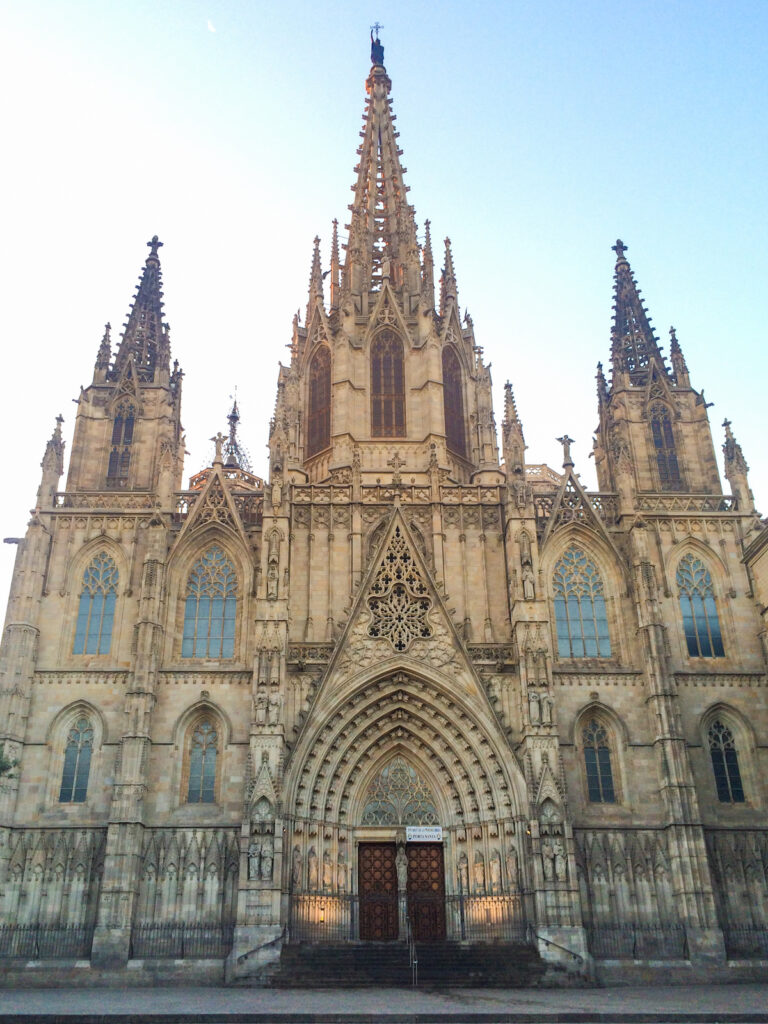
Her sad but powerful story is one which stuck with the people of Barcelona and this church was built in her name. Inside you can still see her chapel which holds her elaborate sarcophagus. This church helped inspire Gaudi’s design of the Sagrada Familia, so seeing this gothic masterpiece is the perfect complement to understanding Gaudi’s vision. For a complete tour of the Cathedral of Barcelona click here !
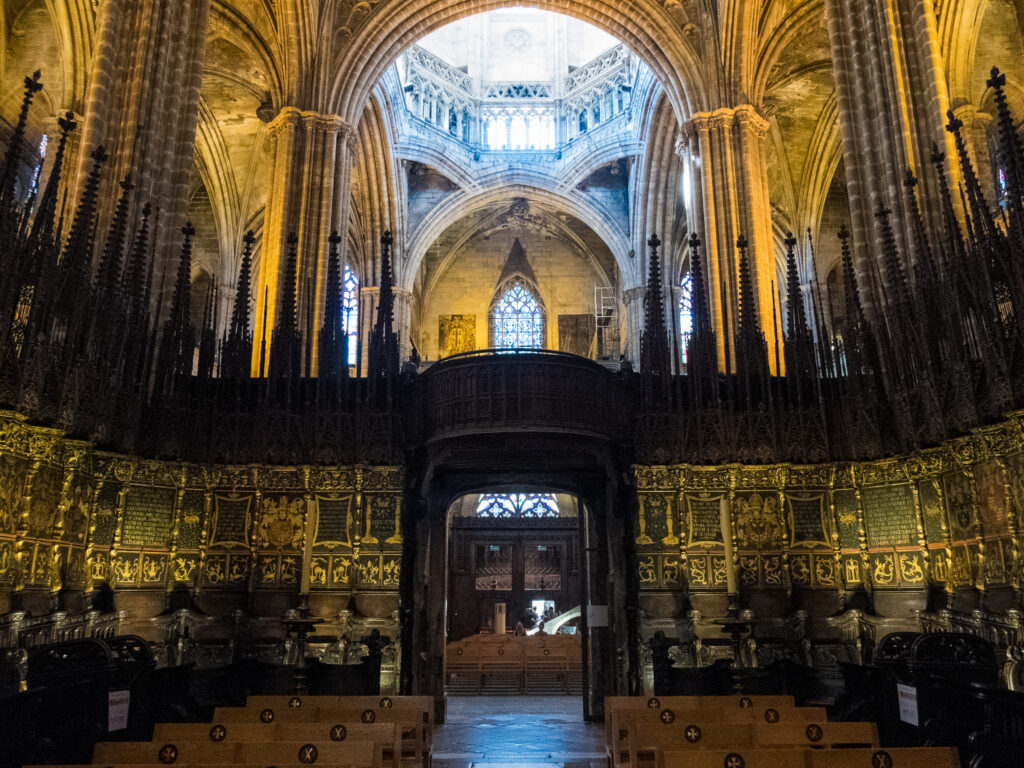
Monument to the Heroes of 1809
Exit the church, via the side exit in the cloister, where you’ll come out into a small courtyard. In the centre of the courtyard, along the wall, is a large arch with a beautiful sculpture nestled underneath. This stunning modernist sculpture is dedicated to the ‘ Five martyrs of Catalan Freedom ‘. During the French occupation of 1809, these five men rose up in an attempt to free the city from the Napoleonic troops. Unfortunately, their plot failed but their memories live on in the hearts of the people of Catalonia.
View this post on Instagram A post shared by Barcelona Lowdown (@bcnlowdown)
The moment sculptor Josep Llimona captured was a quiet moment. He uses a realist style of sculpture, to capture the moment just before they were executed. They sit in solemn contemplate, one of them comforting the other. Above their heads are a choir of angels made by sculptor Vicenç Navarro . One of the angels leans down, to crown their heads with a laurel wreath, the symbol of victors. The difference between the more realistic look of the heroes and the art nouveau style of the angels, with curved lines and exaggerated features, easily conveys the difference between the earthly and heavenly plane.
Carrer de Sant Sever
The Carrer de Sant Sever is one of my favourite streets in the Gothic Quarter. The alley is super narrow, and the buildings on either side seem to almost lean in towards one and other, making the street extremely dark and moody. Which let’s face it, just adds to the wonderful “gothic” feeling of the neighbourhood.

Plaça de Sant Felip Neri
Continue down the Carrer de Sant Sever and turn up the small side street Carrer de Sant Felip Neri. This leads you towards the Plaça de Sant Felip Neri . Walking into this small, quiet square, the first thing which grabs your eye is the huge stone walls. Upon closer inspection, you’ll notice they are covered in holes.
In 1937, bombs were being dropped by fascist troops into this square which resulted in the death of 42 people, 20 of whom were children. The church located in this square had an adjoining school which was an unfortunate victim of these attacks. The holes on the walls still mark this deadly event, left unrepaired so that the event is never forgotten. When I visited, a child and his father ran playfully around the square. There was something both happy and sad about seeing this little scene play out. Happy to see children’s laughter persist here but sad to imagine all those children who lost their lives.
On the northern wall is the old 17th-century baroque church of Felip Neri. Felip (of Philip) Romolo Neri, was the Second Apostle of Rome, after Saint Peter. A statue of Felip Neri in the center niche about the doorway.
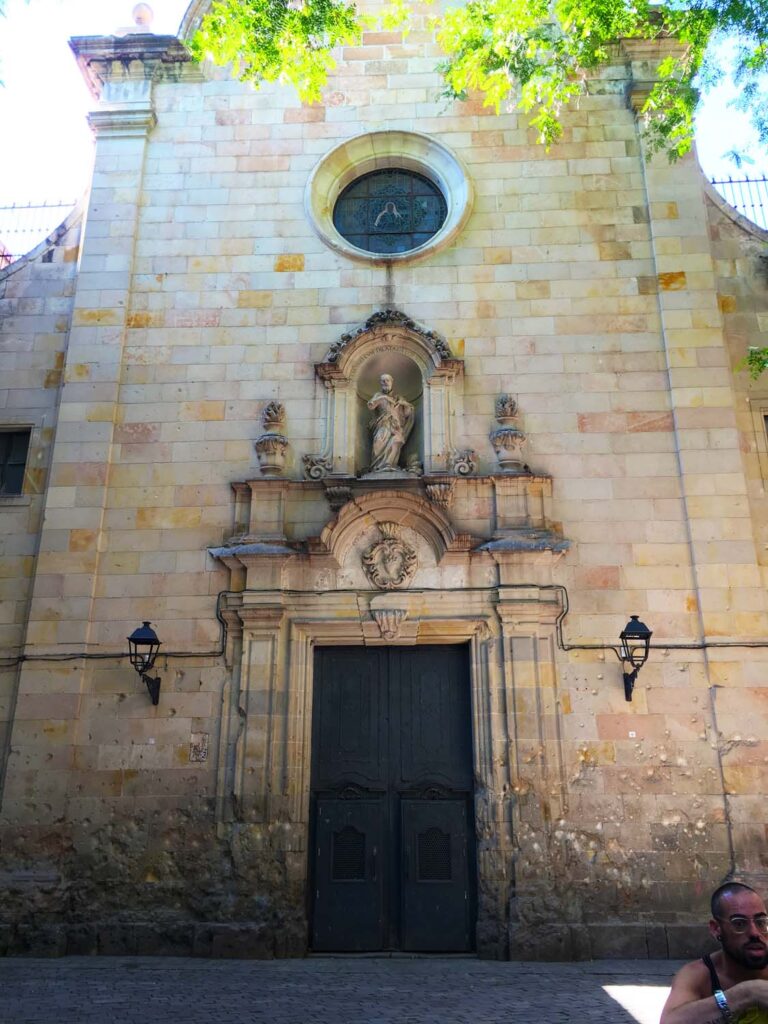
Carrer de Salomó ben Adret
Opposite the church is the oldest building in the square, which is from the Renaissance period. This stone building is notable for its two ancient wrought-iron balconies and a stone relief of a lion in the center. This was once the headquarters of the shoemaker guild and now houses the Barcelona shoe museum .
Head back out down the Carrer de Sant Sever and turn down this tiny, almost hidden alleyway, Carrer de Salomó ben Adret . These little alleyways are one of the best parts of the Gothic quarter. They seem to pop out of nowhere and even when you think they might not lead anywhere they’ll open right up to a huge square.

Bistrot Levante
The Bistrot Levante is located inside one of these tucked away squares and is the perfect place to sit outside and enjoy an afternoon lunch. Their modern approach to Lebanese food might seem like an odd choice for visiting Spain but trust me, this place is wonderful!
View this post on Instagram A post shared by Travel & Lust (@travelandlust_)
Pont del Bisbe
Head back out onto the Carrer de Sant Sever turning east onto the Carrer del Bisbe. As soon as you turn the corner, your eyes will be met with the sight of this fantastical gothic bridge which adjoins the two buildings on either side of this narrow street. This is known as the Pont del Bisbe or Bishop’s Bridge . It was created in the 1920s to connect the Parliament buildings to the presidential residence. But it was named after the Bishop of Barcelona who instigated its constitution as a means of escape from the parliament buildings should there be a political coup.
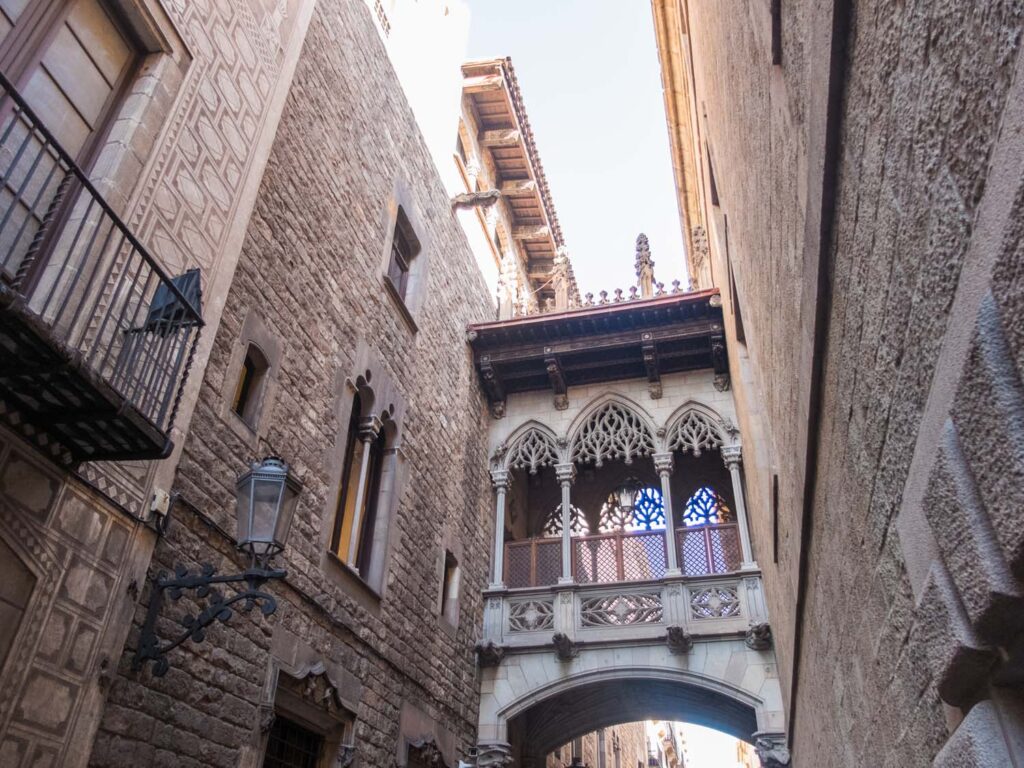
The intricate patterns of stonework beneath the arches make the bridge look like a delicate piece of lace. Passing under the bridge you get the strange feeling of being watched as the eyes of the various gargoyles, which jut out from the bridge, look down on you. The bridge was designed by Joan Rubió i Bellver , the apprentice to Antoni Gaudí! Today this is one of the most popular places to get your picture taken in the Gothic quarter, despite the bridge being a product of the 20th century. When you walk under the bridge make sure to make a wish as is the popular tradition!
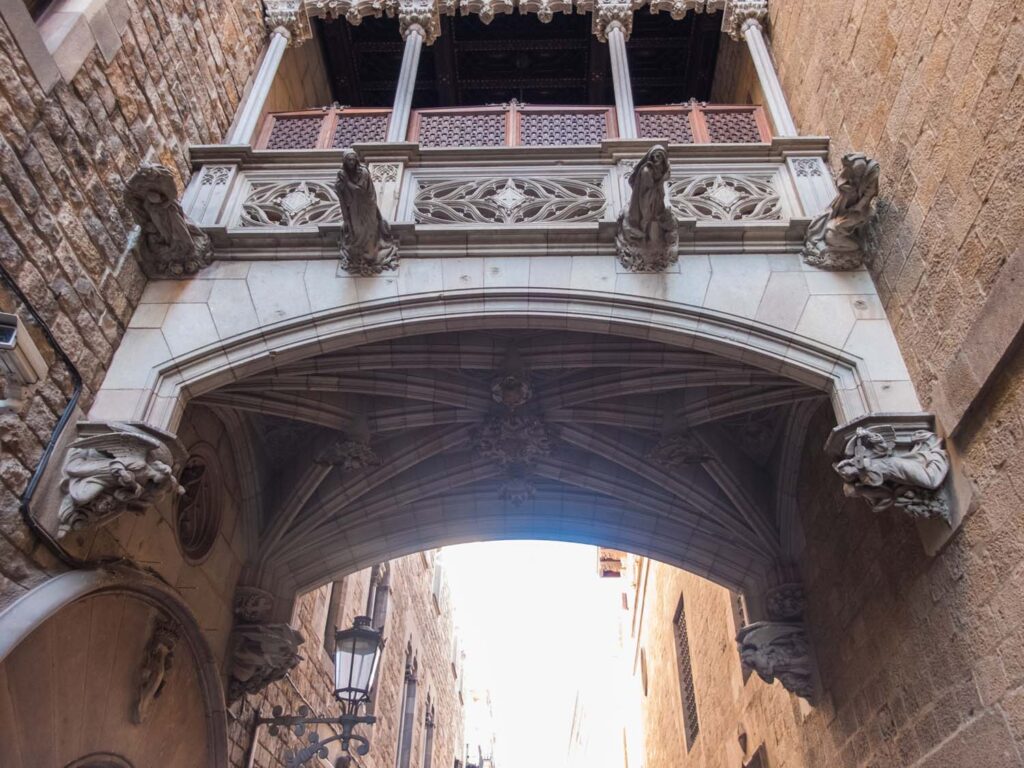
Statue of Saint Jordi
After getting your photos and walking under the bridge, take a few steps forward and look up at the wall to your right. Along the top of this facade is a gothic medallion and in the centre a small statue of Saint Jordi. This was made in the 15th century by Catalan sculptor Pere Johan. The legend of Saint Jordi in Catalonia goes a valiant knight went to rescue a princess from a ruthless dragon. When he plunged his sword into this belly, a rose bush grew from the dragon’s spilt blood.
Saint Jordi then plucked a rose from the bush to give to the princess to further win her heart. In Barcelona, every year on April 23rd they celebrate Saint Jordi day, which for them is the holiday of love, similar to the North American Valentine’s day. On that day lovers exchange roses and books to show their love for one an another just like Saint Jordi did for the princess
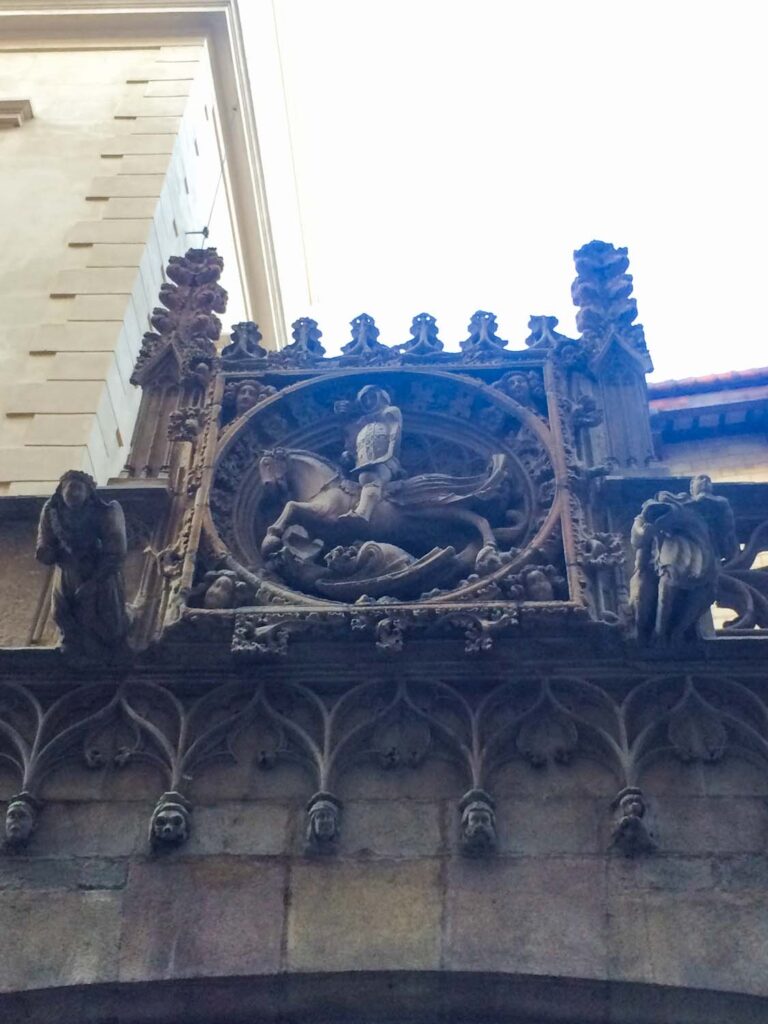
Cases dels Canonges
Instead of walking to the end of the street, turn back around to walk down the Carrer de la Pietat . This small street takes you behind the great Cathedral of Barcelona and along the Cases dels Canonges , or House of the Canon . This 14th-century group of buildings was transformed into the residence of the President of Catalonia in the 20th century. Because the building was once multiples residences, you’ll see a myriad of architectural designs along the facade, from Renaissance, to Gothic and even a touch of Baroque.
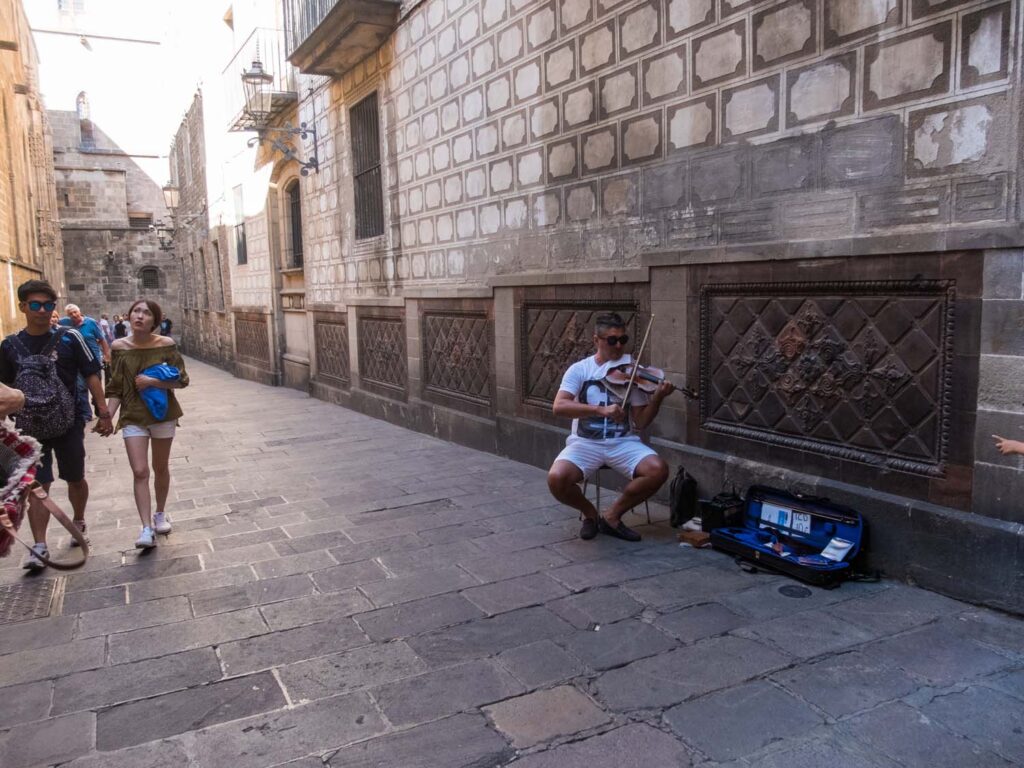
The main facade you’ll see as you turn the corner on the Carrer de la Pietat is the Renaissance facade with its tromp d’oeil patterns which were made with stucco to give the appearance of three-dimensional stones. On the second floor facade, you can see these beautiful stucco paintings of Grecian of women carrying baskets of flowers on their heads. No doubt in a wealthier home these would be carvings set into niches, but here you get the same effect at a fraction of the cost! How frugal the owner must have been.
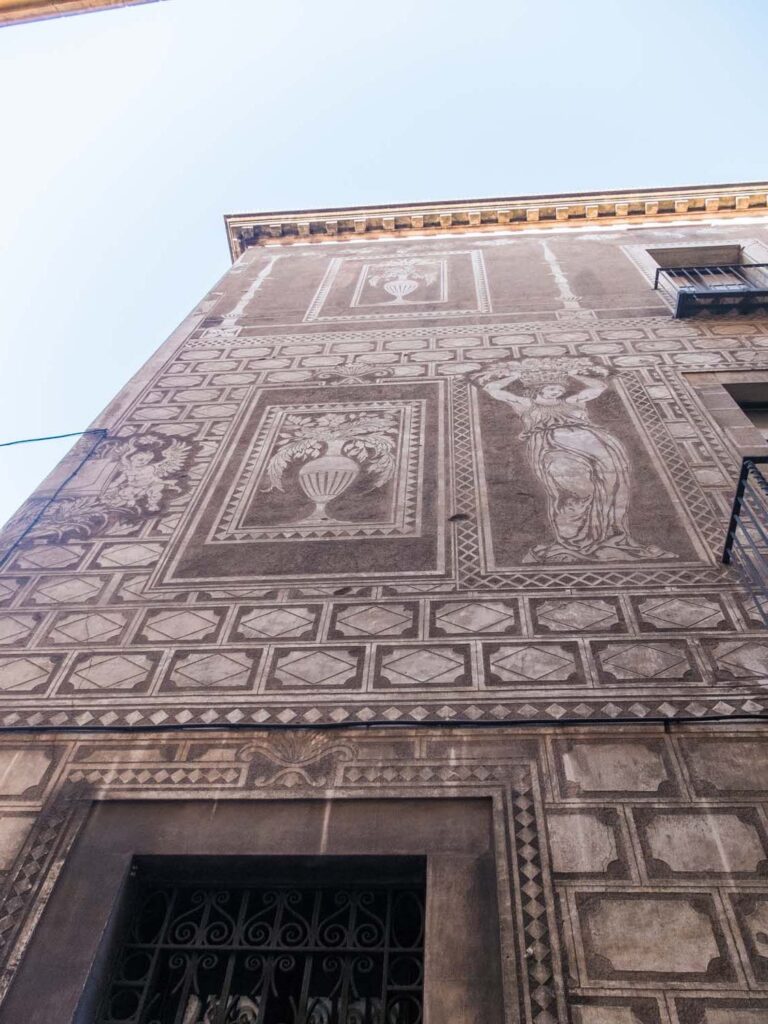
As you round the corner along this small side street, look at the church doors on the corner. This side entrance is no longer frequented but has still been given beautiful adornment. Above the huge archway is powerful portal depicting the Pietat; mother Mary holding her dying son in her arms after taking him down off the cross. The moving carving was so important that it is what gives the street its name.
View this post on Instagram A post shared by Sandra 🌈 (@sandracat11)
As you round the corner you’ll be able to see, in this tiny courtyard, the entrance of the of Cases dels Canonges. Above each of the windows on this side are stone carvings of medieval heraldic symbols from the 15th and 16th centuries. This building is now used as the Department of Foreign Affairs.
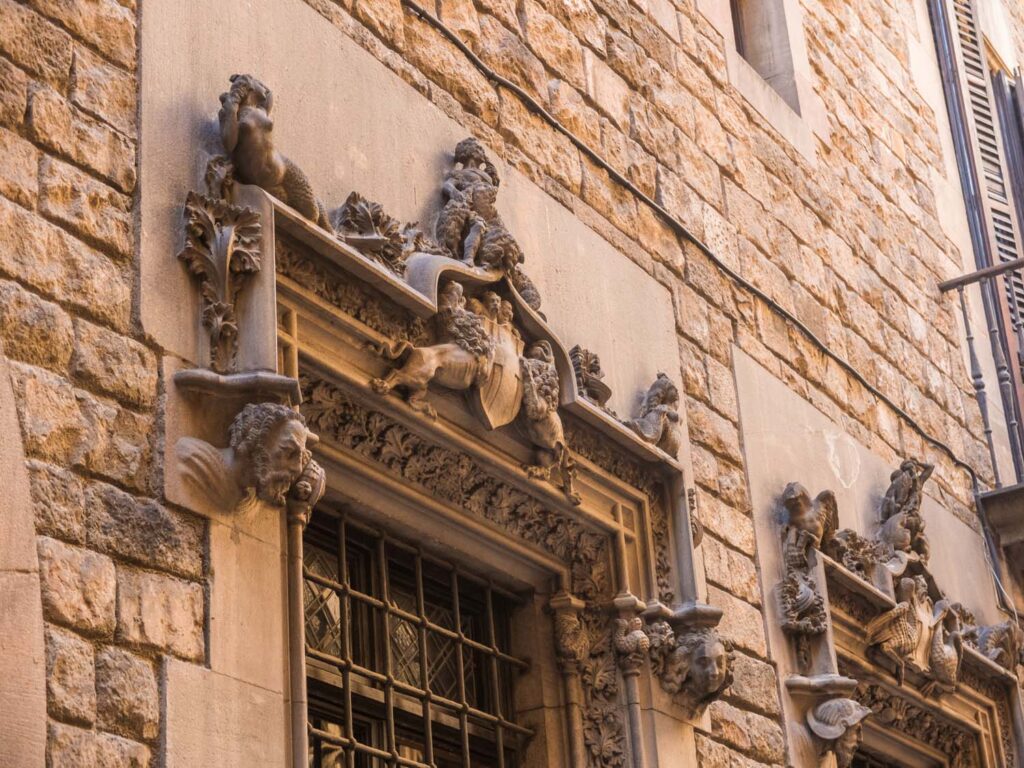
Temple of Augustus
Keep straight and walk down the small Career del Paradis. This secretive, almost too narrow alley, leads you straight to the Temple of Augustus . This unassuming building is marked only with a dull piece of signage on the outside but head straight into the inner courtyard to find an impressive discovery! This medieval building, with its mint green walls, holds within it four incredible Corinthian columns. These columns are the last remaining piece of Barcelona’s Roman history. The Roman temple which once stood here was dedicated to Emperor Caesar Augustus, giving the remains the name, Temple of Augustus .
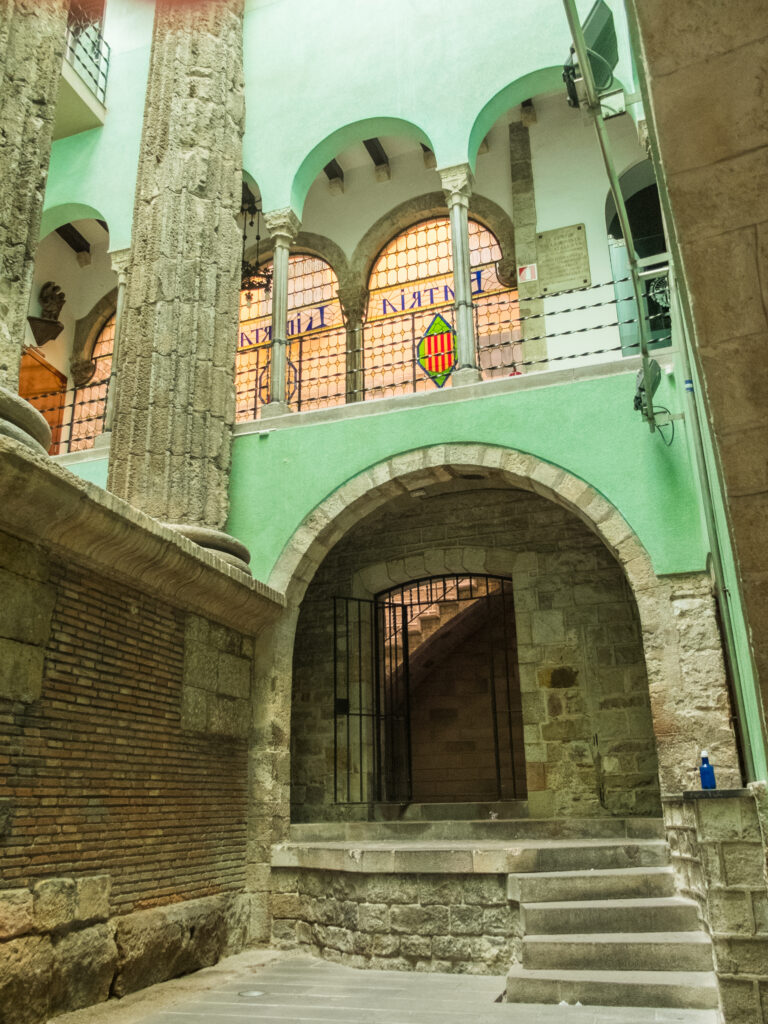
Craft Barcelona
This tucked-away alley is another great place to get something to eat. Craft Barcelona is a wonderfully hip and charming hidden gem. They have some of the best tapas, service and, unique for Barcelona, they specialize in craft beers from all over Spain! (But you can still get a killer sangria and cava here as well)
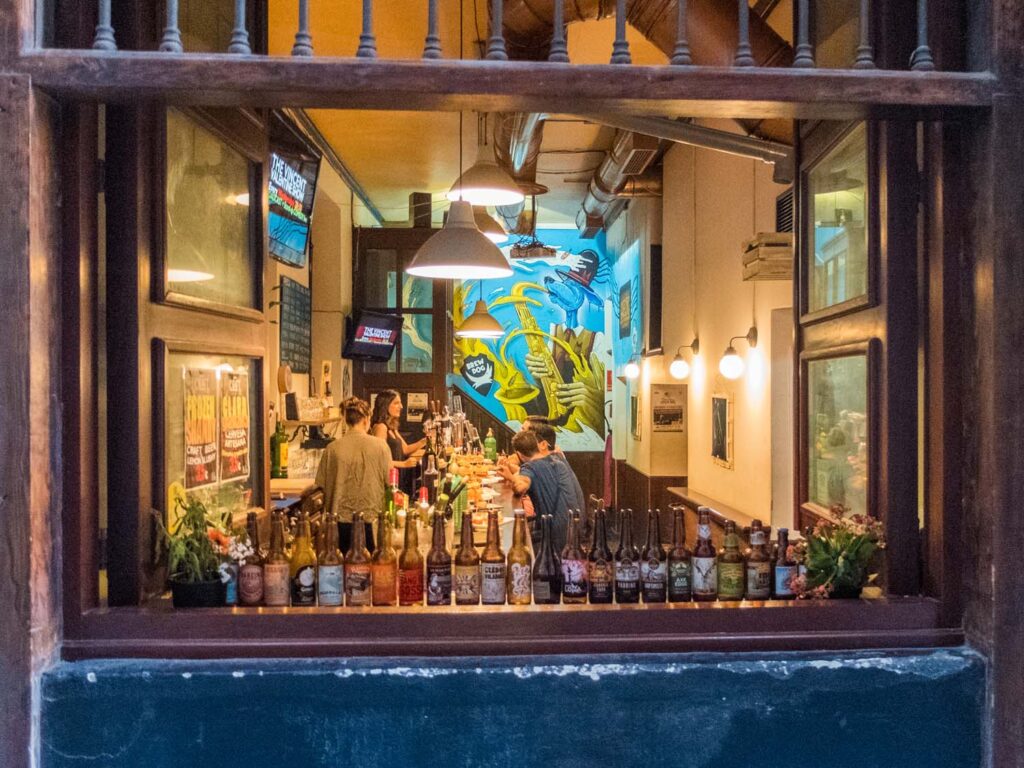
Plaça de Sant Jaume
Just opposite the tiny street of Carrer del Paradis is the grade square called Plaça de Sant Jaume . This huge, black bricked square is surrounded on all sides by various important historical buildings. They call this square the “political beating heart of the city”. It’s here that the city’s government has been run for centuries. Even during Roman times, Placa de Sant Jaume was the meeting point of two of their largest junctions, meaning it served as the major meeting point in Barcelona. The square was named after the old Church of Sant Jaume, which stood here since the 14th century but was demolished in 1823. Even so, the square keeps its name in her honour.
View this post on Instagram A post shared by Manuel Rapetti (@manuelrapetti_)
Palau de la Generalitat
Today, the square is where you’ll find the Parliament of Catalonia or the Palau de la Generalitat . This is one of the few medieval buildings to remain in the gothic quarter. The Palace was built in 1283 to hold the Catalan Assembly and was the first parliament building in Europe! Here, just as hundreds of years before, is where the seat of government sits. Above the large, archways into the buildings, is a statue of St. Geroge slaying the dragon. Inside, is a chapel also dedicated to the saint. The chapel’s exterior runs alongside the Carrer del Bisbe, where we saw the Saint Jordi sculpture near the Bridge.
It’s a real shame the building isn’t open to tourists as the interior features some incredible gothic architecture and a Renaissance courtyard with beautiful orange trees and other native Catalan plants.
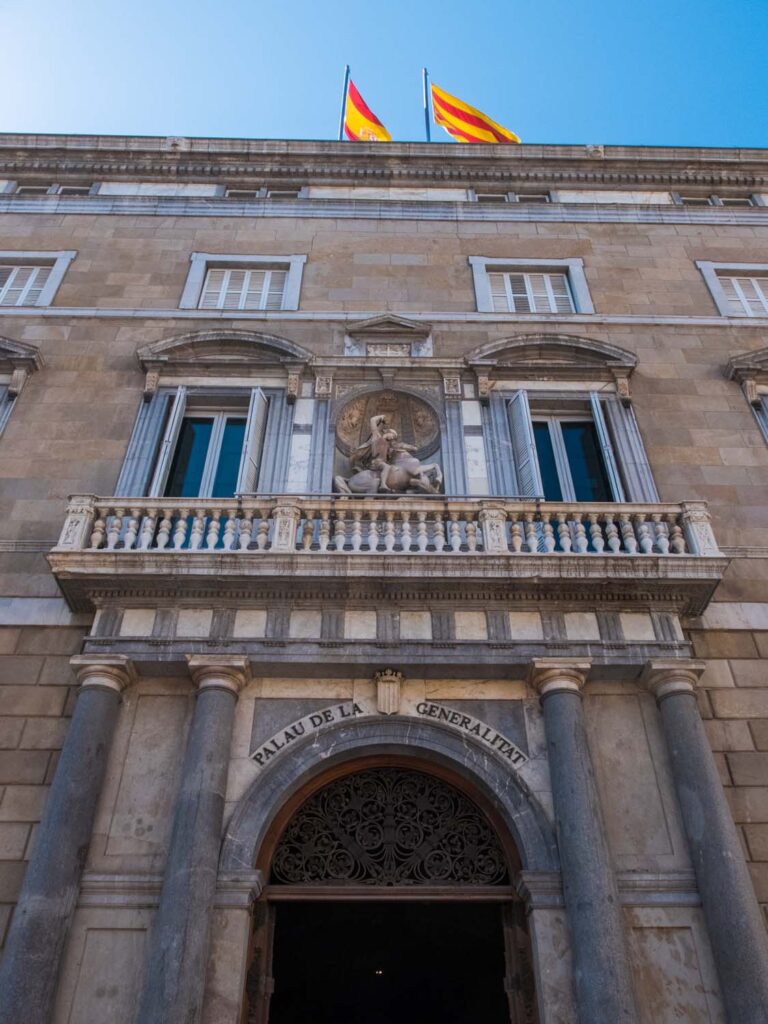
Barcelona City Hall
Opposite the Palau de la Generalitat is the grandiose Casa de la Ciutat, of Barcelona City Hall. It features a rather austere neoclassical facade but inside is replete with gothic architecture exemplifying Catalan national pride. On either side of the archway entrance are the statues of King Jaume I, who founded the original city council, and Joan Fiveller, a significant member of the council who advised the king.
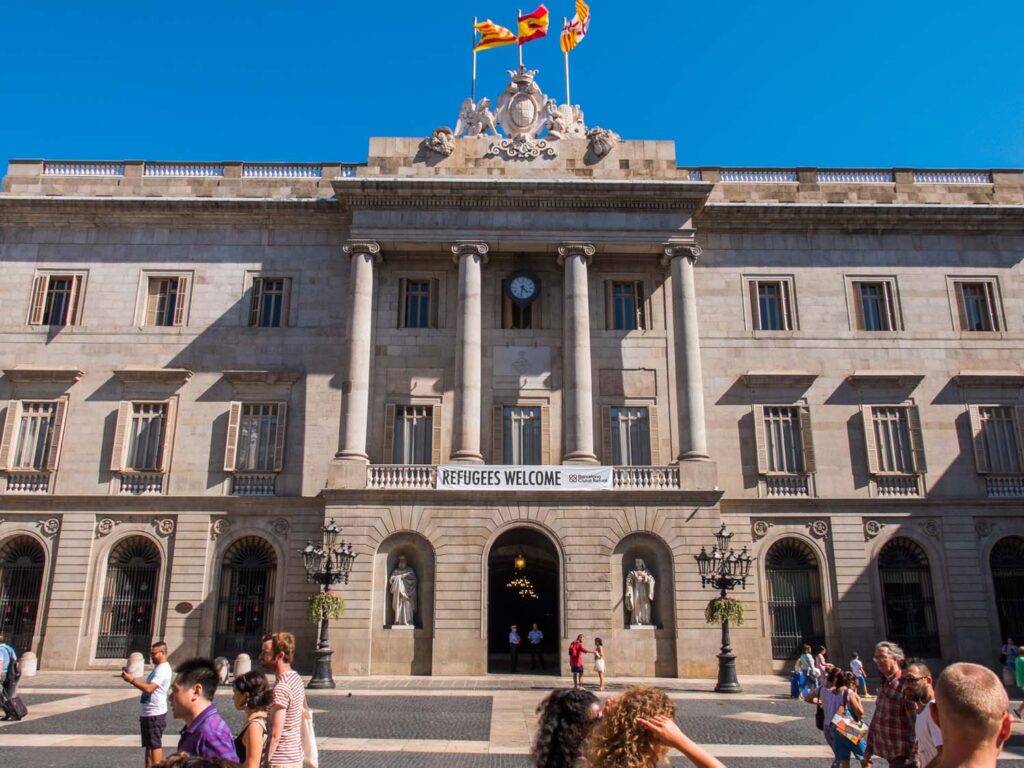
You can walk inside, where you’ll find the Barcelona Tourism office, to get a peek at some of this amazing old architecture. You’ll enter into the great Gothic staircase with sculptures from Gargallo, Llimona, Navarro, Subirachs, Marès, Miró and Clarà dotting the interior. It’s pretty amazing to find artist work of this calibre just out in public spaces for everyone to enjoy.
View this post on Instagram A post shared by Eugeni 📷📱🚵🏼♂️ 🧘🏽♂️ (@eugeni___)
Plaça de Sant Just
Opposite city hall walk north along the Carrer d’Hèrcules towards the Plaça de Sant Just . This quiet square is home of the Basílica dels Sants Màrtirs Just i Pastor. The alleyway leading you into this square feels so narrow that when it opens up it’s like taking a breath of fresh air. I think it’s amazing when architecture can give you a feeling like that.
View this post on Instagram A post shared by Begoña NB (@jamaioni)
Basilica of Saints Justus and Pastor
Standing guard over the square is the great Basilica of Saints Justus and Pastor . Look up the portal above the central doorway. Two tiny angels kneel in prayer on either side of the Virgin Mary who sits on her throne between them. The 14th-century church is rumoured to be even older, and perhaps built up from an older church as far back as the 4th century! This would make it the oldest church in Barcelona, but alas historians are still squabbling on the details. It’s a shame the church is usually closed as the interior houses some of the most fantastical chapel carvings and stained glass! So if the doors happen to be open, don’t miss the opportunity!
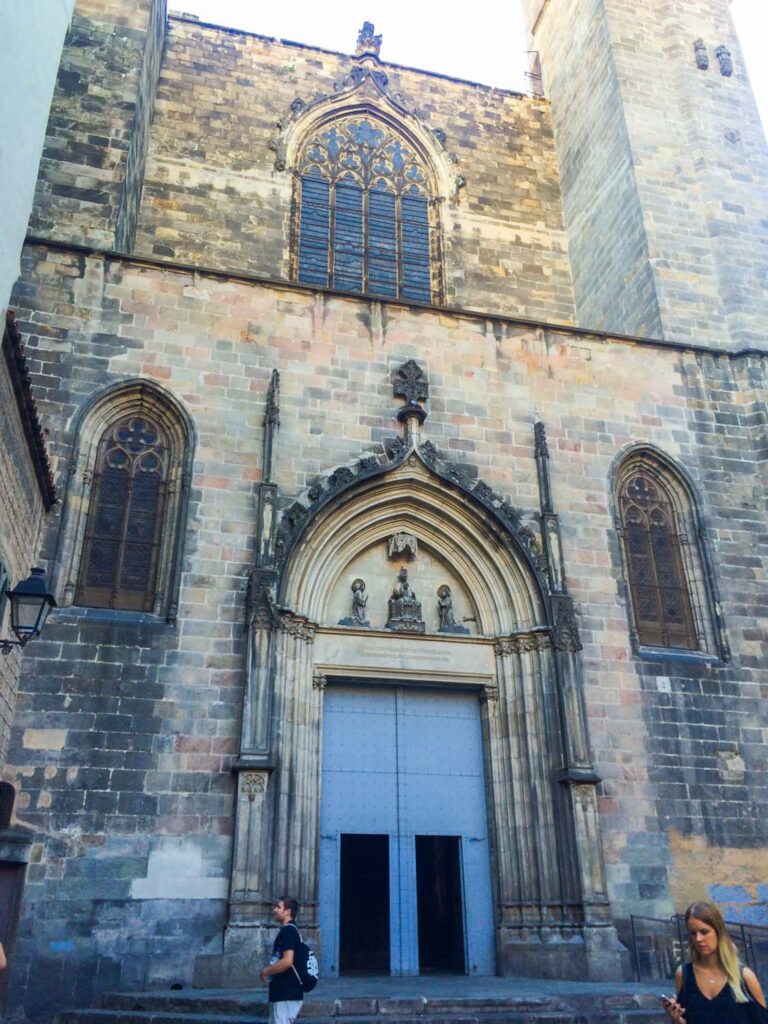
Font de San Just
There is a small water fountain in the corner of the square which looks pretty unassuming to take a closer look. At the bottom of the fountain are three carved heads with their mouths open. In between the carvings are water faucets. Although the faucets and the carvings are new, the source of the water is the oldest in the city. Giving credence to the thought that the church here might date back to the founding of the city since important buildings are often situated near water sources.
View this post on Instagram A post shared by @arguezrh
Plaça del Rei
Continuing back towards the starting point of the tour, walking along the sidestreets of Carrer de la Dagueria to the Carrer del Verguer, which leads into the Plaça del Rei . This square is surrounded on all sides by some of the most authentically gothic and medieval buildings of Barcelona. Their overwhelming presence is one of the reasons this part of the city gets the name “Gothic Quarter”.
The wide, regal steps lead up towards the Palau Reial Major, or old Royal Palace. Rei, means King in Spanish, as this was the courtyard of the King. The palace was the main residence of Catalan Kings and Queen from the 13th to 15th centuries but was used as a non-royal residence as far back as the 11th century. Because the building is so old, you can make out old Visigothic and Romanesque features although the dominant style is that of the high gothic. Standing guard above the square is a rectangular tower, complete with a multitude of arched windows. This was King Martin’s Watchtower, built in the 15th century.
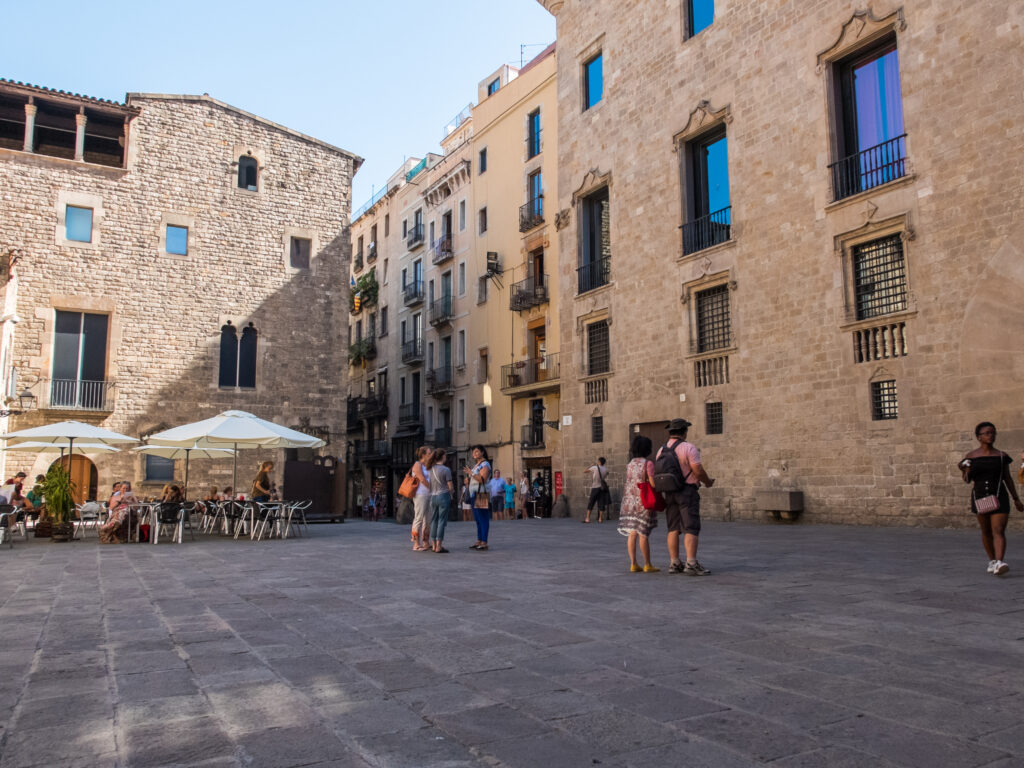
Palau del Lloctinent
The building opposite the palace is the Palau del Lloctinent , or Lieutenant’s Palace. This 16th-century construction hides inside it one of the most heavenly gardens. Set against a sea of golden yellow stucco, you’ll find an old renaissance courtyard covered in green ivy flourishing plants. Today, this building houses the Archive of the Crown of Aragon .
View this post on Instagram A post shared by Konstantinos Papadopoulos (@kwstaspap83)
This is a great place to end the tour. If you want to relax there are dozens of cafes nearby with gorgeous views of the Gothic Quarter to enjoy as you sip your cava. Or if you’re still up for more you can visit the Barcelona History Museum to learn even more about the history of this great city!
Hopefully you’ve enjoyed this tour as much as I enjoyed wandering the beautiful street, learning as much as I could to share with you all! What was your favourite part of the Gothic Quarter or did you find any secrets I didn’t share along the way? Let me know in the comments! I love hearing from readers.
Happy Travels Adventurers
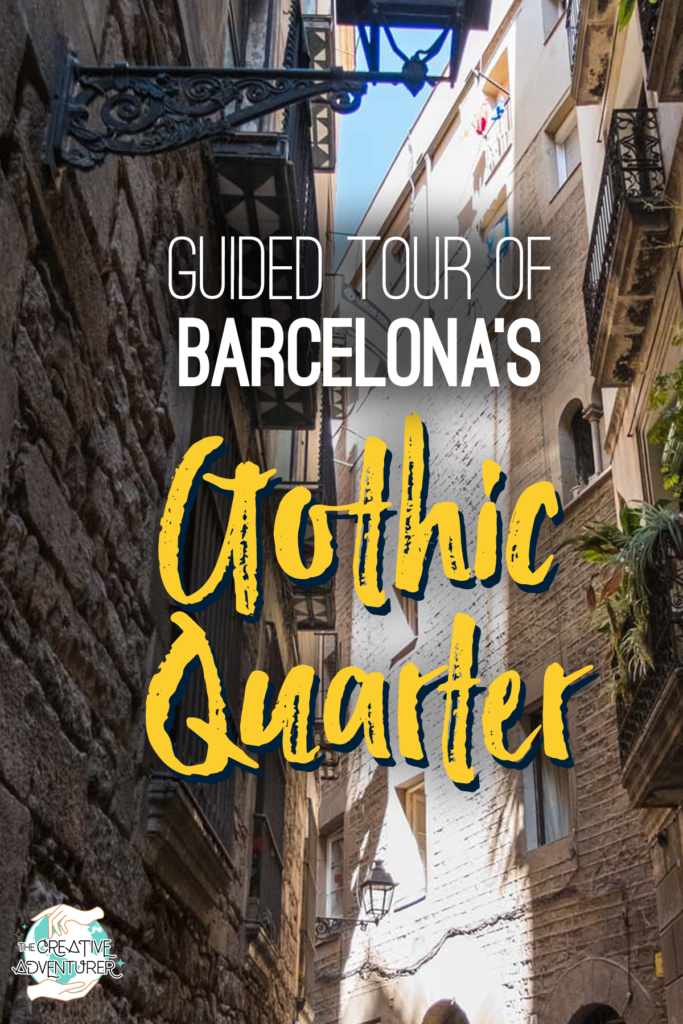
« That Time I Almost Missed My Flight at Christmas and What I Learned!
Experience the magic: your ultimate guide to visiting the wonderful wizarding world of harry potter in hollywood, california », you may also like.
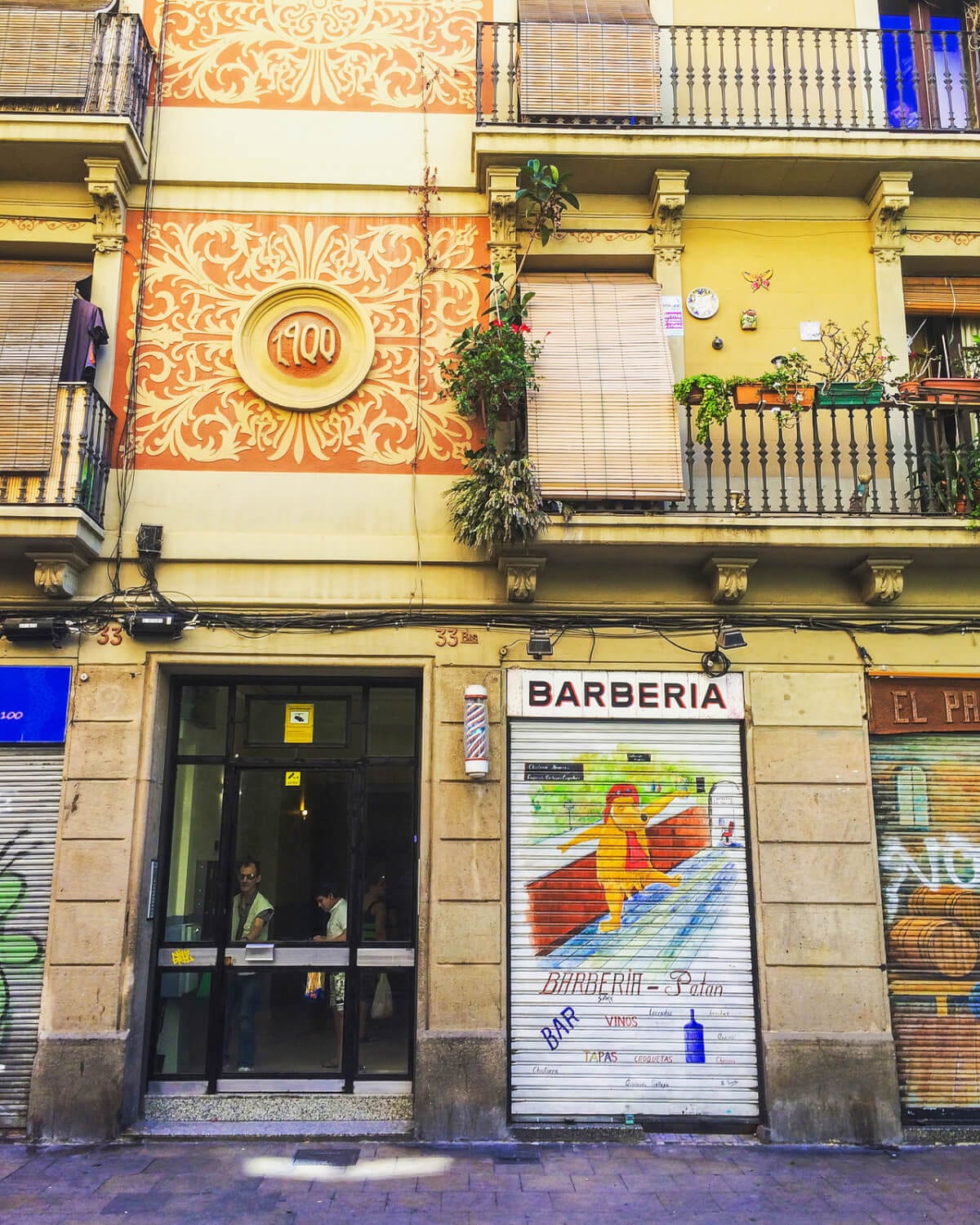
Barcelona’s El Poble-sec Neighbourhood

16 Surprising Medieval Traditions To Add To Your Christmas Celebrations
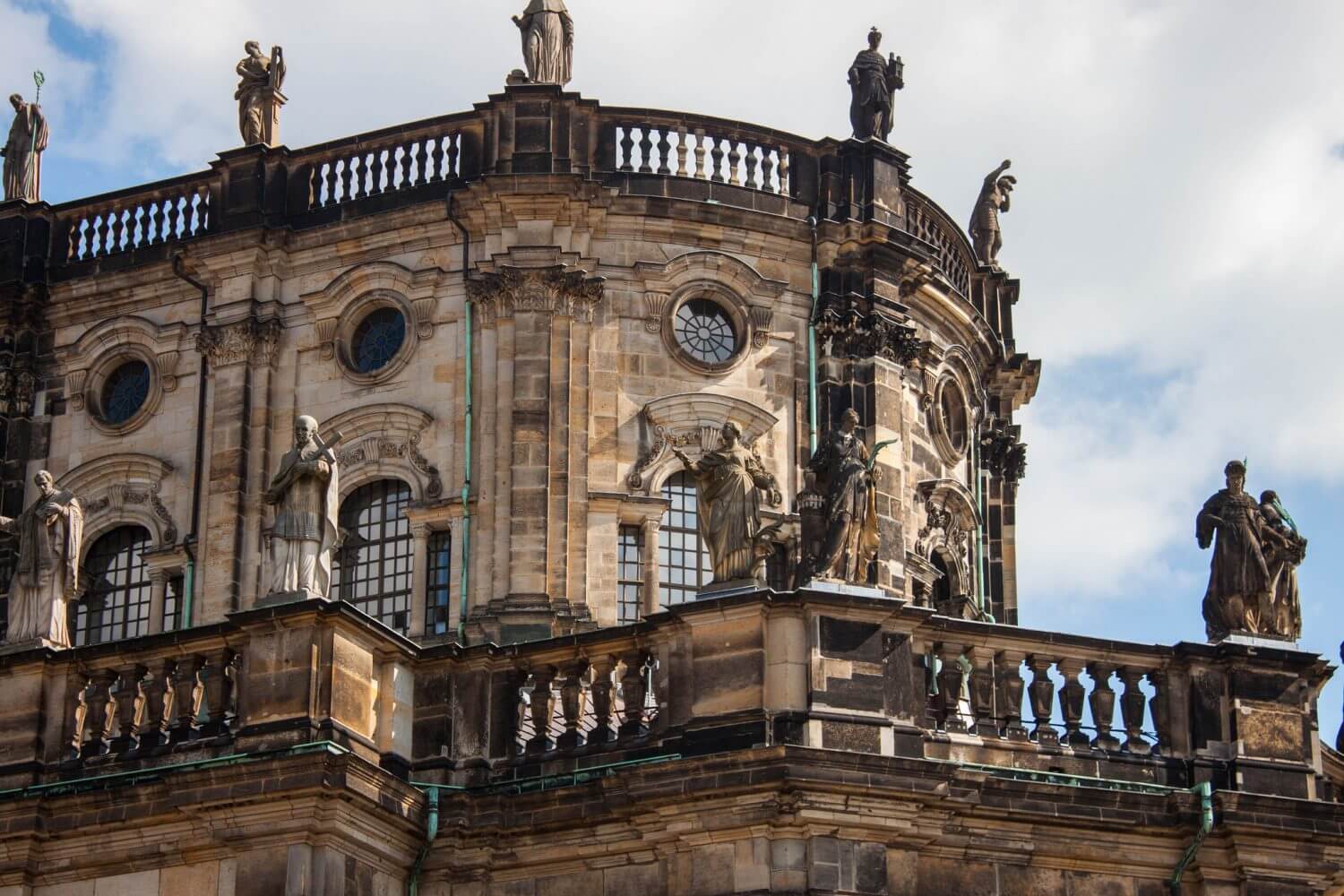
Exploring the Dresden Cathedral
Leave a comment cancel reply.
Your email address will not be published. Required fields are marked *
Copyright @ 2023 The Creative Adventurer | All Rights Reserved | Privacy Policy
- Legendary Hollywood
- Napa & Sonoma Valleys
- Historic Philadelphia
- Washington DC – Walking Tour
- Washington DC – Driving Tour
- The French Quarter
- Rome Eternal
- Barcelona Gothic Quarter
- Dubrovnik Walled City
- Paris La Cité
- Prague – City of Hundred Spires
- San Antonio River Walk & Alamo
- Tours: Our Audio Adventures!
Barcelona Gothic Quarter is SelfTour’s unique and immersive GPS assisted walking tour of one of the world’s most exciting and beautiful cities. Barcelona is a city of art where history is combined with a contemporary, hip vibe. With turn-by turn GPS and voice guided instructions we lead you through Barcelona’s very popular Gothic Quarters as the maze of narrow, twisty streets reveals its fascinating history, wonderful shopping, culture and spectacular architecture.
Download the App and Go!
This is an amazing adventure enhanced with delightful narration, stirring appropriate music, sound effects and colorful characterizations.
- Learn how the city became powerful from the days of the early Roman village then called Barcino, to the Kingdom of Aragon, to becoming Catalunya in the 19th Century.
- We will share stories about the hip vibe of the Quarter, its foods, wines, customs, how Spain controlled chocolate, and even lead you to the almost 200-year old restaurant where diners still enter and exit through the hot steamy kitchen.
- Sports fans, you’ll hear about the very famous Barca Futbol (soccer) team — And visit their Center where you can see a video experience of the outrageous excitement at their games.
- Hear about the many great artists and performers who lived and worked in the artistic atmosphere of the Gothic Quarter.
And, share with you one of Barcelona’s most romantic festivals!
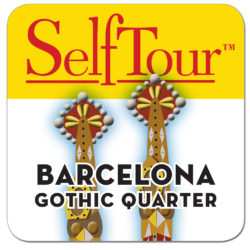
Preview our Barcelona Gothic Quarter Tour
Barcelona tour screenshots (iphone).
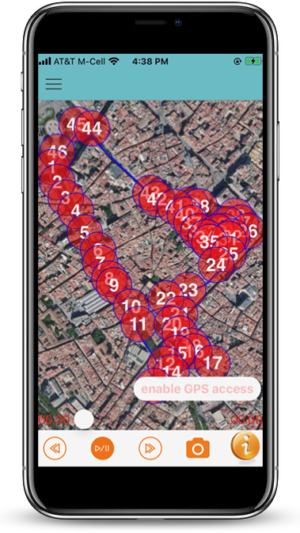
A Delightful Experience!
All descriptions are in an entertaining style by talented voice-actors One the three guides are Spanish, very familiar with Barcelona adding her own experiences of the city. The narratives have been thoroughly researched accurate information about the sites mixed with tidbits of fun, insider stories and information you want to hear.
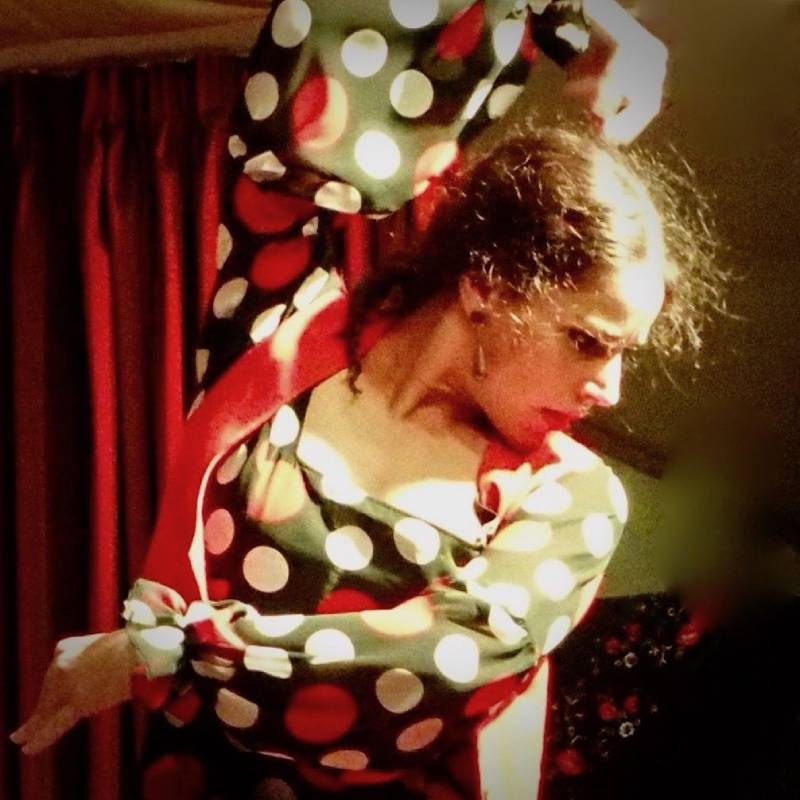
If there’s a tour worth taking, it’s worth taking a SelfTour!
Easy to Use!
There is no waiting for a tour guide. You don’t need one! Nor the guide’s large gaggle of tourists! You are an independent explorer. Start when you want, stop whenever to enjoy some more time at a site or to enjoy fjaka and rakia, (we’ll tell you all about them) then continue on your own schedule. This SelfTour™ App walk guides you with both turn-by-turn spoken and our exclusive GPS assisted, directions from site to site. No internet connection needed. The tour makes a complete circle so you end up where you started. And you can start at our suggested location, or anywhere along the route. Have fun!
All for a fraction of the cost of quality tours offered on site!
Voice Actors and Narrators
We are proud to share with you information about our exceptional voice-over talent who have used their performance skills to bring our SelfTour Audio Adventures alive:
Eve Muller – Love of theater and the Spanish language led to performances with Los Angeles based bilingual theater companies, as well as shows touring schools and libraries. She has voiced many educational videos in English and Spanish and is delighted to guide you on your journey through the city she loves, Barcelona!
Em Eldridge
Em Eldridge is an ACX Audible narrator of over 25 audio books. She is also an award winning filmmaker and accomplished classical singer and violinist.
You're in Control!
The easy-to-use exclusive SelfTour™ system ensures an enjoyable full-circle walking tour on your own schedule, at your own pace. No waiting for others! You can join the tour at any location, stop anywhere along the way and continue again. And it is a complete circle tour so you end up where you started. The GPS always shows you where you are so you can’t get lost. There are no advertisements and an internet connection is not needed. Just download and go!
All this makes your personal tour an enjoyable experience.
Now… walk with the stars!
SelfTour™ is a trademark of SelfTour Audio Adventures
Black Friday: Up to 15% off selected tours
Prices shown include discount | Offer ends November 28th at 11:59pm PST
Home / Blog / Destination / Spain / Barcelona / How to Take a Self-Guided Gothic Quarter Walking Tour
How to Take a Self-Guided Gothic Quarter Walking Tour
Barcelona’s Gothic Quarter is jam-packed with fascinating history and hidden gems. Its winding streets, towering stone buildings, and unique shops and storefronts all have stories to tell from the city’s past. With its medieval alleyways, small squares, and secret corners, this is one area that you simply can’t miss.
Barcelona is the perfect city to explore on foot, as even a short stroll can take you through six centuries of architecture. Going on a Gothic Quarter walking tour allows you to confront the city’s history up front as you walk the same steps its residents have taken for hundreds of years. What’s more, it’s so easy to take a self-guided Gothic Quarter tour with our handy insider knowledge.
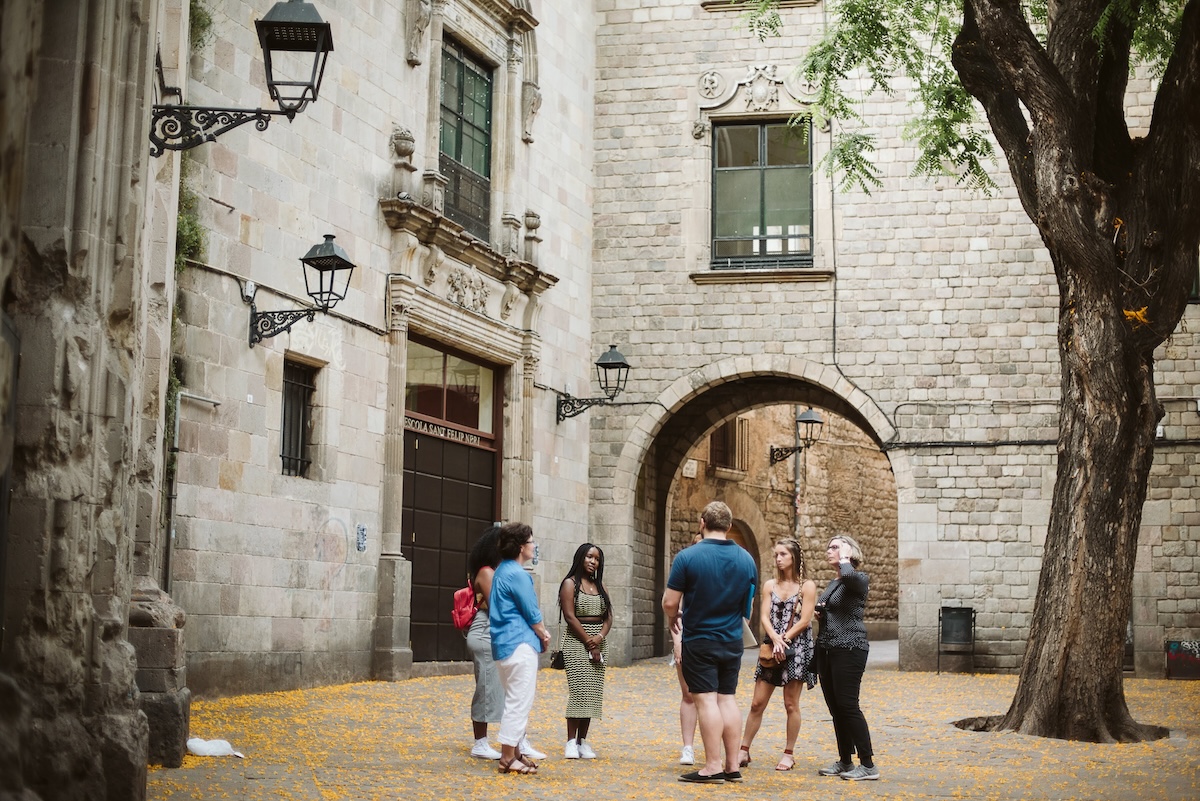
Discover Plaça Nova and the Cathedral
No trip through the Barri Gòtic would be complete without a visit to the Cathedral of Barcelona in Plaça Nova. Start your Gothic Quarter tour here by taking a walk around this imposing structure and then look up. In addition to traditional gargoyles on the roof, you’ll also find curious animals like unicorns and elephants.
Construction of the cathedral took place between the 13th and 15th centuries, but it got a facelift for the World Expo in 1888. If you walk around the right-hand side, you’ll see that its façade stops abruptly. This is because the city decided to save money by only renovating the parts of the building that would appear in photos.
The cathedral is beautiful inside as well. There are a variety of ticket options depending on what you want to see and do once inside.
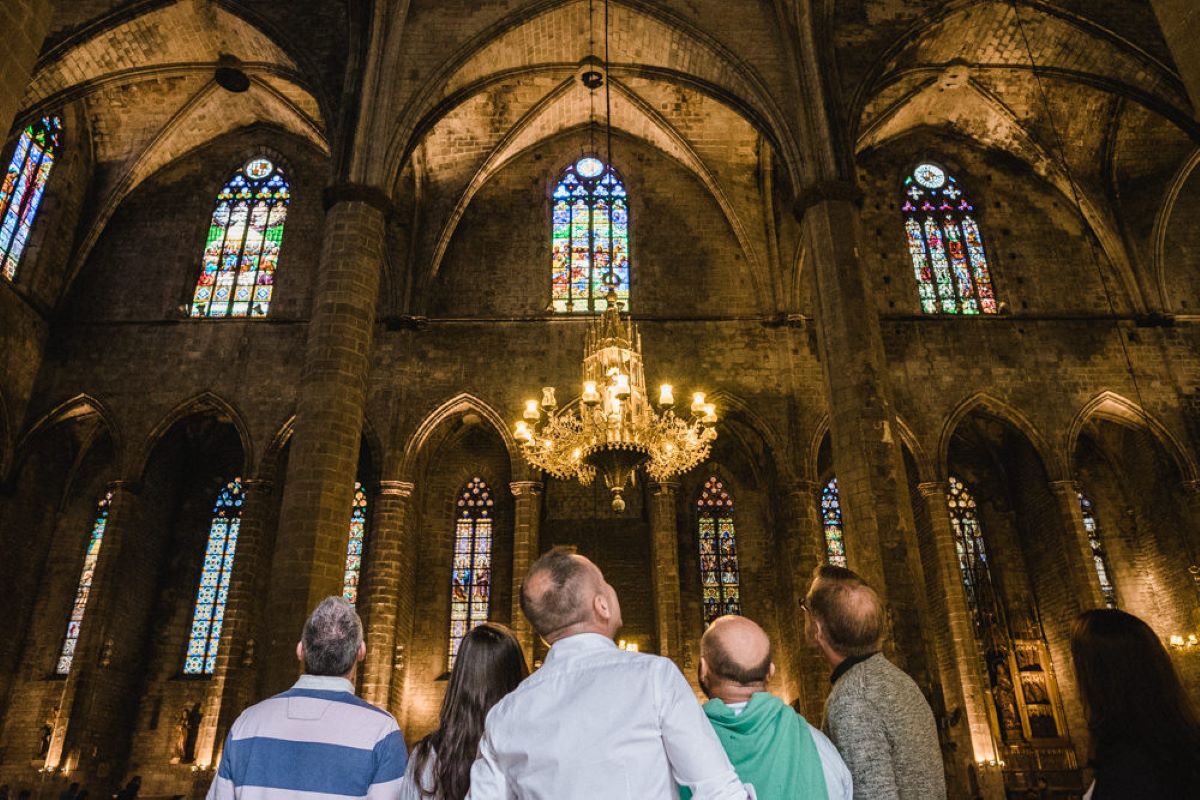
What to see in the Gothic Quarter next: Plaça de Sant Josep Oriol and Plaça del Pi
From Plaça Nova, head down Carrer de la Palla and sneak your way through the iconic narrow streets of the Gothic Quarter. After a few minutes, you’ll enter Plaça de Sant Josep Oriol.
This lovely square is home to the Basilica de Santa María del Pi . In years past, the wealthy residents of Vila de Gràcia would go to church here. While they worshiped, their drivers would hang out at Bar del Pi . This place has been open since the 1920s and previously served as a stable in the 18th century. In the 1930s, the Unified Socialist Party of Catalonia was founded here.
The masses gather at Plaça del Pi during the La Mercè festival to watch castellers climb and weave together to make impressive human towers. In addition to its colorful history, Bar del Pi is the perfect place to stop for tapas and a glass of vermouth or cava .
Plaça del Pi has plenty more to offer:
- If you’re lucky, your visit will coincide with the artisanal food market held here.
- Otherwise, grab something sweet at Granja Dulcinea ( Calle de Petritxol, 2 ). Opened in 1941, this is one of the best places for chocolate in Barcelona .
After your sugar fix, head to the far side of Plaça de Sant Josep Oriol. Take Carrer de l’Ave Maria, then head down Baixada de Santa Eulàlia.
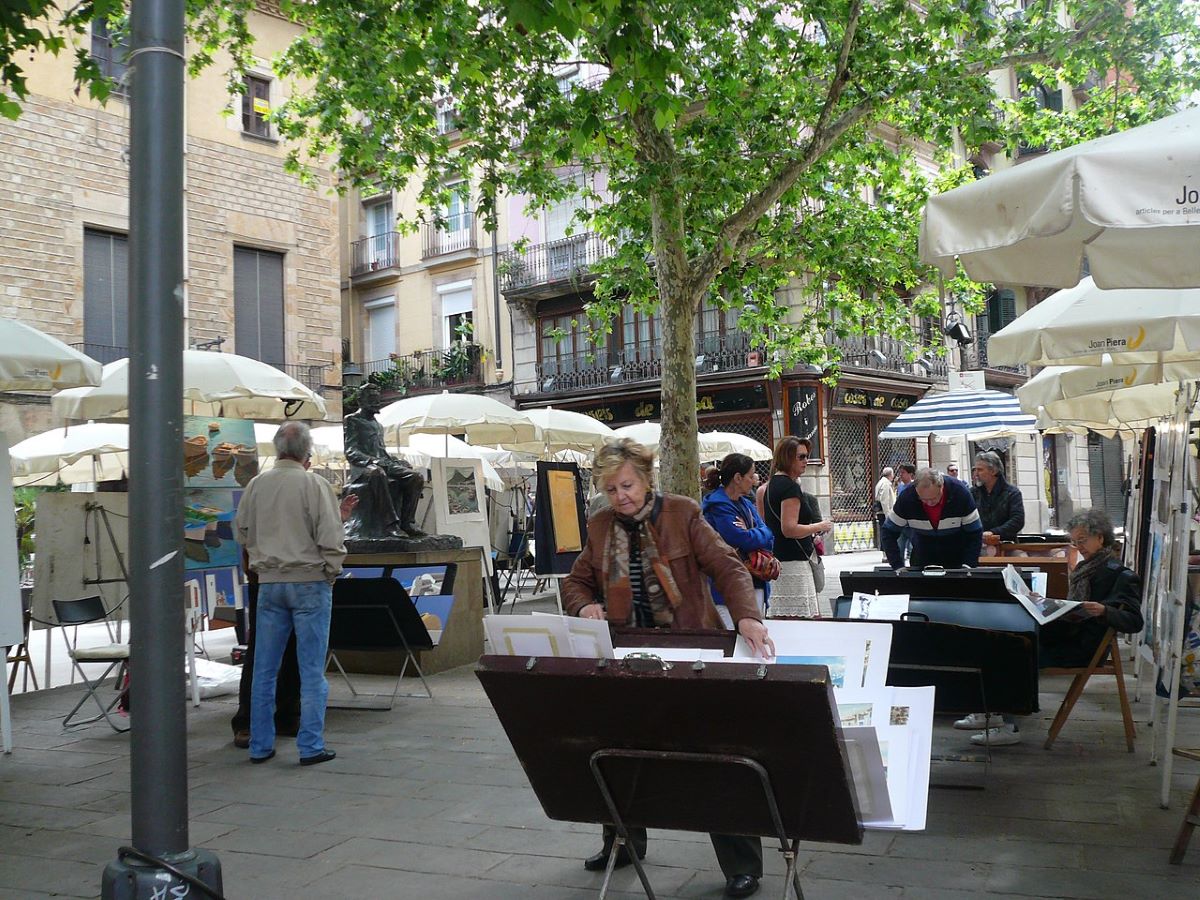
Continue your guided tour of Barcelona in Plaça de Sant Felip Neri
This is a more solemn stop on our tour of Barcelona’s history. Laid bare across this city’s beauty are harrowing reminders of its past, and Sant Felip Neri is the perfect example. At first glance, this square is peaceful and unassuming, with a small fountain and a baroque church. But if you look deeper, you’ll find pain etched into every stone.
In 1938, during the Spanish Civil War , Mussolini’s troops dropped bombs on civilian targets in this very plaza. Several schoolchildren were killed after seeking safety in the shelter below the church, which collapsed. Cracks and chips still cover the facade of the Església de Sant Felip Neri.
Today, the square is a school playground during the day, the terrace for a hotel restaurant in the evening, and a local hangout in the early hours of the morning. The visible damage to the church’s exterior, especially when combined with the sound of children playing, serves as a stark reminder of what can happen when society falls apart.
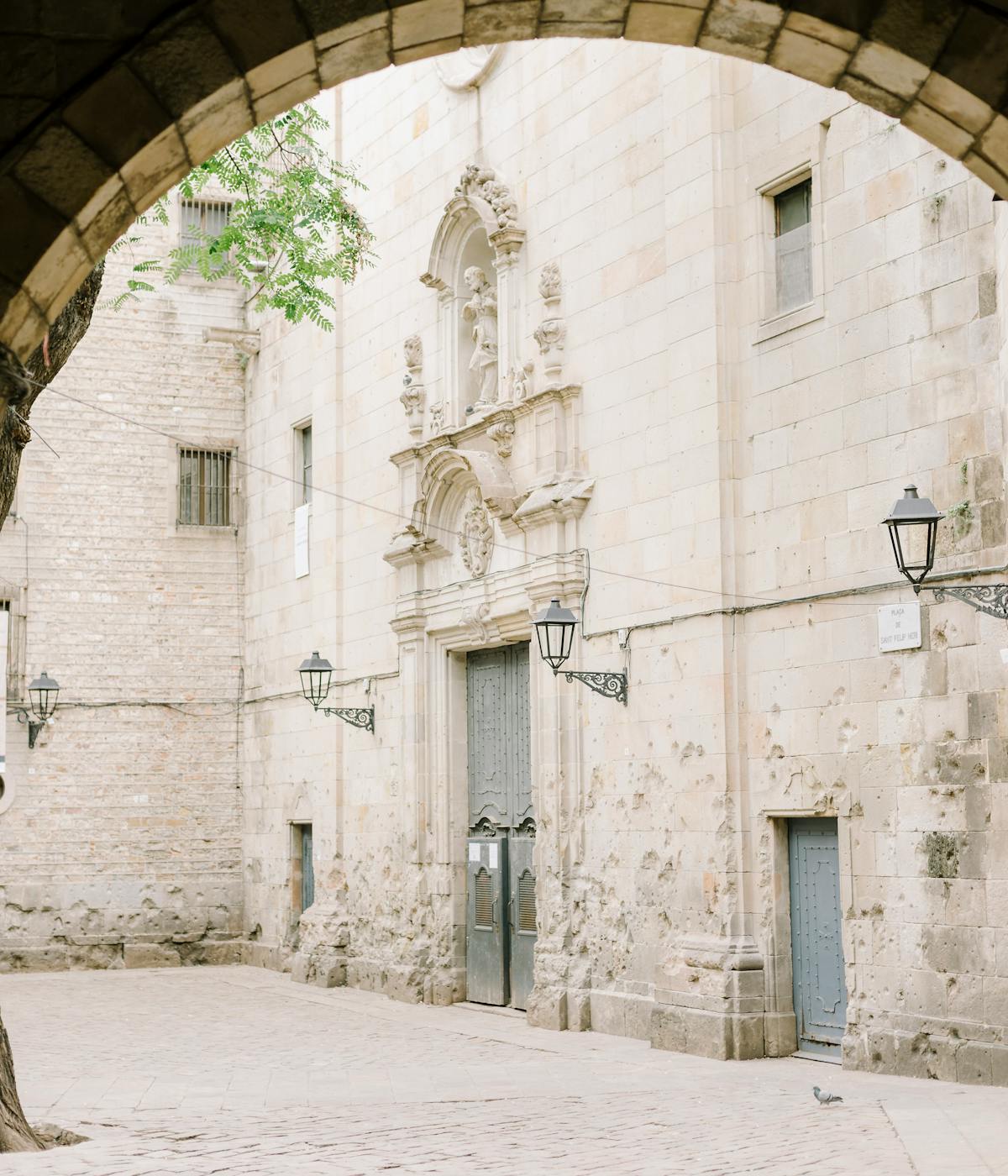
Plaça del Rei: Where your self-guided walking tour of Barcelona lets you step back in history
Head down Carrer de Montjuïc del Bisbe, then take Carrer de la Pietat through the General Archive of the Crown of Aragon . Upon exiting the archives, you’ll find yourself in Plaça del Rei , home to an interesting story:
- Legend has it that the steps in the left corner of this square are where Christopher Columbus presented his bounty after discovering America. Whether or not this story is true, Columbus’ findings had an important impact on Barcelona.
- Until this point, it was the prosperous capital of the powerful region of Catalonia. But after trade began with the Americas, Andalusia became the peninsula’s trading center.
- Due to this, along with the Spanish Inquisition and various plagues, Barcelona fell into neglect and didn’t regain its status until the Industrial Revolution.
However, we have Barcelona’s bad fortune to thank for the Gothic Quarter. If money had continued to flow, the structures you see today would have been knocked down to make room for more modern and fashionable buildings.
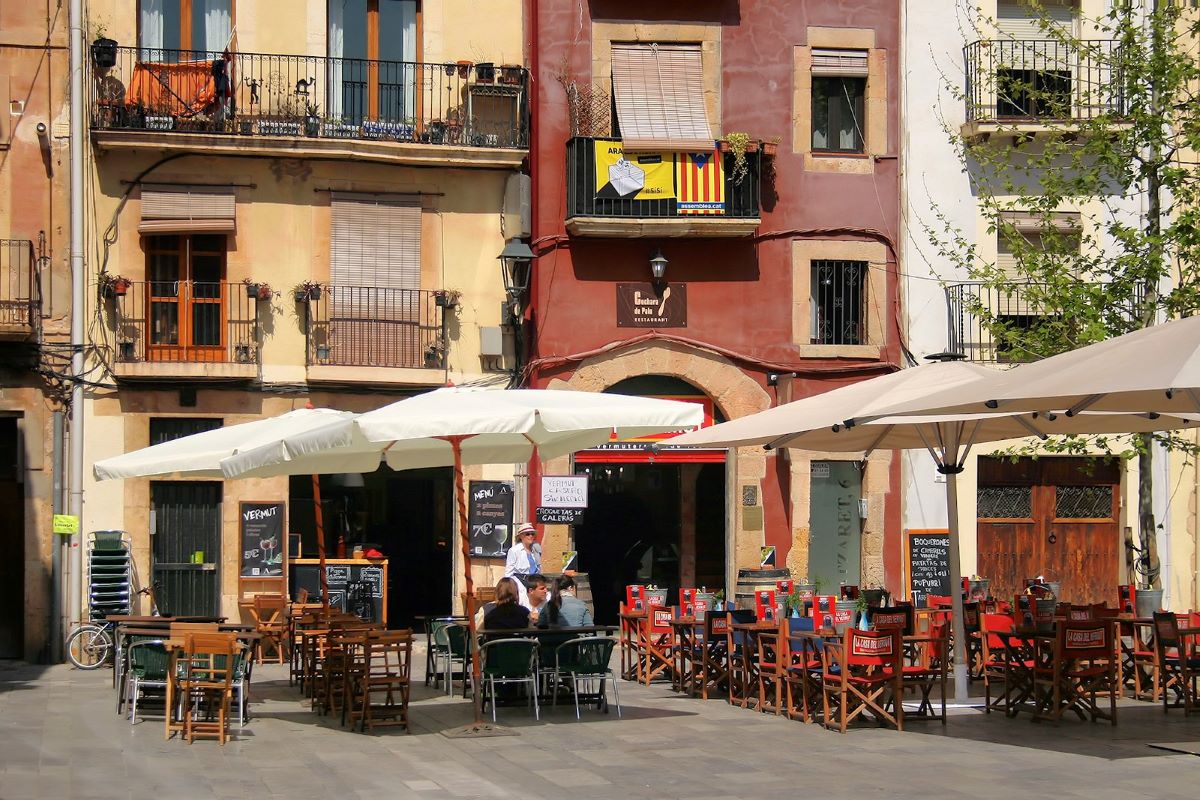
Eating in Barcelona on a budget: Plaça de Sant Jaume
From Plaça del Rei, take Carrer del Veguer and pass the MUHBA history museum . Crouch down to look through the low windows at the remains of Roman Barcelona. You can even explore them under the cathedral.
If you’d rather stay above ground, follow Baixada de la Llibreteria to Plaça de Sant Jaume. This has been the political center of Barcelona for 2,000 years. It’s often a venue for demonstrations and peaceful protests.
We’ll finish this self-guided walking tour of Barcelona with a stroll to the shoreline, and where to eat in the Gothic Quarter :
- On your way to the water, stop at Bodega La Palma ( Calle de la Palma de Sant Just, 7 ) for patatas bravas and croquetas . Today it’s known for tapas, but it used to be a famous Bohemian hangout frequented by Picasso and his contemporaries.
- Just five minutes away, you’ll find La Plata : a local institution beloved for its food, atmosphere and staff. The manager, Pepe, is there every day. Grab a table or a spot at the bar and enjoy the fried fish, tomato and onion salad, butifarra and, house vermouth.
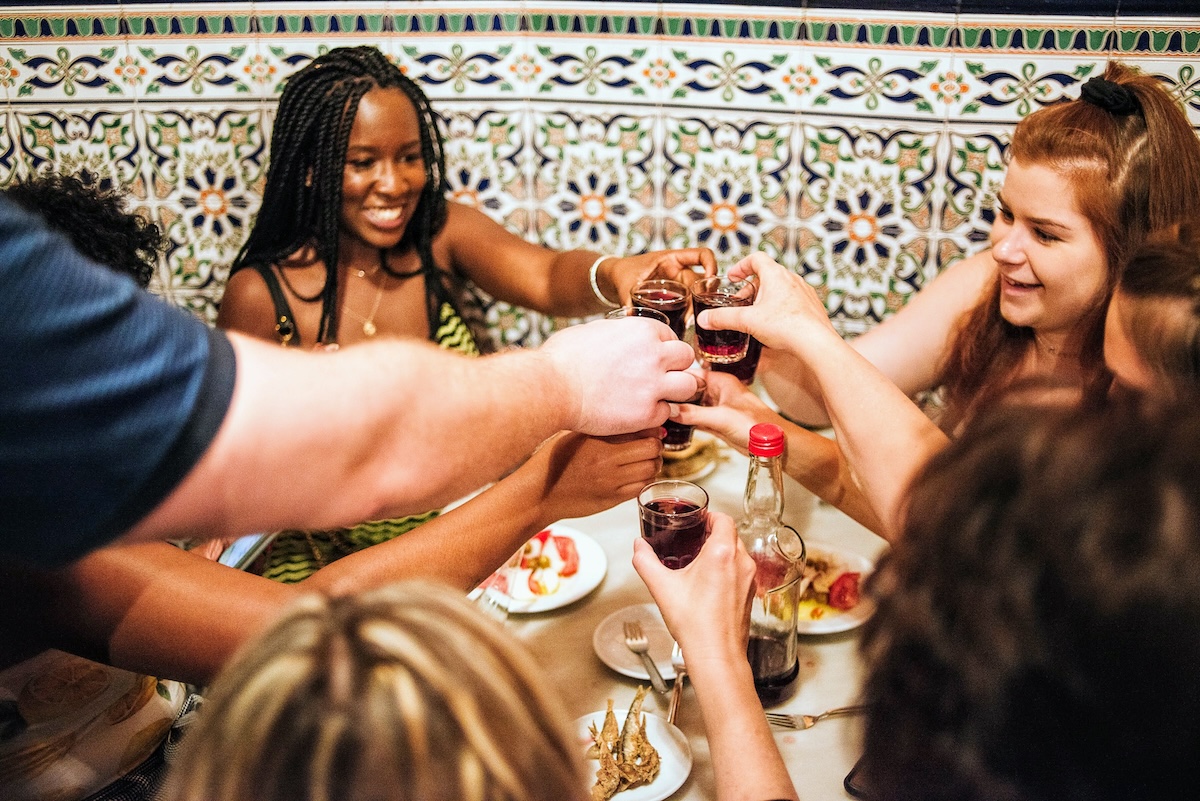
Update Notice: This post was updated on April 26, 2024.
Want to discover the real Gothic Quarter away from the hoards of tourists? Why not join us on our Barcelona Tapas, Taverns & History Tour where our knowledgeable guides will take you through the Gothic Quarter to authentic tapas bars, explore Roman to Moorish architecture, and uncover secrets of Barcelona’s past.
Most helpful
Thanks so much for reading!
Leave a Reply Cancel reply
You must be logged in to post a comment.
- Boating Holidays
- Asia & Pacific
- Australia & New Zealand
- Central America
- Indonesia & Indian Ocean
- Middle East
- Scandinavia
- South America
- Business Travel
- Culinary Travel
- Wellness Travel
- Golf Travel
- Travel Style
- Travel Gear
- Travel Fashion
- Real Estate
- Destination Weddings
- Fishing Holidays
- Tricks & Hacks
- Travel News
- #WHERETONEXT
- Read All the Issues
- Working with DRIFT Travel
- Submit Your Photos to DRIFT Travel
- DRIFT Travel Magazine Media Kit

Self-Guided Walking Tour of Barcelona’s Gothic Quarter
Nestled within the heart of Barcelona, the Gothic Quarter stands as a living testament to the city’s rich history, architectural splendor, and vibrant culture. As sunlight filters through narrow cobblestone alleys and dances across centuries-old facades, visitors embark on a journey through time, immersing themselves in the enchanting allure of this medieval neighborhood.
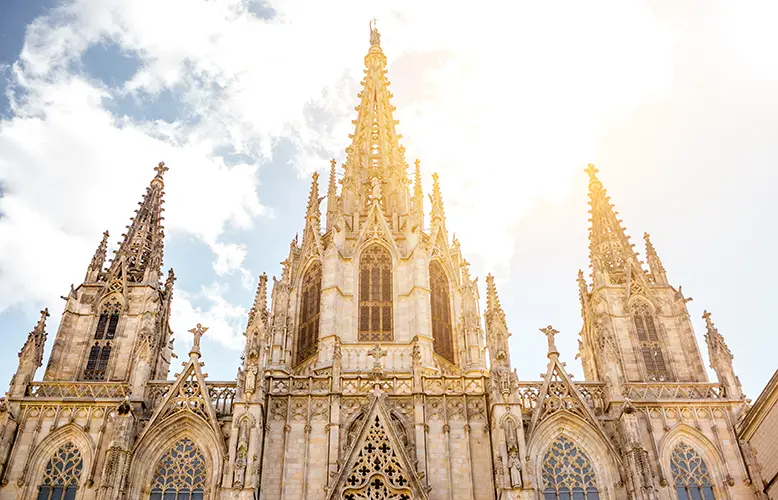
In this bustling metropolis, where the modern seamlessly intertwines with the ancient, the Gothic Quarter emerges as a captivating labyrinth of narrow streets, hidden squares, and storied landmarks. Every step echoes the footsteps of generations past, whispering tales of Roman origins, medieval grandeur, and the spirited pulse of contemporary Catalan life.
Our self-guided walking tour of Barcelona invites you to unravel the layers of history etched into the very stones beneath your feet. As you meander through the labyrinthine streets, each twist and turn unveils a new chapter in Barcelona’s narrative, offering a profound and immersive exploration of one of Europe’s most cherished neighborhoods.
5 Must-Visit Places in the Gothic Quarter
The Gothic Quarter is one of Barcelona, Spain’s most enchanting and historic neighborhoods. Steeped in centuries of history, this labyrinthine area is a treasure trove of medieval architecture, narrow alleys, and charming squares. Here are five must-visit places in the Gothic Quarter.
Plaça Nova and the Cathedral
At the heart of the Gothic Quarter lies Plaça Nova, a bustling square surrounded by historic buildings. The standout feature of this square is the Barcelona Cathedral, also known as the Cathedral of the Holy Cross and Saint Eulalia. The cathedral dates back to the 13th century and is a stunning example of Catalan Gothic architecture. Visitors can explore the interior, including the abbey and the rooftop, for panoramic city views.
Visitors are transported through the cathedral’s doors into a world of religious grandeur and architectural splendor. The interior has soaring columns, rib vaulted ceilings, and a sense of sacred serenity. The abbey, an oasis of tranquility within the bustling Gothic Quarter, features a charming courtyard inhabited by thirteen geese, symbolizing the age of Saint Eulalia, the patron saint of Barcelona.
One of the highlights for those with a penchant for heights is the ascent to the cathedral’s rooftop. Climbing the narrow spiral staircase rewards visitors with panoramic views of Barcelona’s skyline, providing a unique perspective on the city’s architectural evolution from medieval to modern times. The spires and gargoyles create a silhouette against the sky, emphasizing the cathedral’s religious and architectural landmark role.
Plaça de Sant Josep Oriol and Plaça del Pi
These adjacent squares offer a charming blend of history and local life. Plaça de Sant Josep Oriol is dominated by the Church of Sant Josep Oriol, known for its beautiful Baroque facade. The square is a lively gathering spot with outdoor cafes and street performers. Just a short walk away, Plaça del Pi is home to the Basilica de Santa Maria del Pi, a Gothic church with a stunning rose window. The squares are perfect for strolls and soaking in the vibrant atmosphere.
Centered around the imposing Church of Sant Josep Oriol, this square exudes a lively yet relaxed atmosphere. The church, with its Baroque facade adorned with sculptures and decorative elements, serves as both a religious focal point and a captivating architectural backdrop. The square is a meeting place for locals and visitors alike, with outdoor cafes spilling onto the cobblestone pavement. It’s a place to savor a cup of coffee, observe street performers, and soak in the vibrant energy of Barcelona.
Plaça de Sant Felip Neri
Tucked away in a quieter corner of the Gothic Quarter, Plaça de Sant Felip Neri is a hidden gem with a poignant history. The square is surrounded by the Church of Sant Felip Neri, scarred by shrapnel from bombings during the Spanish Civil War. The serene ambiance of the square, combined with its tragic past, creates a moving experience for visitors.
This intimate square bears witness to a tragic chapter in Barcelona’s history, as evidenced by the scars that still mark its surroundings. The square’s centerpiece is the Church of Sant Felip Neri, a modest yet beautiful Baroque structure. However, the gravestones embedded in its walls and the pockmarked facades of nearby buildings tell a somber tale. During the Spanish Civil War, in 1938, the square became the unintended target of a bombing raid, resulting in the loss of numerous lives, many of them children from a nearby school.
Plaça del Rei
Plaça del Rei, or King’s Square, is a historic square that transports visitors back to medieval Barcelona. The square exudes a sense of regality, surrounded by impressive buildings, including the Palau Reial Major (Grand Royal Palace) and the Chapel of St. Agatha. The Museu d’Història de Barcelona (Barcelona City History Museum) is located here, offering a journey through the city’s past with archaeological finds and exhibits.
A collection of notable structures frames Plaça del Rei, each contributing to the square’s unique charm. The Palau Reial Major (Grand Royal Palace) dominates the scene with its regal facade. This palace served as the residence of the Counts of Barcelona and later the Kings of Aragon. The Saló del Tinell, an impressive Gothic hall within the palace, has witnessed significant historical events, including the Catholic Monarchs’ reception of Christopher Columbus upon his return from the Americas.
Plaça de Sant Jaume
This square is the political and administrative heart of Barcelona. Bordered by the City Hall (Ajuntament) and the Palau de la Generalitat de Catalunya (Palace of the Generalitat of Catalonia), Plaça de Sant Jaume is a significant civic space. It has been the site of political and social gatherings throughout history. The architecture surrounding the square is noteworthy, and the atmosphere is vibrant, especially during public events and celebrations.
Exploring these five places in the Gothic Quarter provides a rich tapestry of Barcelona’s history, culture, and architecture, making it a must-visit destination for travelers and history enthusiasts alike.
RELATED ARTICLES MORE FROM AUTHOR
Enchanted Visions of Madeira, Portugal: Discover Véu da Noiva, Guindaste and Rocha do Navio
Global Cheers: Oktoberfest Festivities Worldwide
Making the Most of Your Visit to the Palace of Versailles
Privacy overview.
Shop Now for Season’s Most Trending Dresses That’s a Must-Have

Barcelona Lowdown
Exploring Barcelona’s Gothic Quarter: A Perfect Half-day Itinerary
With over two thousand years of history, Barcelona’s Gothic Quarter is a labyrinth of narrow streets and striking Gothic architecture that dates back to the Middle Ages and the times of the Roman Empire .
Located between Plaça de Catalunya and the Port Vell Harbour , the Gothic Quarter is the heart of the Old City and is where you will find many of Barcelona’s most historic sights, as well as the City Hall and other civic buildings.
Many of the narrow lanes and alleyways are only accessible on foot, and the Barri Gotic , as it’s called in Catalan, is a perfect area for exploring and wandering at your own pace. The itinerary outlined below visits the Gothic Quarter’s most interesting sights and guides you through some of the most picturesque streets and plazas.
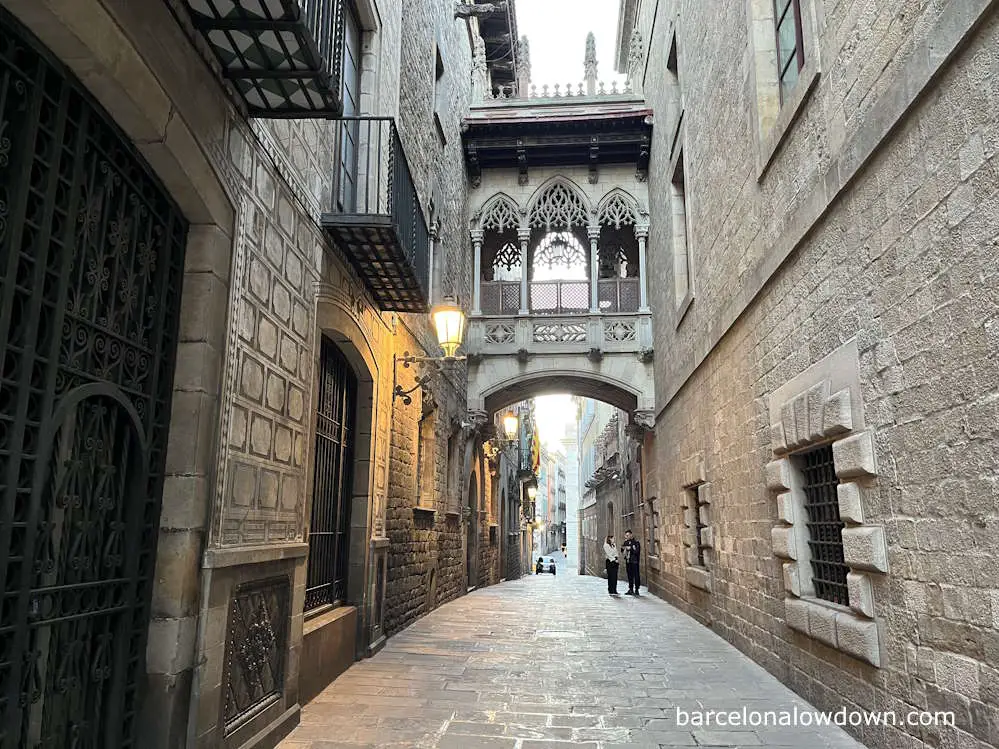
The route is just under five kilometres long and, if you decide to walk it non-stop, would take approximately ninety minutes. However, I recommend taking your time and going inside at least a few of the buildings and museums, turning the route into a perfect half-day itinerary .
As usual, I’ve created a Wikiloc trail , which you can download to your phone . However, GPS coverage is quite poor in the narrow streets and alleyways, so I recommend keeping a copy of the instructions below for reference.
Don’t worry if you go astray. The Gothic Quarter is quite small; if you keep walking, you’ll soon find somewhere you recognize. If you aren’t comfortable with the idea and think you might get lost, I recommend this Gothic Quarter Walking Tour , which visits many of the sights mentioned in this post.
A Brief History of the Gothic Quarter
Self-guided walking tour of barcelona’s gothic quarter.
- Barcelona Gothic Quarter map
Where to stay in the Gothic Quarter
Sightseeing passes and tickets.
- Tours of the Gothic Quarter
Barcelona was first settled around four thousand years ago in the Neolithic period . The city as we know it today evolved from a Roman settlement called Barcino , which was founded in the first century BC and formed the nucleus of what is now the Gothic Quarter , centred on Plaça de Sant Jaume.
Although less important than Tarraco , the settlement quickly grew into a prosperous Roman city , complete with a forum, bathhouses, palaces, defensive walls and a grand temple dedicated to Caesar Augustus. This map shows Barcino superimposed on a modern map of Barcelona and clearly illustrates how the streets of the Gothic Quarter correspond with the streets of the Roman city.
In 415 AD, after the decline of the Roman Empire, Barcelona was taken over by the Visigoths and remained under their rule for three centuries. The Visigoths, who controlled much of the Iberian Peninsula and part of France, converted Barcino, which they renamed Barcinona , into their capital city due to its central location and strong defensive walls.
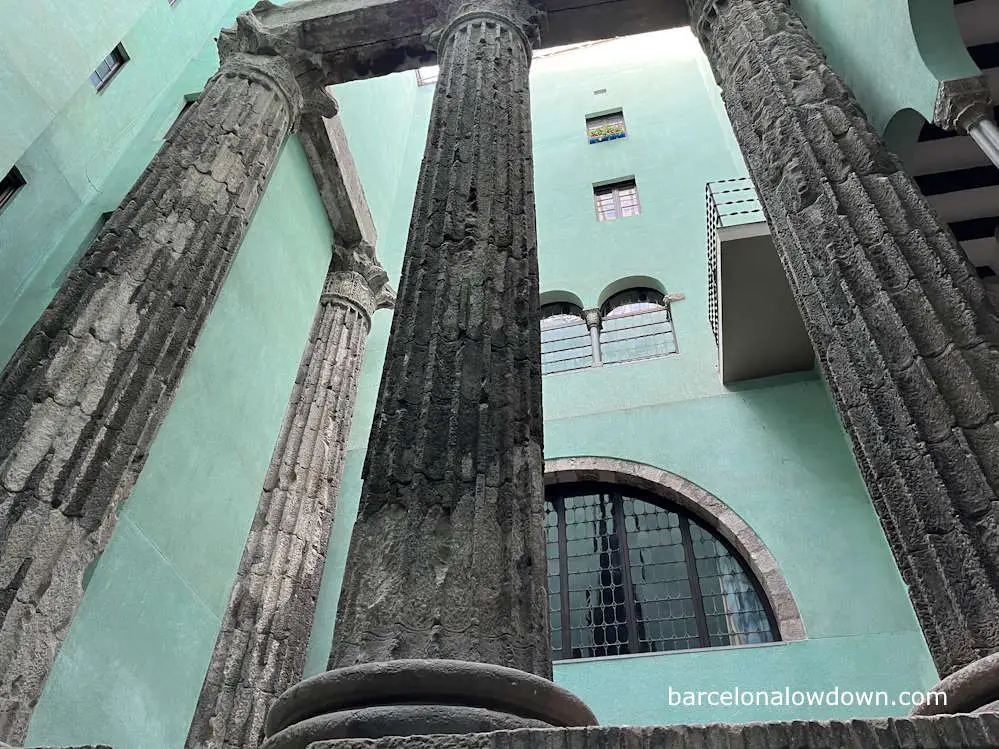
Visigoth rule ended in 755, after the Moorish invasion from the south when Barcelona came under the control of the Emirate of Cordoba . Muslim rule was relatively short-lived, and in 801, Barcelona became part of the Carolingian Empire after being taken by Louis I, son of Charles the Great.
Under Frankish rule, Barcelona became part of the Spanish March , a militarized buffer zone which separated the Moorish kingdom of Al Andalus from the Christian territories to the north. The Spanish March was divided into counties, each of which was governed by a count.
During the two centuries which followed, Barcelona repeatedly came under attack until, in 985, the city was razed to the ground. After this attack, Barcelona broke away from the crumbling Carolingian Empire. The Roman walls were further strengthened by adding three castles: Castell Nou, Castell Regomir and Castell Vell.
Today, all that remains of the castles is a small window above the storefront of the Sombrerería Obach hat shop.
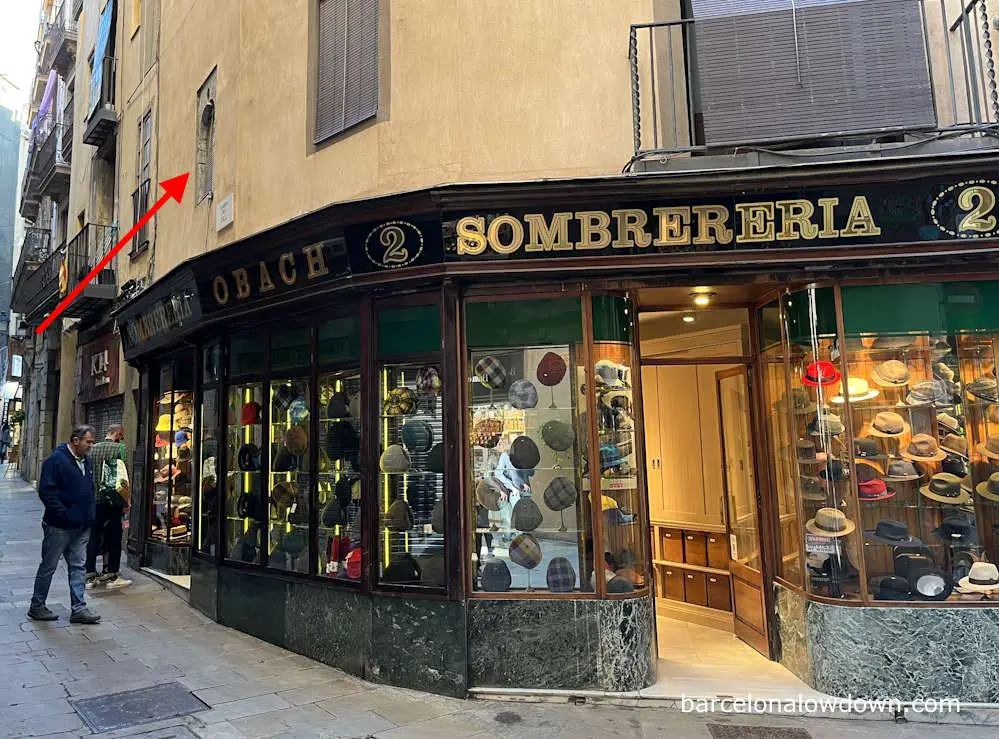
During the eleventh century, Barcelona became more powerful and began annexing neighbouring counties, including Girona, Ausona, Cerdenya and Besalú . In 1150, Ramon Berenguer IV , Count of Barcelona, married Petronila de Aragon , uniting the Kingdom of Aragon with the County of Barcelona to form the Crown of Aragon .
During the thirteenth and fourteenth centuries, the Crown of Aragon began establishing trade routes and expanding across the Mediterranean to control Valencia, Mallorca, Sicily and Sardinia. The population and wealth of Barcelona grew and the city spread outside the original Roman walls. New medieval walls were built, the first surrounding what is now the Gothic Quarter, La Ribera and El Born neighbourhoods, and the second surrounding El Raval.
You can find out more about Barcelona’s neighbourhoods in this post >>
Many of Barcelona’s most emblematic Gothic buildings were built during this period, including Barcelona Cathedral, the Royal Palace, the Saló del Tinell, the Chapel of Santa Agata, the Royal Shipyards, the Palau de La Generalitat, the Basilica de Sant Just and the Basilica de Santa Maria del Mar .
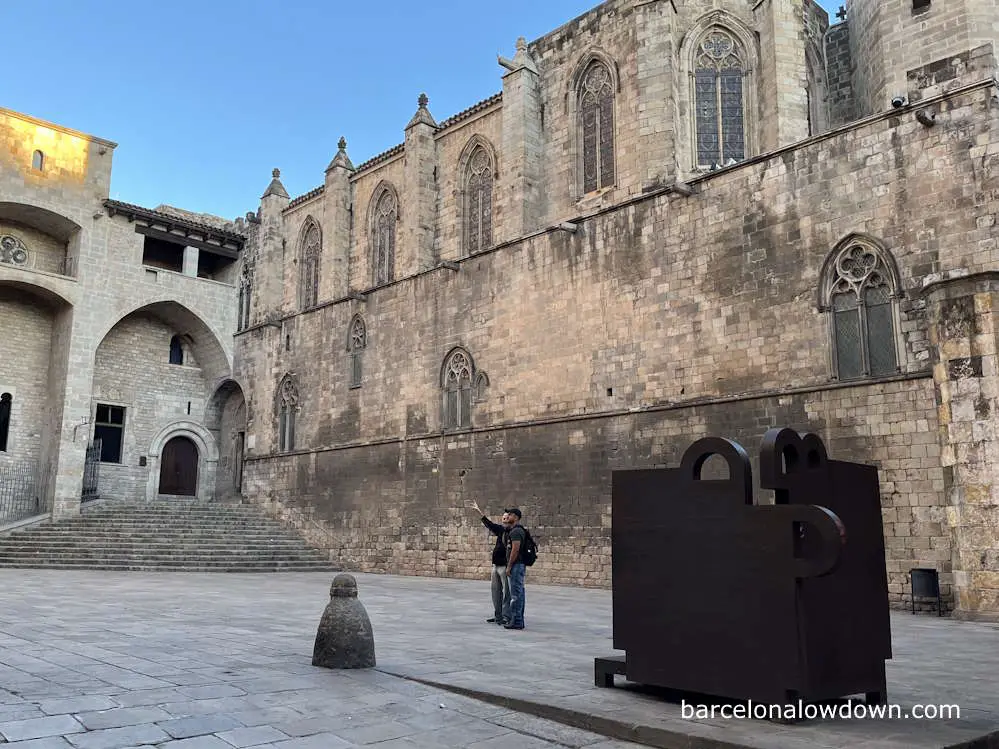
In 1469, Ferdinand II of Aragon married Isabella I of Castile , uniting the Crown of Aragon with the Kingdom of Castile .
In 1492, their combined armies finally defeated the Granada Emirate , marking the end of the Reconquista of Spain from Muslim control. The “discovery” and colonisation of the Americas reduced the importance of the Mediterranean trade routes, and the Catholic Monarchs transferred their administrative capital to Madrid.
The unification of the Spanish kingdoms and the wealth generated by their new colonies ultimately led to the War of the Spanish Succession when the Catalans sided with the Austrian Habsburgs against Philip V . The war ended in 1714 and resulted in the implantation of Nueva Planta decrees, the loss of Catalan autonomy, and the razing of part of the La Ribera neighbourhood to make way for a large Citadel , which was built to subjugate Barcelona.
During the nineteenth century, thanks to the Industrial Revolution , Barcelona was prospering again and began to expand outside the medieval city walls. This expansion had two major impacts on the old city centre.
Firstly, the medieval walls were torn down. The old city was overcrowded, and most of the medieval buildings had been divided into tiny apartments. By tearing down the walls, city planners intended to open up the old city, making it a healthier and more pleasant place to live and, at the same time, connecting it with the newer part of the city, the so-called l’Eixample district.
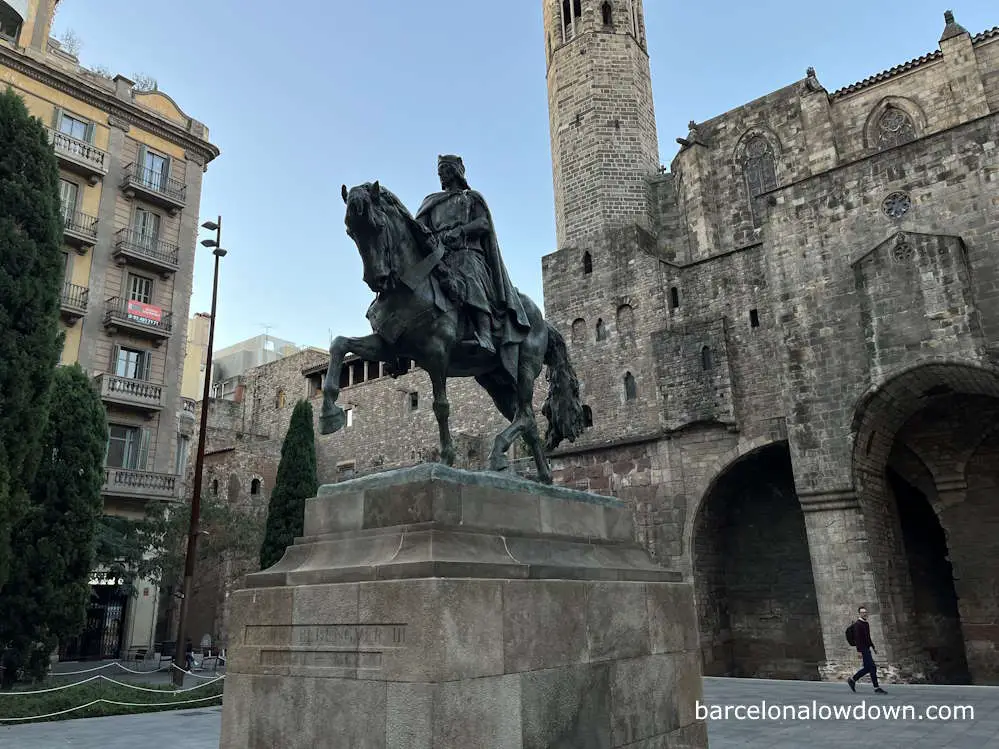
The second major transformation which took place was the construction of Via Laietana , the avenue linking the Eixample to the Port Vell , which runs directly through the middle of the old city.
The construction of Via Laitena involved tearing down a large swathe of buildings, including several emblematic Gothic edifices. Instead of destroying the historic buildings, the local authorities decided to move them and rebuild them in the neighbourhood surrounding the cathedral, which at this time was called the Cathedral Neighbourhood (Catalan: Barri del Catedral).
In the process, the area was given a facelift and many of the older buildings were restored to recapture some of the city’s medieval splendour. Some architectural features of medieval buildings which had been torn down were used to embellish existing buildings. Many of the narrower streets were closed to traffic, and the newly restored neighbourhood was renamed the Gothic Quarter .
As part of the remodelling process, Barcelona Cathedral was given an impressive new Gothic façade, and several other NeoGothic features, such as the Bishop’s Bridge , were added.

The tour follows a circular route which starts at the Jaume I metro stop, although you could start at any point along the way.
1. Plaça de l’Angel
Exiting the metro station, you’ll find yourself in a small square surrounded by majestic old buildings. On one side of the square, you can see Via Laietana . Running parallel to it, you’ll find the remains of the old Roman Wall , which runs alongside Carrer de la Tapinera .
To begin the tour, we walk along Baixada de la Llibreteria and take a right onto Carrer del Veguer after about 50 metres. This leads us to our first stop; Plaça del Rei .
2. Plaça del Rei & the Barcelona History Museum
As I mentioned earlier, during the Middle Ages, Barcelona was the capital of the Crown of Aragon , and Plaça del Rei was the courtyard of the Royal Palace.
The square is flanked on three sides by el Palau Reial Major, el Palau del Lloctinent and the Capilla de Santa Agata, which have been restored and converted into MUHBA Plaça del Rei , the Barcelona History Museum.
I decided to start the tour here because I think the museum is a good introduction to the history of the Gothic Quarter .
Tickets to MUHBA Plaça del Rei also include entry to the other MUHBA sites we visit later in the tour.
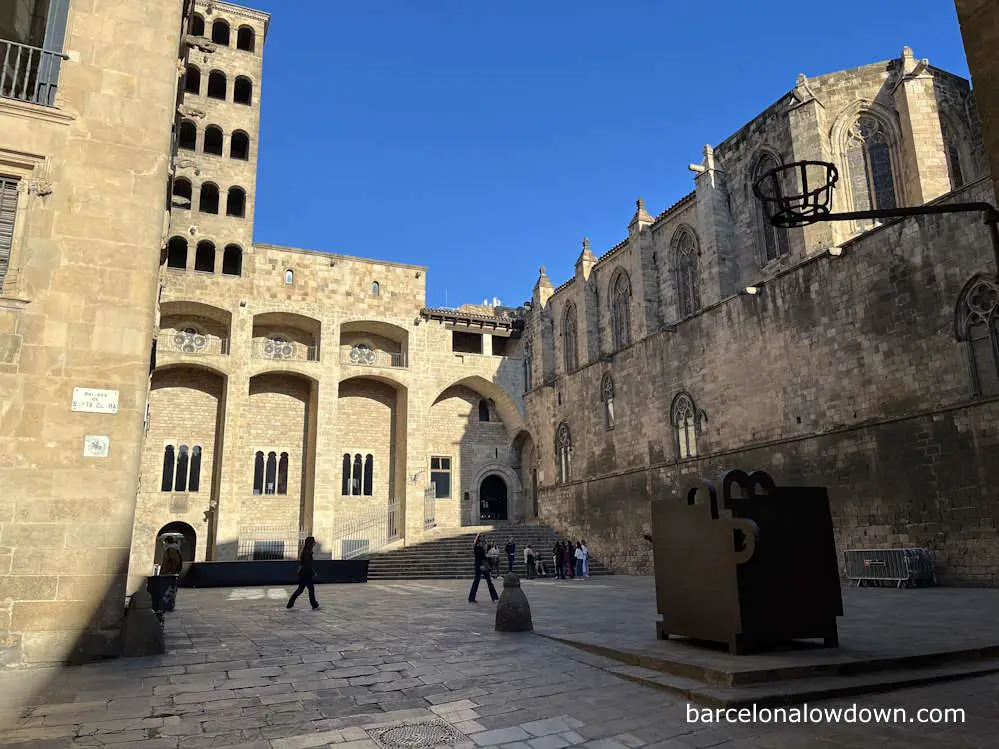
3. Temple of Augustus
After visiting the museum we continue along Baixada de Santa Clara towards the Temple of Augustus .
After a few metres, we come to Carrer de la Pietat and Barcelona’s impressive Gothic Cathedral , which dates back to the twelfth century. We’ll visit the cathedral later in the tour, so for now; we spend a few moments here looking up at the gargoyles before turning left along Carrer del Paradis .
All that remains of Barcelona’s Roman temple are four Corinthian columns hidden inside a small Gothic building belonging to the Centre Excursionista de Catalunya . A small plaque outside the building indicates that it is located on the peak of Mt Taber, which, at 16.9m high, was the highest point of the Roman city of Barcino.
There’s more information about the Temple of Augustus in this post .
After admiring the Roman columns, we continue along Carrer del Paradis to Plaça Sant Jaume .
4. Plaça de Sant Jaume
Plaça Sant Jaume has been the political centre of Barcelona since the time of the Roman Empire when it was the site of the Forum .
Barcelona City Hall and the Palau de la Generalitat de Catalunya stand on either side of the square. At the weekend, you’ll often see small groups of people with banners protesting their cause directly outside the Town Hall or parliament building.
In addition to its political importance, Plaça de Sant Jaume also hosts celebrations such as La diada , El dia de Sant Jordí, and La Mercè, to name just a few.
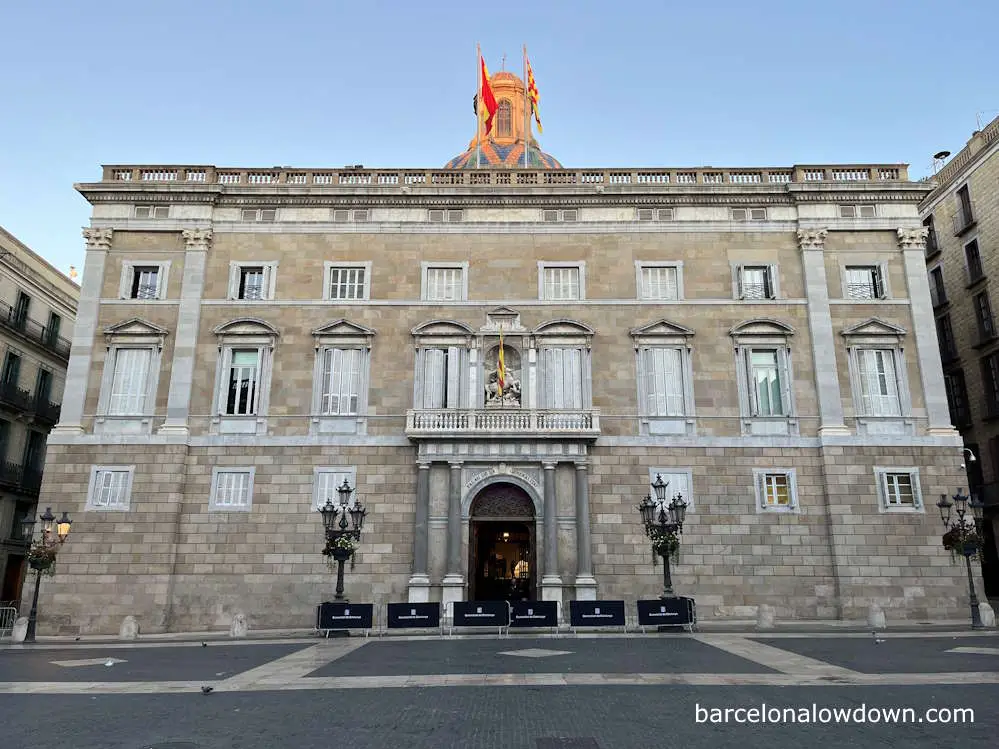
5. Palau de la Generalitat de Catalunya
The Generalitat de Catalunya is the regional government of Catalonia. Its origins can be traced back to the thirteenth-century Catalan Courts .
The Palau de la Generalitat building dates back to the fourteenth century, although the Reneisançe style main façade was built during the sixteenth century. The building’s original Gothic façade, complete with gargoyles, can still be seen along Carrer del Bisbe .
6. Barcelona City Hall
On the opposite side of Plaça de Sant Jaume stands Barcelona City Hall, a fourteenth-century Gothic building with a nineteenth-century neoclassical façade.
As with the Generalitat de Catalunya, Barcelona city council can trace its origins back to the Middle Ages and the so-called Concell de Cent , which was established during the thirteenth century.
The building opens its doors to the public each Sunday from 10:00 until 13:00 (free entry), or you can take a virtual tour here .
More information in my guide to visiting Barcelona City Hall>>
From here, we continue along Carrre de l’Arlet , which runs along the left-hand side of the city hall building. We then take the first left, along Carrer d’Hèrcules , to Plaçeta de Sant Just .

7. Basílica dels Sants Màrtirs Sant Just i Pastor
The Basilica dels Sants Màrtirs Sant Just i Pastor is one of the oldest churches in Barcelona and dates back to the fourteenth century.
The Gothic-styled church is open to the public from 10 a.m. and, although there is not much to look at from the outside, it’s worth checking out the interior and climbing the bell tower, which gives good views of the Gothic Quarter.
8. Font de Sant Just
Outside the basilica, on the other side of the small plaza, stands the Font de Sant Just , one of three medieval fountains in the Old City.
The fountain was built in 1367 when Joan Fiveller, a member of the Concell de Cent , built the infrastructure to channel water from a spring in the mountains outside Barcelona.
9. Plaça dels Traginers
Passing to the left of the fountain, we continue along Carrer del Lledo to the Baixada de Viladecols and the Plaça dels Traginers, where you’ll find another section of the Roman wall, including part of one of the original defensive towers.
From here, we turn right and follow Carrer del Correu Vell two blocks before turning left on Carrer de Regomir, which we follow until the intersection with the ironically named Carrer Ample , where we turn right. Literally translated, Carrer Ample means “wide street” in Catalan.
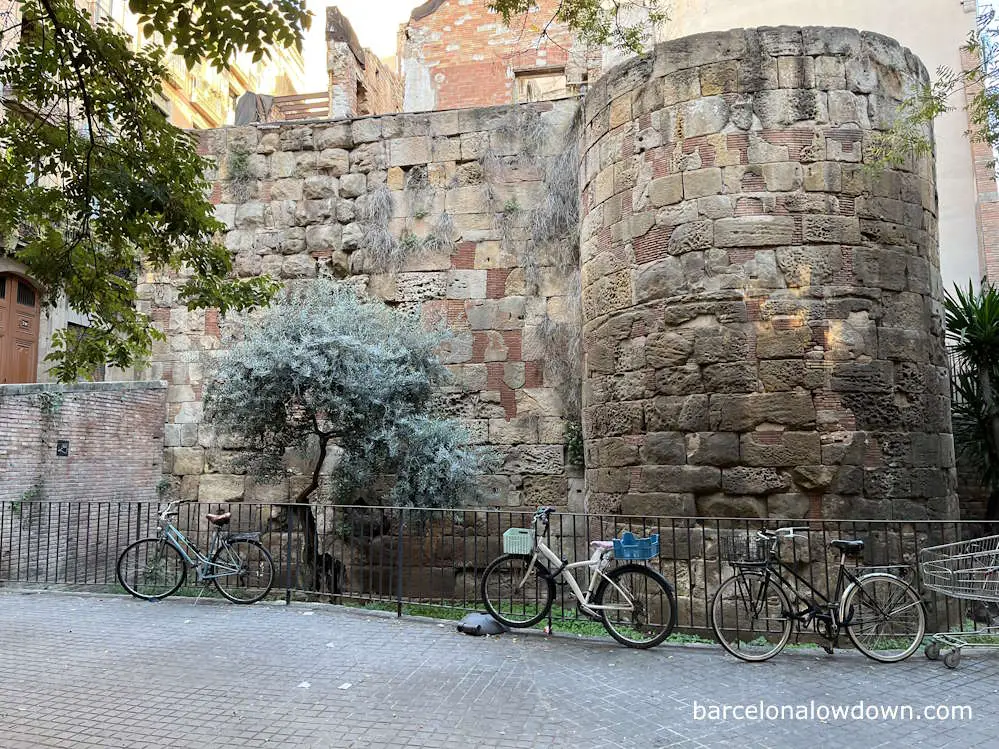
10. Hash Marihuana and Hemp Museum
At the intersection of Carre de Regomir and Carrer Ample , we find Palau Mornau , a sixteenth-century palace which currently houses the Hash Marihuana and Hemp Museum .
The museum, which is the largest of its kind anywhere in the world, explores the history of cannabis and its use in medicine, industry and popular culture. The building features an impressive Modernista interior and is well worth visiting if you have the time.
Check prices here >>
After visiting the museum, we continue southwest along Carrer Ample for two blocks until we come to the Basilica of Our Lady of Mercy .
11. Basilica of Our Lady of Mercy
The Basilica of La Mercè is an eighteenth-century Baroque-style basilica dedicated to La Mare de Déu de la Mercè , one of Barcelona’s two patron saints. The current church was built on the site of a Gothic church built in the fourteenth century.
Unlike the plain exterior, the church’s interior is elaborately decorated, and it’s worth spending a few minutes here and looking inside. The painted wooden carving of La Mercè above the altar dates back to the fourteenth century.
On the other side of the plaza, in front of the basilica, there’s a fountain with a statue of Neptune . Standing next to the fountain, you get a good view of the basilica, including the large bronze statue which crowns the dome above the altar.
There’s more information about the Basilica of Our Lady of Mercy here >>


12. Plaça de George Orwell
Next, we retrace our steps along Carrer Ample for one block to Carrer de la Carrabasa, which we follow all the way to Plaça de George Orwell .
If you fancy a break, there are several pavement cafés in the square, although, unless you see somewhere that you really like the look of, I recommend you wait a few minutes until we arrive at Plaça Reial .
Having said that, El Buen Bocado (Carrer dels Escudellers, 58) serves the best falafels in Barcelona and Vegetalia (Carrer dels Escudellers, 54) is one of the restaurants which I included in my Vegetarian’s guide to Barcelona .
13. Plaça Reial
After spending a few minutes in Plaça de George Orwell, we continue southwest along Carrer dels Escudellers for about a hundred metres before turning right into Carrer del Vidre , which leads to Plaça Reial.
Plaça Reial is an elegant Neoclassical square dating back to the nineteenth century. In the centre of the square stands a fountain called El Font de les Tres Gràcies , flanked by a pair of unusual cast iron street lamps designed by Antoni Gaudí .
The square is a hive of activity at almost any time of day and is a perfect place to stop for a coffee or a beer at one of the many pavement cafés.
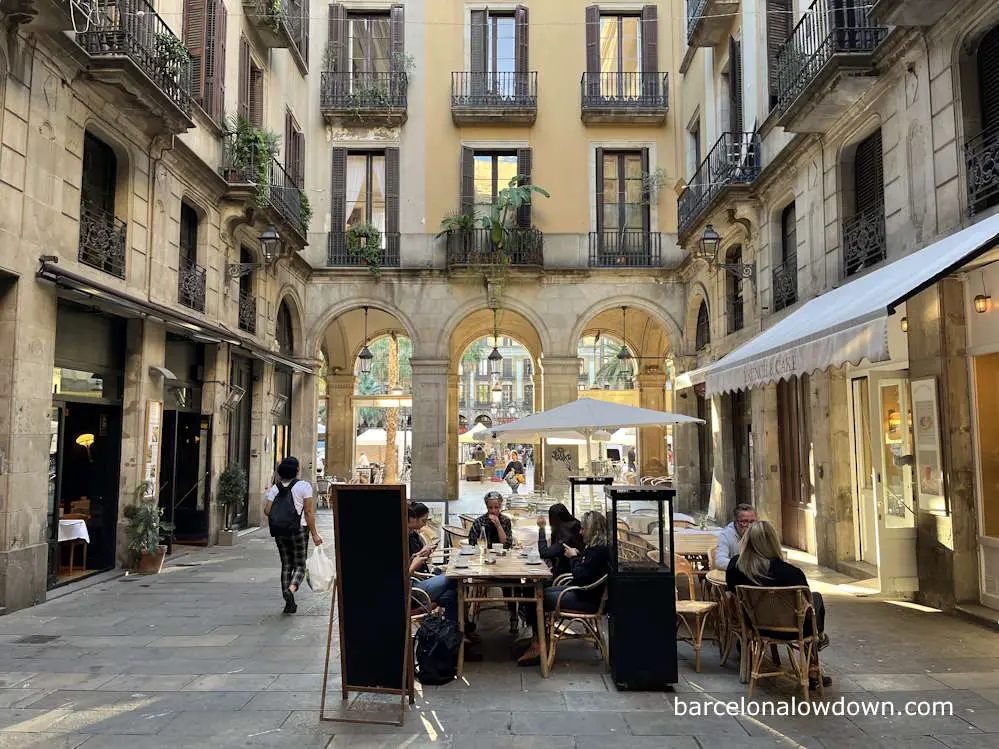
14. Església de Sant Jaume
After a short break at Plaça Reial , we continue along Passatge Madoz under the arches to Carrer de Ferran , where we turn right.
Continuing along Carrer de Ferran for about a hundred metres, we come to the Church of Saint James (Catalan: Església de Sant Jaume), which is a small fourteenth-century church that was built on the site of a synagogue which, along with many of the buildings in Barcelona’s medieval Jewish quarter , was torn down after the violent pogroms of 1391.
Although the church was built in the fourteenth century, most of the building’s Gothic façade dates back to the nineteenth century when the church was remodelled. Inside the church, there’s an impressive carved altarpiece that once belonged to Barcelona Cathedral .
After visiting the church, we continued along Carrer de Ferran to Carrer d’Avinyo , the narrow street which inspired the painting Les Demoiselles d’Avignon by Pablo Picasso . Here, we turn left and enter the narrow streets of El Call .
After a few metres, we come to an old-fashioned hat shop called Sombrerería Obach, where we turn right into Carrer del Call . As I mentioned earlier, on the first floor of the hat shop, there’s a small stone window, which is all that remains of the three castles which were built after Barcelona was attacked in 985 AD.
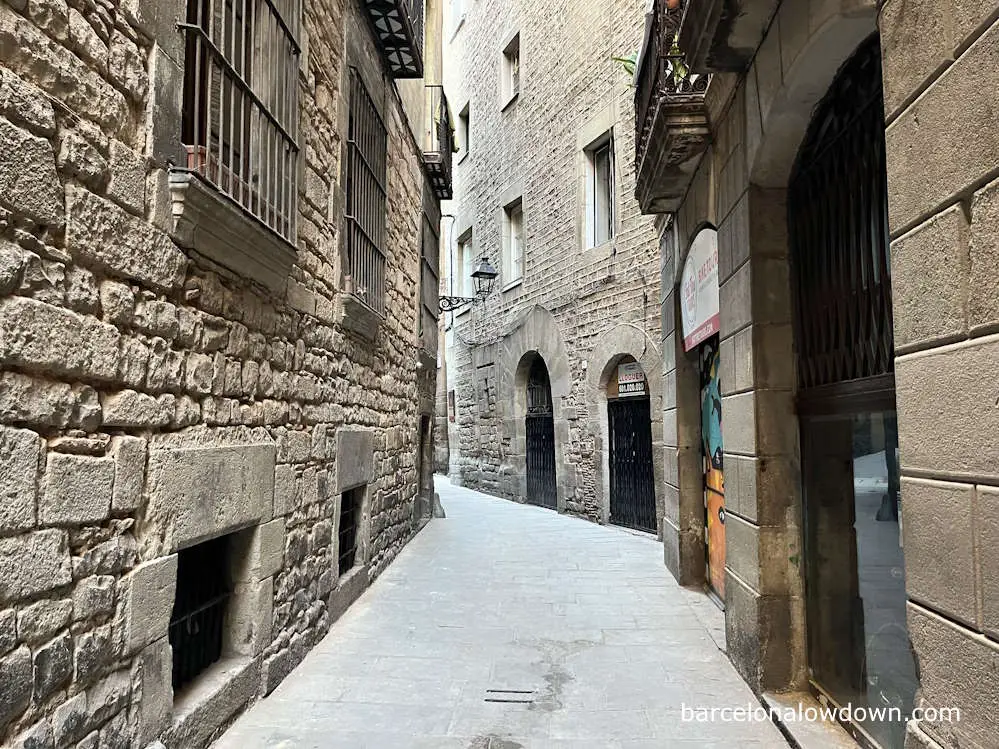
15. Shlomo Ben Adret Synagogue
After passing the hat shop, we turn left along Carrer de l’Arc de Sant Ramon del Call . A few metres later, we turn right into Carrer de Marlet, one of the narrowest streets in the Gothic Quarter.
On the left-hand side is the entrance to the Shlomo Ben Adret Synagogue , which dates back to the third or fourth century and is one of the oldest synagogues in Europe. The synagogue contains a small museum and is open to the public from Sunday to Friday.
After visiting the synagogue, we turn left along Carrer de Salomó Ben Adret . A few metres later, we come to a tiny plaza called Plaçeta de Manuel Ribé and the MUHBA El Call museum.
16. MUHBA El Call
The MUHBA El Call museum is a small museum which recounts the history of Barcelona’s Jewish community. The museum, which is housed in a historic medieval building, contains a collection of ceramics and other archaeological remains.
The museum is very small and only takes about fifteen minutes to visit. Entrance is included with the ticket to the Barcelona History Museum , which we visited earlier.
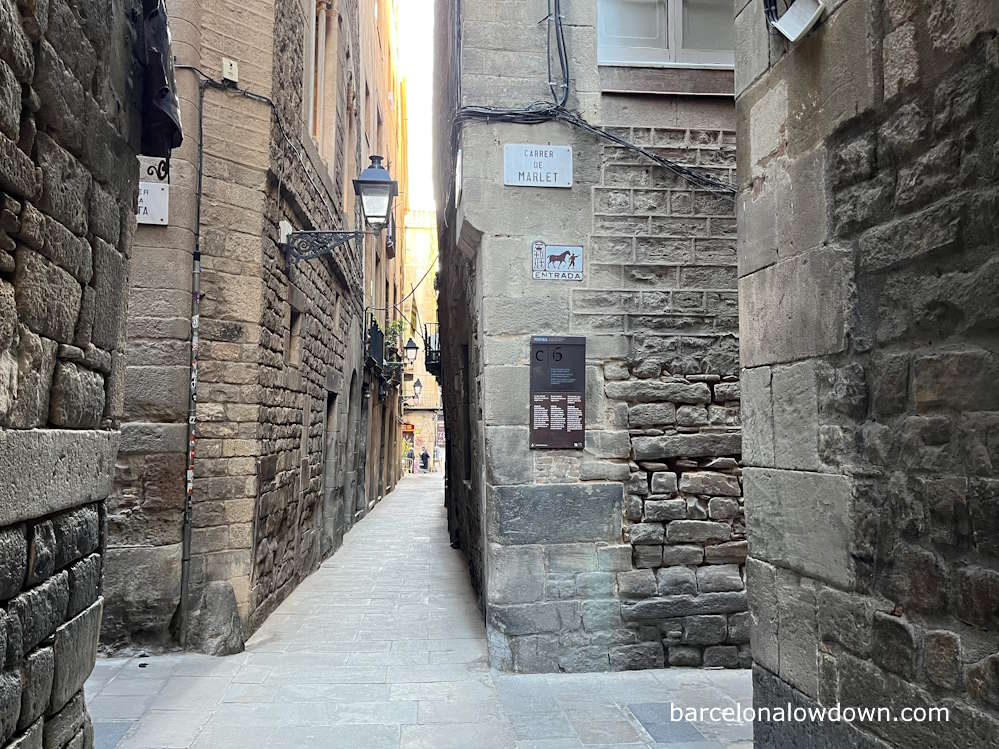
17. Plaça del Pi & Santa Maria del Pi
From the MUHBA El Call museum, we turn left and retrace our steps along Carrer de l’Arc de San Ramon del Call back to Carrer del Call, where we turn right.
After passing the hat shop, we walk two blocks along Carrer de la Boqueria before turning right onto Carrer d’Alsina . After a few metres, we come to a small plaza called la Plaçeta del Pi and the Basilica of Santa Maria del Pi , a Gothic church which dates back to the fourteenth century.
The church is flanked by three small plazas, which used to be graveyards: la Plaçeta del Pi , Plaça de Sant Josep Oriol and Plaça del Pi .
On weekends, Plaça de Sant Josep Oriol hosts a colourful artists market, where local artists set up stalls and sell their paintings. Plaça del Pi has another small open-air market selling locally produced cheese, honey and deli items.
As you walk around the basilica, you’ll notice the words Plaça del Miliciá Desconegut daubed on the walls of the church. This is the oldest piece of graffiti in Barcelona and dates from 1937. There’s more information in this post .
If you have time, it’s worth going inside the church, although much of the original interior decoration was destroyed by fire in 1936 and has been replaced. The bell tower is open to the public and affords great views of the Gothic Quarter .

18. Petrixol Street
From the Plaça del Pi, we head down Carrer de Petrixol , also known as Chocolate Street , thanks to the number of restaurants specialising in hot chocolate (Catalan: xocolata desfeta) located here. It goes without saying that this is an ideal place to take a break and enjoy a cup of hot chocolate accompanied by a plate of sugary churros.
The longest-established xocolaterias are Granja la Pallaresa (Carrer de Petrixol, 11) and Granja Dulcinea (Carrer de Petrixol, 2), both of which are very popular with the locals.
19. Roman burial ground
After satisfying our chocolate cravings, we continue along Carrer de Petrixol and turn right onto Carrer de la Portaferrissa . Almost immediately, we turn left onto Carrer d’En Bot, which leads to Plaça de la Vila de Madrid .
In the middle of the plaza is the MUHBA Via Sepulcral Romana , an ancient Roman burial ground where stone tombs were uncovered in the 1940s. A small museum here explains the site’s history and is included in the ticket for the MUHBA Plaça del Rei that we visited earlier.
20. Plaça de Josep Oriol
From here, we continue along Carrer de Francesc Pujols to Carrer del Duc where we turn left, then right onto Carrer del Pi , which takes us back to Plaça de Sant Josep Oriol , one of the three plazas beside the Basilica del Pi .
21. Baixada de Santa Eulalia
We follow Carrer de l’Ave Maria from the plaza to the intersection with Carrer dels Banys Nous , where we turn left. After turning left, we come to a narrow alley called La Baixada de Santa Eualalia .
On the right-hand side of the alleyway, just above head height, there’s a small shrine dedicated to Santa Eulalia, one of Barcelona’s co-patron saints, who was supposedly pushed down the alleyway in a barrel.
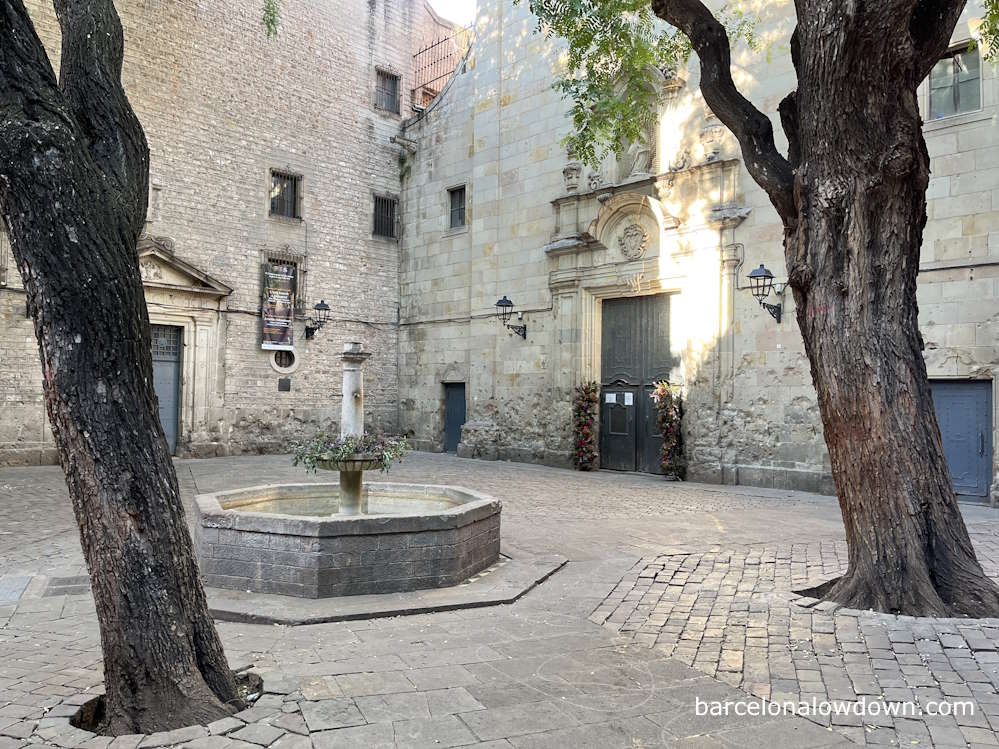
22. Plaça de Sant Felip Neri
After about a hundred metres, La Baixada de Santa Eulalia changes into Carrer de Sant Sever , and we turn left into Carrer de Sant Felip Neri , which leads us to the Plaça de Sant Felip Neri , one of the most picturesque squares in Barcelona .
The square takes its name from the church of Sant Felip Neri , a tiny Baroque-style catholic church dating back to the eighteenth century. The church’s pockmarked façade is a sombre reminder of the Spanish Civil War , when two bombs exploded in the square, killing 42 people, mostly children, who were sheltering inside the church.
23. Bishop’s Bridge
After taking a few photos, we continue along Carrer de Montjuïc del Bisbe past the church of Sant Sever to Carrer del Bisbe, which runs between Barcelona Cathedral and the Palau de la Generalitat .
Where the lanes meet, there’s a tiny plaza with a monument dedicated to five Barcelona residents who were executed during the Peninsula War , when French troops occupied Barcelona during the nineteenth century.
To our right, we get an excellent view of the Bishop’s Bridge , the small neo-gothic enhancement added during the Gothic Quarter’s facelift, which I mentioned earlier in this post. The buildings on either side of the bridge date back to the thirteenth and fourteenth centuries and are genuine Gothic.
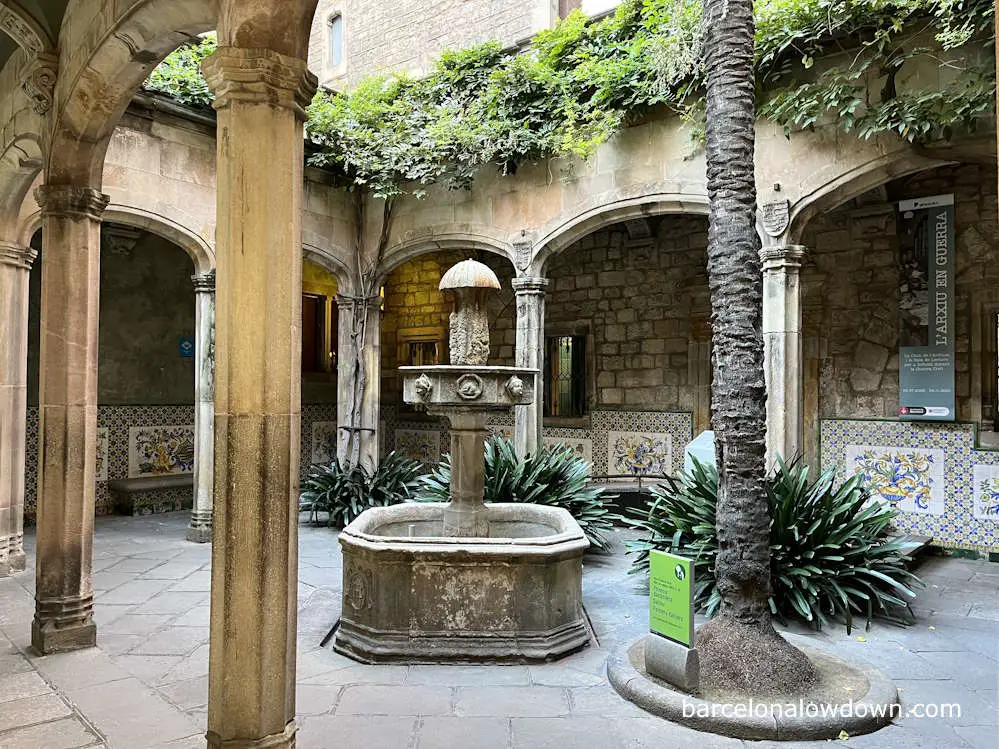
24. Casa de l’Ardiaca & Plaça Nova
From here, we continue northeast along Carre del Bisbe to Plaça Nova , the large square in front of Barcelona Cathedral .
Just before we enter the square, we come to the Casa de l’Ardiaca , which dates back to the twelfth century. This unusual Gothic building used to belong to Barcelona Cathedral but now houses the city archives and can be visited free of charge from 10 a.m. to 7:30 p.m.
Over the centuries, the building has been added to and remodelled several times, and it’s worth looking inside to check out the courtyard.
From here, we pass between two large stone towers, which are part of the Roman walls. Beside the towers, embedded in the walls of the Casa de l’Ardiaca, there’s a replica of a section of the Roman aqueduct which used to bring water to the city.
25. Barcelona Cathedral
Barcelona’s stunning Gothic cathedral, el Catedral de la Santa Creu i Santa Eulalia , dates back to the thirteenth century and was built on the site of an earlier Romanesque cathedral, which in turn replaced an earlier cathedral, believed to have been built during the fourth century.
Like most great European cathedrals, Barcelona Cathedral was built in several stages and took over a century to complete. Construction started in 1298, and the original façade and the cloisters were finished in 1448. As mentioned earlier, the ornate Neo-Gothic façade was added much later and completed in 1913.
Although it is possible to visit part of the nave free of charge by pretending that you are there to pray, I recommend you purchase a ticket which gives access to the rest of the Cathedral, including the crypt, the roof terraces, the choir and the cloisters.
There’s more information about visiting Barcelona Cathedral in this post .
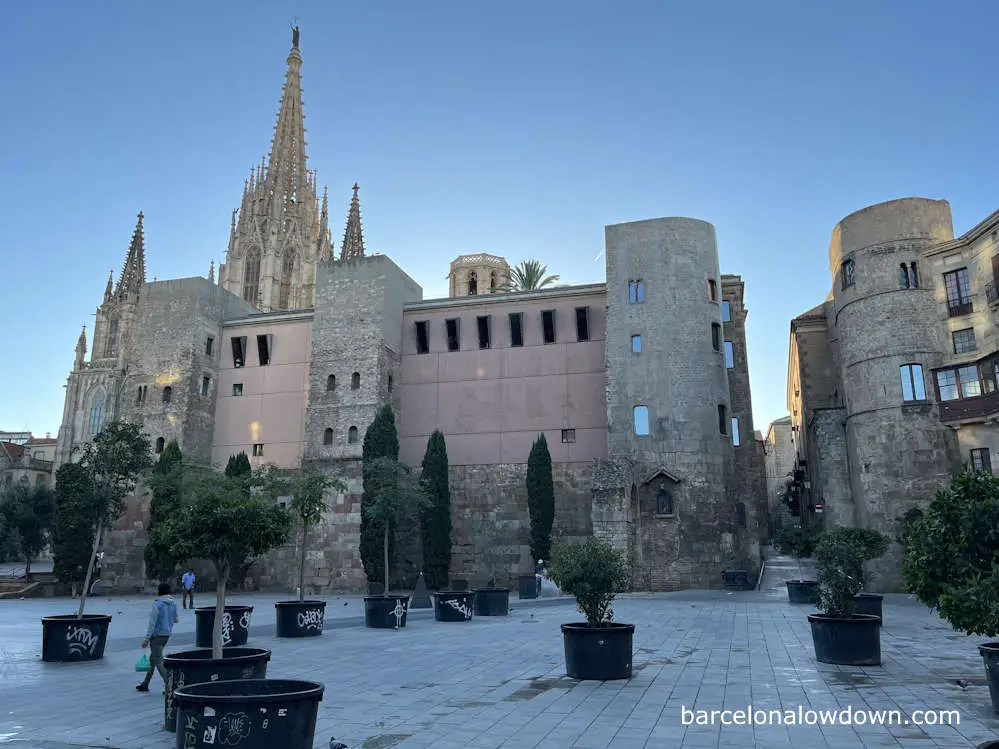
26. Plaça de Ramon Berenguer
After visiting the cathedral, we continue along Carrer de la Tapineria to Plaça de Berenguer el Gran, where we can see a section of Barcelona’s original Roman walls and an equestrian statue of Ramon Berenguer III , one of the counts who governed Barcelona during the middle ages.
The plaza is a few metres from the Jaume I metro station and marks the end of our self-guided walking tour of Barcelona’s Gothic Quarter.
Map of Barcelona’s Gothic Quarter
I’ve marked the places visited on the map below. When following the walking tour, I recommend you install the Wikiloc app on your phone and download the trail here .
Pl. de Ramon Berenguer el Gran, Barcelona, España
Pla de la Seu, s/n, Barcelona
Plaça Nova, 08002 Barcelona, España
Carrer del Bisbe, Barcelona
Pl. de Garriga i Bachs, Barcelona
Plaça de Sant Felip Neri, Barcelona
Baixada de Santa Eulàlia, Barcelona
Plaça de Sant Josep Oriol, Barcelona
Pl. de la Vila de Madrid, Barcelona
Carrer de Petritxol, Barcelona
Plaça del Pi, 7, Barcelona
Placeta de Manuel Ribé, 3, Barcelona
Carrer de Marlet, 5, Barcelona
Carrer de Ferran, 28, Barcelona
Plaça Reial, Barcelona
Carrer de n’Arai, 9999, Barcelona
Carrer de la Mercè, 1, Barcelona
Carrer Ample, 35, Barcelona
Plaça dels Traginers, Barcelona
Plaça de Sant Just, Barcelona
Plaça de Sant Jaume, 1, Barcelona
Carrer del Paradís, 10, Barcelona
Plaça del Rei, s/n, Barcelona
Pl. del Rei, s/n, Barcelona
Plaça de l’Àngel, Barcelona
The Gotic Quarter is a popular area and is conveniently located close to many of Barcelona’s top sights. There are plenty of hotels in the area to suit all budgets.
I recommend staying between the cathedral and Plaça de Catalunya . This area has several good-value hotels, including Hotel Barcelona Catedral , a comfortable, four-star hotel with a rooftop pool.
For more information about where to stay in Barcelona , check out my in-depth Barcelona neighbourhood guide .
Most of the museums mentioned in this post are covered by the Barcelona Card , the official Barcelona sightseeing card issued by the Barcelona Tourist Office .
In addition to access to many of Barcelona’s top attractions and tours, the Barcelona Card also includes unlimited travel by public transport, including the airport metro.
By purchasing the Barcelona Card online from the official Tourist Office website, you can benefit from an extra 10% discount and can pick up your card at the airport on arrival.
More information here >>
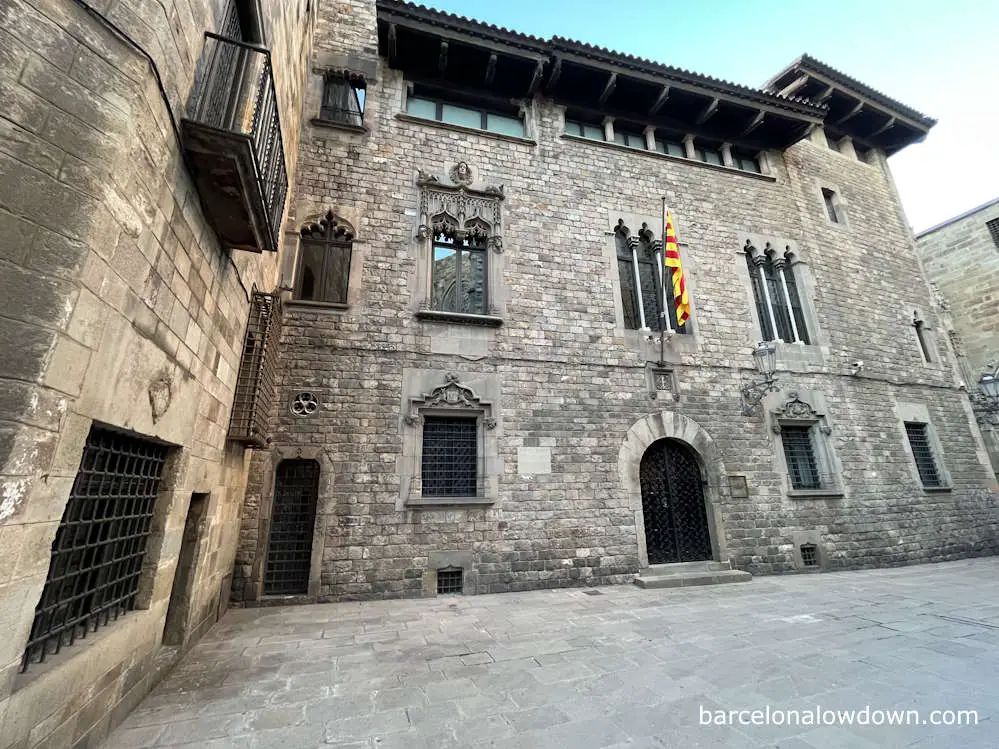
Tours of Barcelona’s Gothic Quarter
If you want to learn as much as possible about the history of the Gothic Quarter, I recommend you book one of the walking tours operated by the Barcelona Tourist Office .
The tours last two hours, and visit many of the sites mentioned in this post. The fully licensed guides speak fluent English, are well-versed in Barcelona’s history, and will be able to answer any questions you may have.
Barcelona Card holders get a 50% discount on the tour price. More information here >>
As always, if you’ve any questions or think I’ve missed anything, please leave a comment below and I’ll get back to you as soon as possible.
Related posts:
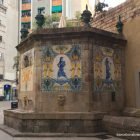
Leave a comment Cancel reply
Your email address will not be published. Required fields are marked *
Save my name, email, and website in this browser for the next time I comment.
Barcelona: The Gothic Quarter Self-Guided Walking Tour
Nestled within the vibrant streets of Barcelona like a time capsule waiting to be opened, the Gothic Quarter beckons visitors to unravel its tales. As travelers meander through its ancient passageways and intricate architecture , they are transported to a bygone era where history whispers through every stone.
Discovering hidden courtyards, grand plazas , and intriguing nooks , explorers are invited to uncover the secrets of this captivating neighborhood. But what mysteries lie within the shadows of Barcelona’s Gothic Quarter?
- Enjoy Barcelona’s Gothic Quarter on a self-guided walking tour.
- Uncover medieval history, architecture , and local legends.
- Indulge in traditional cuisine and explore artistic influences .
- Discover hidden gems, vibrant street art , and architectural marvels in this historic neighborhood.
Here's some more nearby activities we've reviewed
- Moco Museum Barcelona, Banksy & More
- The Original Girona & Costa Brava Small Group Tour Hotel Pickup
- The Legendary Steel Donkey Off the Beaten Track Bike Tour
- Morning Access to Montserrat Monastery (Mar )
Tour Highlights
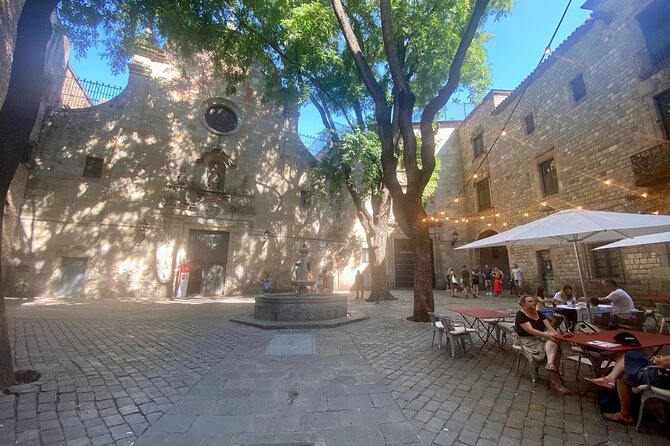
Set out on an exploration of the Barcelona Gothic Quarter Walking Tour to uncover the enchanting blend of history, architecture, and legends that define this captivating district. As you stroll through the narrow medieval streets, be sure to indulge in the local cuisine that the area has to offer.
From traditional tapas to savory paella , the Gothic Quarter is a paradise for foodies. On top of that, the district boasts an artistic flair that’s evident in the numerous galleries and street art installations that adorn the walls.
Enjoy the vibrant artistic scene and witness firsthand the creativity that permeates every corner of this historic neighborhood. Barcelona’s Gothic Quarter truly offers a feast for the senses, blending culinary delights with artistic wonders.
Must-See Landmarks
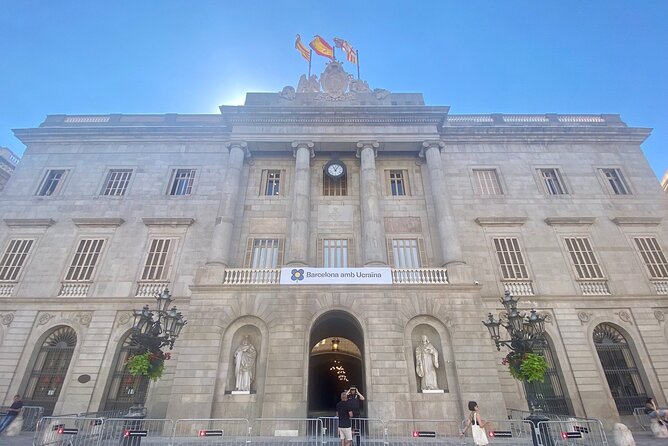
Explore the Barcelona Gothic Quarter’s must-see landmarks that showcase centuries of history and architectural marvels waiting to be discovered around every corner.
Start your journey at the iconic Barcelona Cathedral, a masterpiece of Gothic architecture. Wander through the narrow streets to find the Plaça del Rei, a historic square surrounded by medieval buildings like the Palau Reial Major.
Don’t miss the Plaça Sant Jaume, home to the City Hall and the Palace of the Generalitat of Catalonia. As you explore, take a moment to sample some local cuisine in one of the charming cafes or tapas bars.
From the stunning facades of the buildings to the intricate details of the structures, the Gothic Quarter is a treasure trove of architectural marvels.
Historical Insights
Explore the rich tapestry of Barcelona’s past as you uncover intriguing historical insights woven into the very fabric of the city’s Gothic Quarter.
The area teems with architectural marvels that tell stories of a bygone era, blending seamlessly with local traditions that have stood the test of time.
Mysterious legends shroud the narrow alleyways and medieval buildings, adding an air of enchantment to the surroundings.
On top of that, the Gothic Quarter bears witness to various artistic influences , from stunning sculptures to elaborate facades, showcasing the creativity and skill of the craftsmen who left their mark on the neighborhood.
Explore these historical gems as you wander through the labyrinthine streets, each corner revealing a piece of Barcelona’s captivating past.
Cultural Gems
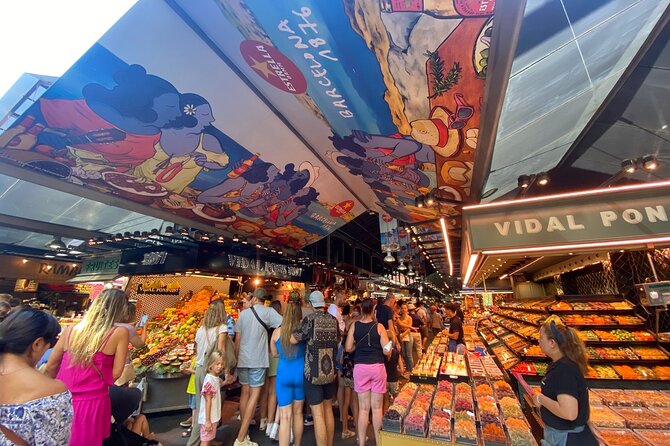
In Barcelona’s Gothic Quarter, visitors can uncover a trove of cultural gems waiting to be discovered amidst the ancient cobblestone streets and historic architecture. The neighborhood is not only rich in history but also offers a vibrant showcase of local cuisine and traditional crafts . Enjoy the flavors of Catalonia by trying traditional dishes like Paella or Crema Catalana, and explore the narrow alleys lined with shops selling handmade pottery, leather goods , and unique souvenirs. The Gothic Quarter provides a perfect blend of old-world charm and contemporary creativity, making it a must-visit destination for those seeking an authentic cultural experience in Barcelona.
Hidden Gems to Discover
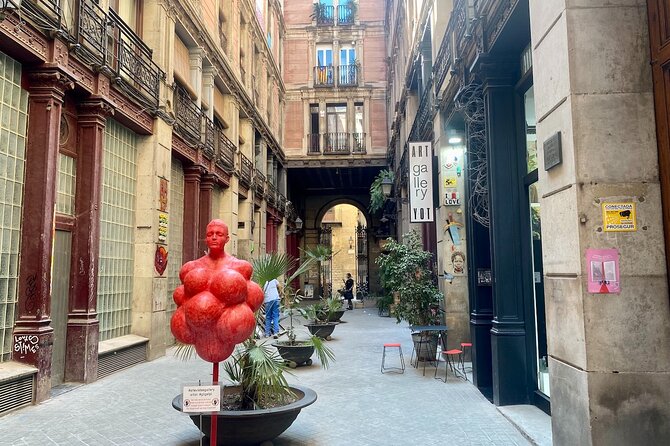
Uncover the lesser-known treasures tucked away in the intricate maze of Barcelona’s Gothic Quarter, revealing hidden gems waiting to captivate curious explorers.
Local Cuisine: Dive into the culinary delights of the Gothic Quarter, where charming cafes and traditional tapas bars offer a taste of authentic Catalan dishes.
Street Art: Explore the vibrant street art scene hidden within the narrow alleyways, showcasing a mix of local and international artists’ creativity.
Architectural Marvels: Discover hidden architectural wonders like secluded courtyards, ornate facades , and ancient structures that narrate the rich history of Barcelona’s past.
These hidden gems provide a deeper insight into the soul of the neighborhood, offering a unique perspective beyond the well-known attractions.
Self-Guided Itinerary
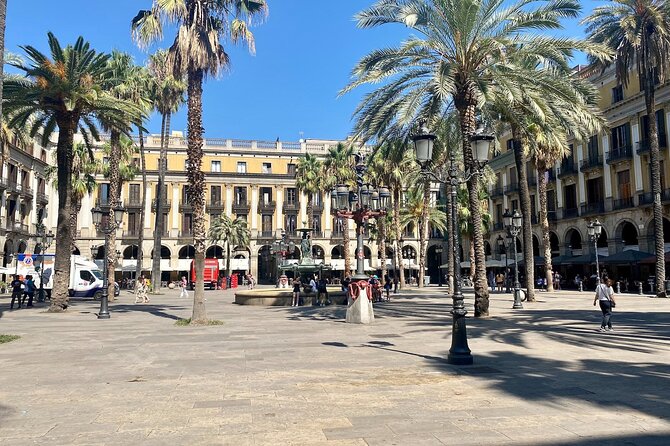
Set out on a fascinating journey through Barcelona’s Gothic Quarter with a self-guided itinerary that promises to unveil hidden gems and historical wonders at your own pace.
Utilize interactive maps on your smartphone to navigate the labyrinthine streets, discovering tucked-away corners and ancient architecture.
As you wander, be sure to sample the delightful local cuisine at charming cafes and eateries along the way. From traditional tapas to mouth-watering paella, the Gothic Quarter offers a culinary experience not to be missed.
Enjoy the rich history and vibrant culture of this historic neighborhood, all while enjoying the flexibility and freedom of a self-guided exploration.
Here's a few more nearby tours and experiences we have reviewed.
- Girona & Dali Museum Small Group Tour With Pick-Up From Barcelona
- Sagrada Familia & Barcelona Small Group Tour With Hotel Pick-Up
- Skip the Line: Erotic Museum of Barcelona Admission Ticket With Free Souvenir
- Sunset Jazz Cruise in Barcelona
- Barcelona Highlights Private Guided Tour With Hotel Pick-Up
- Montserrat Monastery & Hiking Experience From Barcelona
Tour Last Words
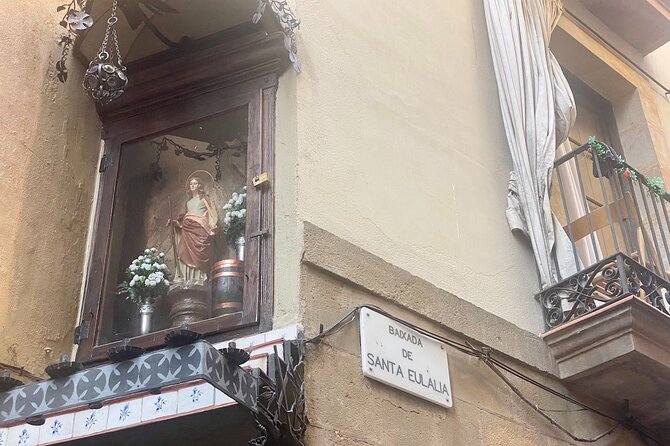
Discover the highlights and lasting impressions of Barcelona’s Gothic Quarter Walking Tours as the journey through its historic streets comes to an end.
Tour Highlights: Marvel at the intricate architecture of the Barcelona Cathedral, explore the history of Plaça del Rei, and wander through the charming narrow alleys lined with artisan shops.
Local Cuisine: Indulge in traditional Catalan dishes at local eateries, savoring the flavors of tapas, paella, and churros.
Memorable Moments: Enjoy panoramic views from the Mirador del Rei Martí, immerse in the lively atmosphere of Plaça Reial, and appreciate the blend of ancient and modern influences in this vibrant neighborhood.
As the tour concludes, the Gothic Quarter leaves visitors with a deep appreciation for Barcelona’s rich cultural heritage and culinary delights.
Here's more of our most recent tour reviews happening neaby
- Barcelona: Romantic Private Sailing Tour
- Spanish Group Course in Barcelona, Spain: 20 Lessons
- Private Airport Transfer Barcelona
- Try Find Your Better Than Us ! Airport Transfer in Barcelona APT-HTL (Bcn)
- Barcelona Camp Nou and Museum Expert Guided Tour
- Barcelona: Treasures & Jamón Experience
- Barcelona: Private Transfer Barcelona – Benidorm
- High-Performance Speed Sport Boat Barcelona-Novurania Yacht
- Private Thai Massage Session in Barcelona
- Barcelona: Ferrari Driving and Helicopter Experience
- Sunrise in Barcelona, SUP With Certified Guides
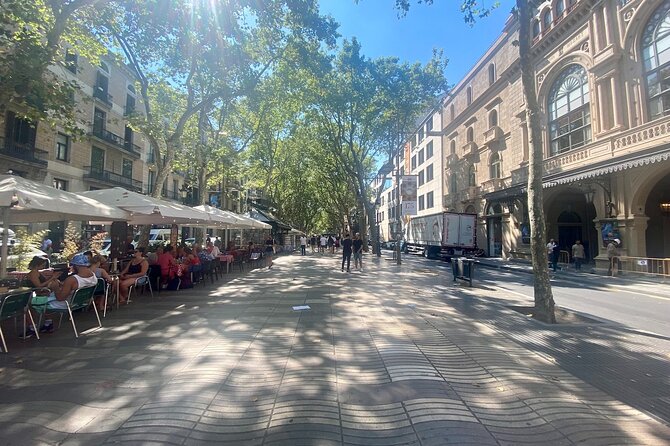
To sum it up, the Gothic Quarter self-guided walking tour in Barcelona offers a captivating journey through history, culture , and legends in the heart of this vibrant city.
From must-see landmarks to hidden gems waiting to be discovered, travelers can enjoy the rich tapestry of Barcelona’s past and present at their own pace.
With the convenience of an audio guide on their phones, this tour promises an unforgettable experience for all who wander its cobblestone paths.
Similar Posts
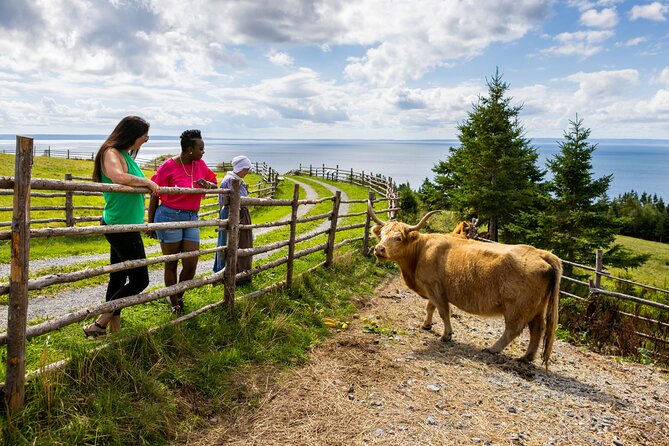
Shore Excursion of the Highland Village Museum in Cape Breton
Set out on a captivating journey through time and culture with a shore excursion to the Highland Village Museum in…

Kathmandu to Pokhara Deluxe Tourist Bus Ticket
Have you ever wondered if traveling from Kathmandu to Pokhara could be both luxurious and affordable? The journey aboard a…

Crete: Taxi Transfers From Heraklion Airport to Rethymno City
Navigating the journey from Heraklion Airport to Rethymno City in Crete is an endeavor often filled with anticipation and eagerness…
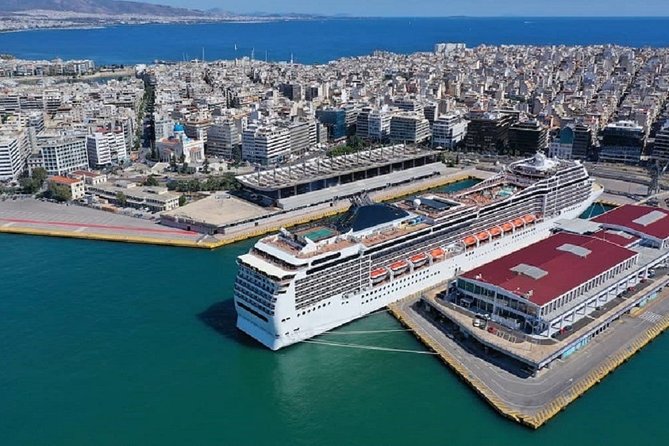
Private Transfer From Athens International Airport (Ath) to Piraeus Port
In the world of travel, ‘time is of the essence.’ When navigating from Athens International Airport to Piraeus Port, a…
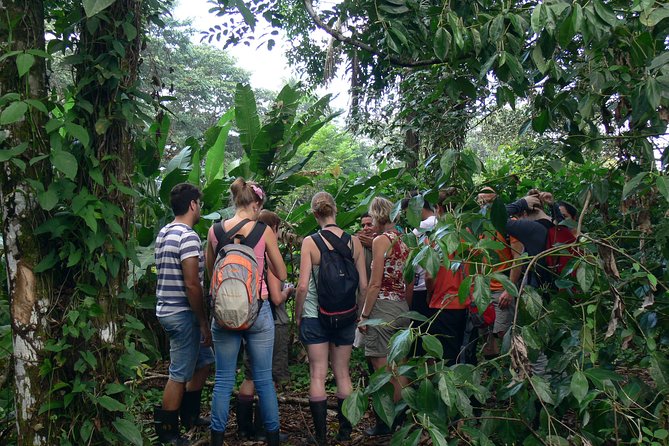
The Best of Tortuguero: Canoe, Hike and Night Tour (Turtle in Jul-Oct)
Set out on a journey of unparalleled discovery in Tortuguero National Park with the ‘Canoe, Hike, and Night Tour’ that…

Lisbon: Azeitão Cheese Workshop With Wine & Food Tasting
As visitors wander through the charming streets of Lisbon, they might stumble upon a hidden gem waiting to be uncovered:…
Barcelona's El Raval and the Gothic Quarter: A Self-Guided Audio Tour

- Lifetime access to this tour in English
- VoiceMap app for Android and iOS
- Offline access to audio, maps, and geodata
- Tickets or entrance fees to any museums or other attractions en route
- Smartphone and headphones
- Transportation
- Food and drink
- Font de Canaletes, La Rambla, 133, Ciutat Vella, 08002 Barcelona, Spain Before arrival, please install the mobile app and use the code provided on your confirmation ticket. This is a self-guided audio tour that you can start, pause, or restart at any time and complete at your own pace. Detailed starting point instructions are available after downloading.
- Not wheelchair accessible
- Confirmation will be received at time of booking
- Most travelers can participate
- This is a private tour/activity. Only your group will participate
- All sales are final and incur 100% cancellation penalties.
- Gothic Quarter (Barri Gotic)
- Mercat de la Boqueria
- Barcelona Cathedral
- Palau Güell
- Plaça Reial
Similar experiences

- You'll start at Font de Canaletes La Rambla, 133, Ciutat Vella, 08002 Barcelona, Spain Before arrival, please install the mobile app and use the code provided on your confirmation ticket. This is a self-guided audio tour that you can start, pause, or restart at any time and complete at your own pace. Detailed starting point instructions are available after downloading. See address & details
- Pass by El Raval Gothic Quarter (Barri Gotic) La Rambla Barcelona's Baby Drop-off Mercat de la Boqueria El Gat de Botero Palau Guell Placa Reial Restaurant Can Culleretes Carrer d'Avinyó Placa Sant Jaume Mesón del Cafè 1909 Pont del Bisbe Placa Sant Felip Neri Barcelona Cathedral Plaça Nova Plaça d'Isidre Nonell Plaça de la Vila de Madrid
- You'll return to the starting point
More to explore in Barcelona

Most Recent: Reviews ordered by most recent publish date in descending order.
Detailed Reviews: Reviews ordered by recency and descriptiveness of user-identified themes such as wait time, length of visit, general tips, and location information.

Buy it with

Barcelona's El Raval and the Gothic Quarter: A Self-Guided Audio Tour provided by VoiceMap

A Free & Self-Guided Barcelona Walking Tour
By: Author Sophie Nadeau
Posted on Last updated: 4th October 2023
Categories Spain , walking tour
Last Updated on 4th October 2023 by Sophie Nadeau
Between endless plates of tapas, all the art nouveau architecture, and an abundance of hidden gems you’ve never heard of before (but totally should have done) , there’s no shortage of epic experiences to be had when exploring Barcelona, especially if you plan to see the city by foot. Here’s your ultimate free and self-guided Barcelona walking tour to help you get the most out of a visit to the capital city of Catalonia.

If you’re thinking about seeing a lot of attractions and monuments while in the region of Catalonia, Consider purchasing the 12-Month Unlimited Visits Catalonia Monument Pass , which includes access to 29 museums, monuments and historical sites throughout Catalonia.
To work out whether or not the pass is worth it for you or not, add up the cost of the individual attractions you wish to visit and see if you’ll save money. Find more details here.

Free Barcelona Walking Tour: Practical Advice, Tricks, and Tips
Plaça reial, artisa barcelona, palau güell (guëll palace), mercat de la boqueria, plaça de catalunya, libreria altaïr, casa battló, palau macaya, plaça de la sagrada familia, la sagrada familia, arc de triomf, parc de la ciutadella, basilica de santa maria del mar (basilica of saint mary of the sea), museu picasso de barcelona (picasso museum of barcelona), catedral de barcelona (barcelona cathedral), enjoyed reading this free and self-guided barcelona walking tour pin this article now, read it again later:.
The walk is best attempted on a sunny day when the streets are warm, a summer vibe is in the air, and the city looks its best. You’ll want to bring along a camera to snap some of the best of Barcelona, and so here are some of my very best travel camera recommendations !
Although the majority of the tour is on level roads (with a few cobbled hilled lanes thrown in) , I highly recommend shoes that are comfortable to walk in like these ones .
Otherwise, it’s worth noting that Barcelona can become incredibly hot (especially during the summer months) and so you’ll want to bring a reusable water bottle like this one with you.
As you might expect with a major European city, there are plenty of places to eat, hydrate, and caffeinate en route. And from budget eats to vegetarian fare to speciality coffee shops, you should know that Barcelona has plenty to offer!
Before you visit Barcelona, one of the most important things to know before you go is that many of the major attractions need to be booked ahead of time. To help you plan your trip, check out our guide on what to book in advance in Barcelona .
For even more inspiration before your trip to Catalonia, be sure to check out these beautiful quotes about Barcelona. For more general inspiration, then be sure to check out our top Spain quotes . So put on your comfiest clothing and enjoy this free Barcelona walking tour…
Walking Time: 1 hour 40 minutes
Distance Covered: 7.9 km
This self-guided walking tour of Barcelona begins in the beautiful pedestrian square of Plaça Reial. Situated in the Gothic Quarter of the city (and the place where I recommend booking a place to stay if you want to be close to all of the best attractions and foodie spots) , the plaza boasts a number of nightclubs, bars, and hotels.
Take a moment to orient yourself and load up your map before venturing out into the city. Otherwise, be sure to enjoy the stunning palm trees which litter the square (whose name translates into Royal place) and the King Ferdinand VII statue in the very centre of the square.

Start your day the right way (or, at the very least, your time exploring Barcelona on foot) by fuelling up with a breakfast formula, or tasty ice cream depending on the time of the day.
While a little bit more touristic than some of the other cafés in the city, there’s no denying the deliciousness of the coffee and patisseries on offer at ARTiSA Barcelona.
This café and confectionery shop offers indoor and outdoor seating, making it a suitable base to enjoy a quick bite come rain or shine. Well-reviewed across many sites, the café was opened in late 2009 and offers a variety of authentic Catalan produce at good prices.

Situated on Carrer Nou de la Rambla, this former mansion house was created by Antoni Gaudi at the behest of a wealthy businessman, Eusebi Güell, who wished to have an abode in the El Raval district of Barcelona.
Created in the late 19th-century, this house boasts all of the architectural features which are so quintessentially Gaudi; natural forms inspire carved brick and beautiful balconies. Today, you can visit the Palace for a small fee. Find more details here.

For the freshest, most authentic, and best local eats in town, be sure to head to the covered marketplace that is Mercat de la Boqueria. Fully known as Mercat de Sant Josep de la Boqueria, this thriving foodie spot has stalls ranging from beer stands to fish vendors to fresh vegetable sellers.
There has been a market of sorts on site since at least the 13th-century when the food court was mentioned as stalls selling meat close to the city gate.
During the 19th-century, the market was officially recognised, leading to the thriving Mercat de la Boqueria you can enjoy today. If you’re visiting Barcelona for several days, then a visit to the market is recommended in our 3 days in Barcelona itinerary .

Offering a fantastic glimpse of much of the different architectural styles that Barcelona has to offer; this is where the 19th-century buildings of the Eixample district meet the historic architecture of the old town district of the city, Plaça de Catalunya is one of the largest public squares in the city.
Take a moment to pause, sit on one of the many benches on the plaza, and watch the world go by. Otherwise, be sure to check out the beautiful architecture of the theatre, cafés, and restaurants which surround the public space. There are also sculptures dotted across the Plaza which represent several different styles.

Hands down, one of the best bookshops in Barcelona is that of the Altaïr Bookshop. After all, this book vendor is filled with shelves stacked from floor to ceiling, all dedicated to travel. Organised by region, there’s a huge section on Spain, and an even larger section on Catalonia, and on Barcelona.
It’s worth noting that while most of the books, tomes, and travel memoirs for sale were Spanish language, there were still plenty of works available to purchase in English and French. I personally even managed to pick up a book on secret Barcelona on my visit (even though my suitcase was already overstuffed!)

One of the most famous of the Gaudi buildings in Barcelona is that of Casa Battló, an organic-inspired architectural house complete with the broken-tile look that is so synonymous with Gaudi.
Constructed at the behest of Lluís Sala Sánchez, the house is often considered to be one of Gaudi’s greatest works of art. Known locally as the House of Bones ( Casa dels ossos ) thanks to its unusual form and shape, it’s worth noting that you can even go inside if you pay the entry fee.
However, you should know before you go that even the ‘skip-the-line’ pre-paid entrance ticket means plenty of waiting time in order to visit and so you should head to the house earlier in the day and mid-week if possible so as to avoid the worst of the queues.
Purchase your Casa Battló ticket here in advance.
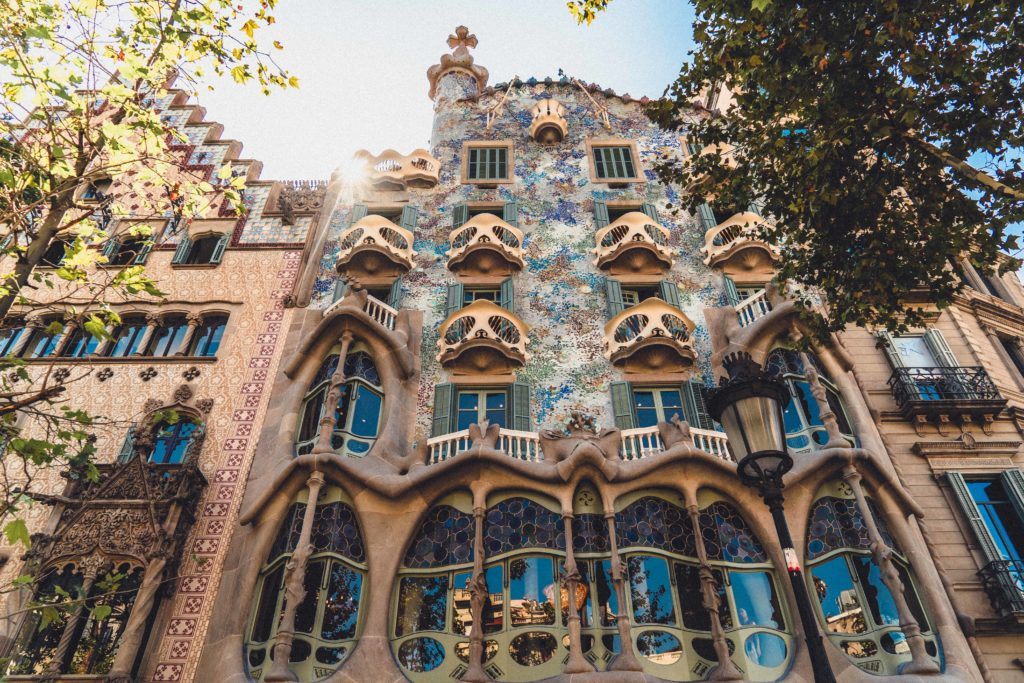
Beautiful and ornate, Palau Macaya is one of Barcelona’s best-kept secrets. Situated alongside the green space which lies beside Passeig de Sant Joan.
While you can sit and check on directions on the many benches which line the park (which also happens to offer a fantastic view of the Sagrada Familia) , the courtyard of Palau Macaya is also free to visit during opening times and is one of the best photo spots in Barcelona.

The best view of Gaudi’s beautiful ecclesiastical masterpiece (which is famously still unfinished) is not directly beneath the church itself, but instead from the small green park a little walk away.
Lined with benches and plenty of trees, this quiet and secluded spot feels miles away from the hustle and bustle of the immediate area surrounding the Gaudi building.

Next, carry on this self-guided Barcelona walking tour right towards the cathedral. This is one of the easiest steps of the self-guided tour as its hard to miss the nature-inspired towers of the Sagrada Familia presiding over the rest of the buildings in the area.
Designed by Antoni Gaudi in the 19th-century, the cathedral is perhaps so famous thanks to the fact that it’s still under construction (and has been this way for over a century).
The church was only consecrated in 2010 and today you can visit for a fee. However, you should know before visiting that this is one of the most popular buildings in Barcelona, meaning you should book your tickets well before you go.
Purchase your Sagrada Familia tickets here in advance.

Yes, you read that correctly! Barcelona, too, has a Triumphal Arch, just like the famous one in Paris , that of Montpellier, and of course, the Arcul de Triumf in Bucharest . Also known as the Arco de Triunfo de Barcelona in Spanish, this arch was constructed in 1888 to act as the main entranceway to the World’s Fair.
Today, you can wander underneath the archway of the Barcelona Arc de Triomf , all the while admiring the stunning stonework. Otherwise, be sure to sit down and rest for a moment or two beneath the palm trees swaying in the breeze and admire the architecture of this Barcelona district.

Best seen on a warm and sunny day when you can stroll around the park, enjoy a picnic in the shade, or rent a boat on the lake for the most romantic of Barcelona experiences, Parc de la Ciutadella is a must-see while in the city and is the perfect place to relax, away from the hustle and bustle of the busy rest of the city.
Created in the 19th-century, once upon a time, this was the only green space that Barcelona had to offer. Some of the main highlights of this sprawling parkland include the chance to glimpse the Palau del Parlament de Catalunya and the stunning chapel of Església de la Ciutadella.

Completely free to visit (though donations are, of course, always appreciated!), the Barcelona Basilica can be found in the Ribera district of Barcelona. One of the best examples of the Catalan Gothic architectural style, the ecclesiastical building dates all the way back to the 13th-century and a time when much of Barcelona’s main income came through sea trade.

For those who wish to marvel at a little bit of artwork during their time in Barcelona, a visit to the Picasso museum close to the Gothic quarter is an absolute must. For a closer look at the famous artist in Barcelona, be sure to book this Picasso Walking Tour & Picasso Museum of Barcelona.

Last but not least, the last stop on this free Barcelona walking tour is the Cathedral of the city, i.e. the ecclesiastical building which grants Barcelona its city status. Situated in the maze and passageways of tiny streets which snake their way through the Gothic district of the city, the Cathedral is much less frequented than the Sagrada Familia but is nevertheless still worth a visit.

Sophie Nadeau loves dogs, books, travel, pizza, and history. A Francophile at heart, she runs solosophie.com when she’s not chasing after the next sunset shot or consuming something sweet. She splits her time between Paris and London and travels as much as she can! Subscribe to Sophie’s YouTube Channel.
This site uses Akismet to reduce spam. Learn how your comment data is processed .
Kalyan Panja
Saturday 7th of September 2019
Barcelona seems so vibrant! I am so disappointed that I was not able to go there on my own recent trip to Spain. Next time!
- Skip to content
- Skip to primary sidebar
- Skip to footer

Somto Seeks
Navigate the world with confidence
Spain Bucket List: A Self-Guided Walking Tour of Barcelona
April 27, 2018 By Somto Ugwueze 35 Comments
Last Updated on March 23rd, 2023

If you know me, you know I’m madly in love with Spain! I’ve lived there twice – once as study abroad student and again as an English teacher – and traveled back many times. The other day, I came up with the idea to write a ‘Spain Bucket List’ series. Over the next two weeks, I will share 10 posts highlighting the best that Spain has to offer for first-time visitors. Barcelona is the most visited city in Spain so I figured I’d start with it. This self-guided walking tour of Barcelona with a map to introduce you to the city. This Barcelona walking tour will guide you to some of the must-see spots in the city, from the Gothic Quarter to the Gaudi architecture.
This is the first post in the Spain Bucketlist series. Here’s the complete 10-part series:
Spain Bucket List Series
Culture: 9 Experiences You Must Have in Spain
Food: 6 Dishes to Eat in Spain Besides Paella and Tapas
Packing tips: The Ultimate Packing List for Your Summer Vacation in Spain
Travel Tips: 10 Travel Tips You Need To Know Before Visiting Spain
Inspiration: 15 Photos That Will Inspire You to Visit the Cies Islands
Off the beaten path: 8 Underrated Cities You Need To Visit in Spain
Beaches: The 10 Best Beaches in Spain You Should Visit Before You Die
Solo Travel: 10 Unconventional Tips For Female Solo Travelers in Spain
Barcelona: A Self-Guided Walking Tour of Barcelona
Granada: Why Granada is the Best Place to Visit in Spain
Barcelona Walking Tour with Map for First Time Visitors
Before we dive into the walking tour, I need to throw in my two cents. I’ve visited Barcelona twice. Get ready for a shocker….
I think Barcelona is way overrated, one of the most overhyped cities in Europe.
What? I know I’m in the minority. Everyone raves about Barcelona, but to me, it’s like a giant theme park with a Spanish flair. It’s like a Disneyfied version of Spain with a few pockets of novelty. This city caters so much to tourists that I can’t quite pinpoint its personality. There’s a somewhat laid-back vibe, but overall it just feels like another big city with lots of concrete. Just being honest. I should also note that I had really high expectations because of all the hype. That’s probably why I was so underwhelmed and, dare I say, bored?
So why am I writing this post if I don’t care for Barcelona? One word: Gaudi. You’ve probably heard of him. Touring the architecture of Catalan architect Antoni Gaudi is the reason to visit Barcelona. Also, I know most first-time visitors to Spain will want to visit Barcelona, and I think they should. Go with no expectations and see for yourself. I’d recommend you stay 3-4 days in Barcelona and then head down to Granada, which is, in my humble opinion, the greatest city in Spain .
Besides Gaudi’s art, there are different neighborhoods and attractions to explore. Barcelona is a walkable city with a few hilly areas. A walking tour is one of the best ways to explore the neighborhoods and attractions. I will show you a route to visit 10 of Barcelona’s must-see spots. Here we go.
The time required for the walking tour
2 hrs 58 minutes if you follow the route without stopping. I’d recommend you reserve a half day for this tour so you can really get to know the city. You can also break it into two tours over two days to reduce the walking.
Items to pack
- Comfortable shoes – preferably running shoes since there are some hills to climb.
- Portable WiFi – having access to WiFi at your fingertips makes travel so much easier. I’ve been using the Travel WiFi Portable Hotspot device to access reliable wifi abroad for years – it’s convenient and reliable. You can read my full review of Travel WiFi to see the pros and cons of the device.
- Water – stay hydrated, my friends!
- Map or GPS – Google maps, Apple maps, the Moovit app, a physical map, whatever works best for you.
- Camera – you can use your phone camera, but a DSLR will capture those Gaudi buildings so much better! I always recommend the Nikon D3400 for beginners.
- Snacks – if you get hungry easily like me then pack some granola bars or fruit. My go-to travel snack, the WanderBar , is a protein bar made specifically for travelers and frequent flyers. I can’t get enough of the Cocoa Crunch flavor.
You may also like…
101 things to do in barcelona on a budget, a self-guided walking tour of barcelona, 1. the gothic quarter.
First stop: the Gothic Quarter. It is one of the coolest areas in Barcelona. As the name suggests, it is home to Gothic architecture dating back 2,000 years! The Romans built the structures. The Gothic Quarter is essentially the old part of the city so there’s a lot of history there. Explore the Gothic Cathedral, King’s Square (beautiful!), the narrow streets, and the tapas bars (locals say it has the best tapas in the city.) The Gothic Quarter is a nice place to just meander and get lost for a while.
While you could certainly walk aimlessly around The Gothic Quarter, you might miss a lot of details. So I’d definitely recommend a guided tour if you’re a history buff or just want to discover the hidden corners of this mysterious neighborhood. There’s a popular 2-hour Gothic Quarter Tour by one of my favorite tour companies, Get You Guide. A local guide will take you on a journey to the Middle Ages and tell you some out-of-this-world tales about the ancient palaces of kings and bishops. I did this tour, and it was one of the highlights of my second visit to Barcelona!

2. Parc de la Ciutadella
Next on the tour is this gorgeous park designed by none other than Gaudi. Actually, the entire park wasn’t designed by Gaudi – just the waterfall below, known as the Cascada Monumental. It is a relaxing natural environment in the heart of the city. Go for a stroll and sit back for a moment. You will need the rest to take on the climbs coming up. Fun fact: in the 18th century, this park was used as a prison.

3. La Sagrada Familia
La Sagrada Familia (Church of the Holy Family) is probably the most famous and impressive of all of Gaudi’s works. You just have to see the inside! The intricacy of the designs left me thinking ‘How did this man come up with this stuff?” Interestingly enough, the church was never actually finished. It is still under construction and is slated for completion in 2028.
Due to its history and cultural significance, La Sagrada Familia is a UNESCO World Heritage Site. If you want to experience La Sagrada Familia, you need to go on a guided tour and also avoid these 5 mistakes ! I’d recommend the Get Your Guide La Sagrada Familia L:ive Guide with Towers tour with access to both the interior and the iconic Nativity towers above. If you’d rather just see the interior, then go with this La Sagrada Familia Skip-the-Line tour with a live guide showing you all around the inside of the massive basilica for 90 minutes.
A guided tour is hands down the best way to fully experience the wonder of La Sagrada Familia. When you have a local guide explaining what you’re looking at, you’ll have a much more meaningful experience and walk away with a greater appreciation for the historic site. I’ve been doing Get Your Guide tours across Europe since 2015. I absolutely love the convenience of skipping lines and the top-notch, knowledgeable, and friendly guides!

Buying Tickets for La Sagrada Familia
People used to show up at the entrance of La Sagrada Familia and buy a ticket. Nowadays, the basilica has become so popular that you need to buy a ticket online. I learned this the hard way after showing up at La Sagarada Familia hoping to buy a ticket at the door. I was turned away.
If you just want to visit and tour on your own without a guide, you can simply purchase an entrance ticket with audio guide at least a week in advance. The earlier the better, especially if you’re travel during the peak summer season. Tickets sell out fast. That said, I’d recommend a private La Sagrada Familia tour for the convenience of skipping the ridiculously long lines and getting a more personalized experience. I’ve done the Get Your Guide La Sagrada Familia tour with a live guide and highly recommend it to anyone visiting Barcelona.
4. Bunkers del Carmel
Located at the top of the Turó de la Rovira hill, Bunkers del Carmel is one of the best places to get a 360 view of the entire city. These fortifications were built during the Spanish civil war in the 1930s to protect the city from bombings. There is a bit of a climb to get to the top of the bunker, but the views are so worth it! If you like, you can take snacks and a blanket with you so you can it and relax while admiring the view. Also, this is the perfect viewpoint to watch the sunset or the sunrise.

The 7 Best Day Trips from Barcelona: From Roman Ruins To Sandy Beaches
5. Park Güell
This quirky park looks like something out of a Dr. Seuss book. It is probably the most whimsical and colorful of Gaudi’s works in Barcelona. You’ll find a couple of gingerbread-looking houses, some long slanted pillars that look like ice cream cones, along with a giant lizard painted with a mosaic of colors. There are two parts of Park Güell: the public park and the monumental zone with Gaudi’s buildings. You need a ticket to tour the monumental zone, but the adjacent public park is free.
Opened in 1926, Park Güell is another one of the many UNESCO World Heritage Sites in Barcelona. As with Bunkers del Carmel, you also need to climb up a hill to get here. Definitely, buy tickets online before you go as it gets super busy, just like all the attractions on this list. If you’d like to skip the lines and get a personalized tour, then consider the Park Güell Guided Tour With a Skip-the-Line Ticket by Get Your Guide. You’ll stroll around the park with a live guide and discover the story behind the quirky structures. You also get to skip the long lines with this tour as opposed to if you just bought an entrance ticket.

6. La Gracia Neighborhood
This neighborhood in the north of Barcelona, where Park Guell is located, is a haven for creatives and hipsters. Think murals, vegan coffee, and reiki. You could say it’s the trendy district of Barcelona but also has a quiet residential area with a few leafy plazas. The Gracia neighborhood has the feel of those small villages in the south of France – charming and quaint. It’s an escape from the overwhelm of the city center. On Verdi Street, you’ll find an abundance of boutique shops and cuisines from around the world.
If you visit in mid August, there’s a huge festival called Festa Major de Gracia . The streets are decorated with colorful flowers, balloons, lights for a week-long competition. Residents go full-out to win the award for best-decorated street. I’m not sure what the prize is for the winner, but I figure the bragging rights would be sweet.

7. Casa Milà
Also known as La Pedrera, this Gaudi creation is a somewhat puzzling complex made of stone. Built in 1910, it is a residential building with a wiggly shape and has some of the elements of Park Guell. When Gaudi completed this building, people thought it was hideous! That’s how it earned the unsavory nickname, La Pedrera, or ‘Quarry House.’ That’s how it got the nickname ‘La Pedrera’ which translates to ‘the Quarry House.’ The best way to experience Casa Milà is to do a tour with an audio guide . With this tour, you get to skip the line and also view the house from the rooftop. The vantage point from the rooftop is really something special!

8. Casa Batlló
Also by Gaudi, Casa Batlló (pronounced ca-sa bat-yo) is similar in shape to Casa Mila, but the outside is far more colorful and vibrant. Unlike Casa Mila, Gaudi didn’t build Casa Batlló from scratch. The wealthy Batlló family, the owners of the home, commissioned Gaudi to demolish their existing home and build a new one. Instead, Gaudi simply refurbished it and added his signature waves on the exterior. The best way to see Casa Batlló is to do a guided tour with an interactive video guide . You can skip the lines and explore all of the building at your own pace.

9. Palau de Musica Catalana
Palau de Musica Catalana is a concert hall and a UNESCO World Heritage Site with exquisite design and decor! The venue hosts performers from all around Spain and the world – Flamenco dancers, opera singers, pianists, and more. Beyond the performances, Check their website to see upcoming shows or you can just go take a look at the beautiful interior. If you want to do a full tour of the structure and learn about the history, I’d recommend the Palau de Musica Catalana self-guided tour . It allows you access to parts of the hall that are not normally available to the public.

10. La Boqueria
After doing all that walking, it’s time for some food. La Boqueria is a busy market along Las Ramblas, the main pedestrian street in Barcelona. It seems like a tourist trap at first glance, and you’ll find travelers who say you should avoid this place. I disagree. I think La Boqueria is worth a visit. It is a little pricey though so I wouldn’t go here more than once. Try the sepia (cuttlefish) at one of the stands towards the entrance and quite enjoyed it. If you’re not into seafood, no worries. This place is packed with all types of food, from typical ones like Paella to Catalan favorites. If you like food markets, you won’t be disappointed by this place. Even if you just walk around and grab a smoothie, it’s worth a stop.
Ready for your walking tour of Barcelona?
Before your trip, let’s make sure you have skip-the-line-access to Barcelona’s famous landmarks and attractions and a ticket for the best tours and activities. You’ll find them all through my go-to tour operator, Get Your Guide.
I’ve been going on Get Your Guide tours around the world since 2018. They are seriously the most educational and engaging tours out there, with the friendliest tour guides and the easiest signup process. Choose from one of these highly-rated tours. It will make your visit to Barcelona so much more amazing.
There you have it – your very own self-guided tour of Barcelona! Which of these spots are you most excited to see? Comment below.
Travel Resources I Love
Travel WiFI Pocket WIFI Device – With portable WiFi, you can say goodbye to ridiculous roaming charges and SIM cards for good. I’ve been using the Travel WiFi Portable Hostspot device for years and love the peace of mind it gives me. The device provides 3G-4G WiFi for at least 6 hours and works in 100+ countries. In my experience, it lasts 9 hours. It also works in a variety of landscapes and terrains. I even filmed a Facebook Live from a boat in the Atlantic Ocean using my device. I can also use Google Maps, request an Uber, call my mom, and do tons of other things I couldn’t do before. Quick tip: turn off the device when you’re not using it so that the battery can last longer.
Booking.com – Booking.com is my go-to website for booking discounted accommodations around the world. What I love most about Booking.com is the variety of properties you can find, from luxury apartments to treehouses to university housing. It’s hard to beat the insanely low prices. The website also has a flexible cancellation policy, which is great if things come up or you change your mind.
Skyscanner – Skyscanner.com is my go-to website to search for flights. It’s hard to beat the prices! I’ve snagged a $24 direct flight to Milan, a $30 flight to Berlin, a $400 roundtrip ticket to Colombia, and a $500 roundtrip ticket to Japan. I’ve been using Skyscanner since I studied abroad in Spain back in 2012. I check the website along with the Hopper app to determine the best time to buy tickets.
For more travel product recommendations, check out my travel essentials page .
Continue reading…
The Ultimate Guide to Spain: The Best Things To Eat, See, and Do
One more thing: if you liked this post, don’t forget to share it!

Somto Ugwueze
Hi! I'm Somto. Two years ago, I stopped making excuses, ditched my indecisive friends, and started booking flights. Today, I'm a full-time solo traveler on a mission to inspire young women to seek new adventures.

@somtoseeks

Reader Interactions
May 1, 2018 at 1:34 am
My three citie would be Munich, Amsterdam and Rothenburg.
May 1, 2018 at 2:03 am
Lisbon, Porto and Madrid!
May 1, 2018 at 5:40 am
Madrid, Berlin and Venice
May 16, 2018 at 12:54 pm
Venice, Barcelona and Rome
May 17, 2018 at 11:19 pm
Barcelona, Madrid, Sevilla
May 24, 2018 at 10:00 pm
Granada, Málaga, Córdoba
May 29, 2018 at 1:38 pm
Mykonos, Milan, Paris
May 29, 2018 at 2:54 pm
Barcelona, Athens, Paris
May 30, 2018 at 12:54 am
My three cities would be Seoul, Los Angeles, and Tokyo!
June 8, 2018 at 12:17 pm
My three cities would be Dublin, Rome, and Tokyo.
June 14, 2018 at 2:46 am
Ljubljana, Lisbona, L.A.
June 30, 2018 at 4:56 am
My cities would be Barcelona, Prague, and Athens as we leave for this trip in one week!!
July 17, 2018 at 8:27 am
Barcelona, Tokyo and Amsterdam!
July 27, 2018 at 10:26 pm
Thank you so much. This blog has helped me tremendously.
August 27, 2018 at 5:35 pm
Awesome! You hit all the highlights. Gorgeous pictures.
August 30, 2018 at 9:48 pm
Thank you so much!
August 27, 2018 at 8:05 pm
Wow! I can’t believe how beautiful the architecture is! Would love to visit there someday!
August 27, 2018 at 9:03 pm
I would love to visit someday!
August 28, 2018 at 7:39 pm
Hey there, This blog is super helpful so thank you! Is it really that easy to walk to all of these places? I imagined we’d be having to use the metro to get to and from all these tourist spots but walking and taking it in sounds much nicer. I notice you have a time it would take to walk it all…does that include time going into these places and having a good look around or is that just walking the route without even stopping for a second? If we were stopping to have a look around at each spot could we still do it all in one day or is that a bit too much?
September 19, 2018 at 1:58 am
The time doesn’t include time spent at each location. If you were to stop at each spot for 30 minutes, the total time would be 8 hours. You could divide up the tour into 2-3 days if you’d like to take your time at each location. Also, you could definitely take the metro if you’re short on time or don’t want to walk.
September 10, 2018 at 5:23 pm
I hear you about Barcelona being overhyped. I just spent a month all over Spain, and I would agree, Barcelona is my least favorite city, I felt like a rat in a concrete maze. There also seems to be a movement against tourists/tourism in the city.
September 19, 2018 at 2:02 am
Yes, that’s exactly how I felt about Barcelona! It just doesn’t have the authenticity of other Spanish cities, like Sevilla, Granada, San Sebastian, Bilbao, etc. It’s also not aesthetically pleasing. I really don’t get the hype (besides the Gaudi stuff.)
September 21, 2018 at 5:12 am
I keep seeing things regarding buying the Barcelona Card. Do you recommend this?
October 7, 2018 at 4:42 pm
Hi Michelle,
I’ve personally never purchased theThe Barcelona Card, but it could be worth it if you plan to go to a lot of museums and attractions. It doesn’t include discounts at La Sagrada Familia and Park Guell though. You can determine whether it would be worth it by calculating the savings from the discounts.
November 1, 2018 at 4:36 pm
Thank you so much! Excelent route, however spending like 30 minutes in some spots and skipping La Sagrada Familia I spent like 6 hours to do all the route. I‘Ve to say I agree with you, Barcelona it’s overhyped. The Gaudi stuffs are nice!
November 8, 2018 at 4:57 pm
Hi Antonio! Thanks for your comment. I’m glad you found the route helpful. And I’m happy that someone else agrees with me that Barcelona is overhyped! I do like the Gaudi sites though.
December 20, 2018 at 9:53 pm
Spent approximately two months traveling through Spain and Portugal solo. Started in Bilbao. This post is about Barcelona. Barcelona is now at the bottom of my list of places to see in Spain. Totally not a Guadi fan! However there are a absolutely Fantastic adventures from the North – Bilbao, Santander, San Sebastian, Valencia, Alicante, Granada, Malaga and Seville where people are actually nice!!! Ronda a wonderful place that will steal your heart with every step. If travel time is short – Skip Barcelona. Spain is Much more than that. Fyi the Tapas aren’t that good either. Pieces of bread with stuff on top. Basically an “open face” tiny sandwich. Nothing Special.
January 29, 2019 at 6:40 pm
You’re 100% spot on. I think you picked the perfect itinerary. I’ve visited all the cities you listed and can confidently say that every single one of them is better than Barcelona. Andalucia completely stole my heart, especially Granada, so Barcelona didn’t stand a chance. I was so bored out of my mind! Other than the Gaudi architecture, Barcelona doesn’t have much going for it. The city felt like Disneyland – way too touristy and a bit tryhard. They also charge you for basic tapas that are free in other parts of Spain! Never again. I always recommend first-time visitors to Spain go start in Andalucia for a truly authentic experience – free tapas, Flamenco, and no vendors shoving souvenirs in your face. That’s how it’s supposed to be.
March 6, 2019 at 11:30 pm
I couldnt disagree more. We loved Barcelona.
March 21, 2019 at 1:01 am
Hi Heather,
That’s great that you loved Barcelona. I wish I felt the same way.
March 10, 2019 at 9:36 am
Hi there! Interesting article, very helpful! 🙂 I don’t think Barcelona is overhyped, personally, I loved it and would go back anytime. 🙂 I was in Sitges too, it is a lovely city near Barcelona and the sea. I also wrote an article about it, maybe you are interested, I added a few more places that are worth a visit. 🙂 https://suzinspire.com/top-10-things-to-see-in-barcelona/ Cheers! 🙂
April 6, 2019 at 5:32 pm
Thanks for sharing. I’ve great things about Sitges, and it’s on my list of places to visit in Catalunya.
October 14, 2020 at 10:11 am
I just landed on your blog and the truth is that I really liked your approach to the city of Barcelona, you also have some nice photos of the city.
Excited to meet you
April 24, 2021 at 8:25 pm
Hi Raquel, Welcome to my blog. I’m thrilled to post more exciting and useful content for you! Keep visiting and sharing what you like!
Leave a Reply Cancel reply
Your email address will not be published. Required fields are marked *
Save my name, email, and website in this browser for the next time I comment.

Who Is Somto Seeks?
Hi there, I’m Somtochukwu. Can you try pronouncing that? I've always gone by Somto (Sohm-toe). I'm a child of Nigerian immigrants who decided to pursue her dream of living an extraordinary life. In 2015, I chose faith over fear, packing my bags and moving to Spain with $1,000 in my pocket. This was after being diagnosed with an autoimmune disease that caused me to develop a giant bald patch in the middle of my scalp. Living in Spain and traveling around Europe for a year changed my life forever, allowing me to discover the freedom of solo travel and the freedom of working from anywhere. Today, I’m a full-time travel writer whose mission is to help you navigate this big, beautiful world with confidence and have those omg-pinch-me-moments you’ll remember for a lifetime.
Grab my first guidebook, Europe by Train!

Experience the ultimate adventure across Europe by train with this detailed guidebook with 50 routes expertly created from travel insiders, including myself. You'll explore the most amazing attractions that Europe has to offer, from Roman ruins to off-the-beaten-path villages and everything in between. Get ready for the adventure of a lifetime!
Ready for your solo trip?
I believe that traveling solo doesn't have to be scary. In fact, it should be fun and seamless! Sign up for my solo travel resource library to get everything you need for total peace of mind on your solo adventures.
Barcelona: Gothic Quarter Self-Guided Tour
Spain, Barcelona

Not Available
This is product is not available
This digital tour will guide you through picturesque cobblestone streets and hidden corners of this ancient neighborhood, offering an authentic and fascinating experience. With our app, you'll have the flexibility to start, stop, and rewind the tour as often as you like, so you can take your time and truly immerse yourself in the sights and sounds of Barcelona. Our audio tour will allow you to admire the breathtaking architecture of buildings such as the Cathedral of Santa Eulalia and La Plaza del Rei. Through bustling alleys and characteristic shops, you will reach the majestic Cathedral of Barcelona. You will be surrounded by majestic buildings and be able to feel the heartbeat of city life.
Inclusions & exclusions
What you get:
What you don’t get:
Know before you go
Important details to understand before starting your tour:
Frequently Ask Questions
Do I need to find any guide if I have purchased an Barcelona: Gothic Quarter Self Guided Tour?
The product you have purchased is a self-guided tour, as indicated in the title. Therefore, there is no designated meeting point, and there is no need to meet with someone from our team. You have the flexibility to enjoy the tour at your convenience.
Does the entrance ticket of various destinations of Barcelona come with purchasing this audio guide?
The entrance ticket to different destinations of Barcelona is not included and needs to be purchased separately.
How to download Barcelona: Gothic Quarter Self Guided Tour?
Simply scan the QR code on your voucher and follow the instructions to download the Vox City app and the city map in your preferred language. If you encounter any problems shoot us an email at [email protected] or contact our customer support live 24/7 through our website. Remember that you can download the city map prior to your arrival.
Can I use my audio guide any time of the year?
Yes Audio guide can be downloaded and played anytime and has a validity of 365 days. Please note, that this product is non-refundable and non-amendable, however you may redeem it at a time that suits you best.

Discover More Experiences

Barcelona: Citadella and Sagrada Familia Self Guided Tour
- Sagrada Familia
- Parc de la Ciutadella
- Arc de Triomf

Barcelona: Born and Barceloneta Self-Guided Tour
- La Barceloneta
- Gothic church of Santa Maria del Mar

Barcelona: Park Guell Self-Guided Audio Tour
- •The Serpentine Bench
- •Gaudí House Museum
- Elephant Cave& More
The World At Your Fingertips.
Experience what it's like to Discover the world with the Vox City App.

Exclusive discounts and travel inspiration
Weekly in your inbox, daily in your feed

Explore the World

IMAGES
VIDEO
COMMENTS
Tours, Tickets, Trips & More. Book Now - Selling Fast. Free Cancellation Policy.
Barcelona Guided Private or Semi Private Tours & Experiences. Pre-planning phase? Book now, choose dates later!
Wanting to jump on the tourist train, Barcelona decided to pour all their money into a massive restoration project. This project aimed to recreate the feeling of Barcelona in the medieval ages. They were inspired by European neo-gothic architecture and wanted to bring back some of their destroyed medieval histories.
You can visit Casa Batlló for the 10D experience, which includes an immersive art show, moving paintings and tours of the Gaudí Dome and Gaudí Cube. Casa Batlló is also a UNESCO World Heritage Site, just one of the 9 we have in Barcelona, y'know, casual. The incredible sculpted designs of Casa Batlló.
The Gothic Quarter is one of those medieval urban landscapes where it's easy to get lost, so follow our self-guided walking tour to appreciate its main historical landmarks, squares and curiosities - a nice way to "lose yourself" while staying on the right course. Image Courtesy of Flickr and Oh-Barcelona.com.
Barcelona Gothic Quarter is SelfTour's unique and immersive GPS assisted walking tour of one of the world's most exciting and beautiful cities. Barcelona is a city of art where history is combined with a contemporary, hip vibe. With turn-by turn GPS and voice guided instructions we lead you through Barcelona's very popular Gothic Quarters as the maze of narrow, twisty streets reveals its ...
September 26, 2023. The Gothic Quarter is jam-packed with fascinating history and hidden gems. Discover it for yourself on this self-guided walking tour of Barcelona! Barcelona is the perfect city to explore on foot; even a short stroll can take you through six centuries of architecture. That said, you'll get the most bang for your buck in ...
Discover the Gothic Quarter, the historic heart of Barcelona with its narrow streets, artisans, beautiful squares and famous buildings. Your only guide for 1h30 ? Your smartphone. The stories, designed by professional guides and actors, are automatically triggered from the Rewind app. Start whenever you want, alone or with others! - Discover the Cathedral of Barcelona and the main monuments of ...
Go beyond your standard walking tour—and leave behind the awkward groups—with this self-guided "soundwalk" of Barcelona's Gothic Quarter. Full of sounds that take you back in time, plus narration that gives away the quarter's secrets, you'll get immersed in Barcelona's most historic moments. From thieves to architecture to plazas, you'll explore the city in a fresh way ...
Explore the Gothic Quarter of Barcelona on your terms with our self-guided audio tour, accessible on your smartphone! Immerse yourself in the beauty of this historic city at your own pace and in your preferred language. This self-guided audio tour offers you the flexibility to choose your destinations and decide how long you wish to spend at ...
In this self-guided quest, we will try to reveal the secrets of the Gothic Quarter! The Gothic Quarter is a labyrinth of narrow streets and weaving of old walls. Every stone here may have witnessed bloody wars, deadly diseases, triumphant victories, and fateful decisions. The smallest street has seen hundreds, thousands, and tens of thousands ...
Visitors embarking on the self-guided walking tour of Barcelona's Gothic Quarter can easily navigate the historic streets and landmarks with the help of a GPS-enabled app and detailed maps provided by the tour. The directions for the walking tour are straightforward, ensuring a smooth and enjoyable experience for all participants.
Meet in front of the splendid Cathedral of Barcelona for this 1.5 hours audio-guided tour. Its history dates back to the end of the 13th century, when Barcelona was the economic and administrative capital of the kingdom of Aragon, which was constantly increasing its influence in the Mediterranean. Admire its architecture and learn its amazing ...
As you meander through the labyrinthine streets, each twist and turn unveils a new chapter in Barcelona's narrative, offering a profound and immersive exploration of one of Europe's most cherished neighborhoods. 5 Must-Visit Places in the Gothic Quarter. The Gothic Quarter is one of Barcelona, Spain's most enchanting and historic ...
The plaza is a few metres from the Jaume I metro station and marks the end of our self-guided walking tour of Barcelona's Gothic Quarter. Map of Barcelona's Gothic Quarter. I've marked the places visited on the map below. When following the walking tour, I recommend you install the Wikiloc app on your phone and download the trail here.
Barcelona: Scavenger Hunt & Gothic Quarter Self-Guided Tour. Activity provider: Explorial. 4.9. 15 reviews. FromUS$ 8.90per person. Book now. Discover Barcelona's Gothic Quarter on a self-guided tour and scavenger hunt. Solve puzzles and see the stunning Barcelona Cathedral, Boqueria Market, Bishop's Bridge, and Royal Square.
This self-guided audio tour will take you to all the well-known spots and undiscovered gems of this district. Go on a journey of discovery with your virtual audio guide and get to know Barcelona's Gothic Quarter and its history in a unique way. - Walk at your own pace - The most beautiful walking routes and best stories - Unexpected discoveries ...
Last Words. To sum it up, the Gothic Quarter self-guided walking tour in Barcelona offers a captivating journey through history, culture, and legends in the heart of this vibrant city. From must-see landmarks to hidden gems waiting to be discovered, travelers can enjoy the rich tapestry of Barcelona's past and present at their own pace.
Discover the Gothic Quarter, the historic heart of Barcelona during this self-guided walking tour.
Discover and book Barcelona's El Raval and the Gothic Quarter: A Self-Guided Audio Tour on Tripadvisor. Help. If you have questions about this tour or need help making your booking, we'd be happy to help. Just call the number below and reference the product code: 110804P552. +1 855 275 5071.
Plaça Reial. This self-guided walking tour of Barcelona begins in the beautiful pedestrian square of Plaça Reial. Situated in the Gothic Quarter of the city (and the place where I recommend booking a place to stay if you want to be close to all of the best attractions and foodie spots), the plaza boasts a number of nightclubs, bars, and hotels.. Take a moment to orient yourself and load up ...
Wandering through Barcelona's Gothic Quarter is akin to stepping into a labyrinth of history, where each cobblestone whispers tales of times long past. Imagine unraveling this tapestry of stories through a Scavenger Hunt & Self-Guided Tour, where every corner turned reveals a new clue to unlock the mysteries of this ancient neighborhood.
Barcelona is the most visited city in Spain so I figured I'd start with it. This self-guided walking tour of Barcelona with a map to introduce you to the city. This Barcelona walking tour will guide you to some of the must-see spots in the city, from the Gothic Quarter to the Gaudi architecture. This is the first post in the Spain Bucketlist ...
Barcelona: Gothic Quarter Self-Guided Tour. Spain, Barcelona. 4.8. Show More (4) [Missing book:no_ava_title] [Missing book:no_ava_desc] Overview. This digital tour will guide you through picturesque cobblestone streets and hidden corners of this ancient neighborhood, offering an authentic and fascinating experience. With our app, you'll have ...
Self-Guided Audio Tour - Legends of the Gothic Quarter. Barcelona, Spain. 39 minutes. E-Ticket (5) Date. Today. Edit. Time. Options. Extras. Total. Incl. taxes & fees. $0.00. USD. Earn 0 Marriott Bonvoy points. Book now. What You Will Do Experience the excitement and horror of Barcelona's Gothic Quarter as if you were in a movie during this ...
Book your evening tour of Barcelona and visit the city's Gothic Quarter, enjoy a flamenco show, and dine on tapas in a Modernist square. en / USD Search Help. Sign in. Get your tickets faster. 4.7 rating 4.7. Use app Spain.